A Business Development Plan to Enhance Business Performance: A Case Study of AirAsia Berhad in Malaysia
VerifiedAdded on 2023/01/06
|44
|15084
|3
AI Summary
This case study explores a business development plan to enhance the performance of AirAsia Berhad in Malaysia. It examines the industry and company background, business issues, research design, data analysis, and concludes with recommendations for improving business performance.
Contribute Materials
Your contribution can guide someone’s learning journey. Share your
documents today.
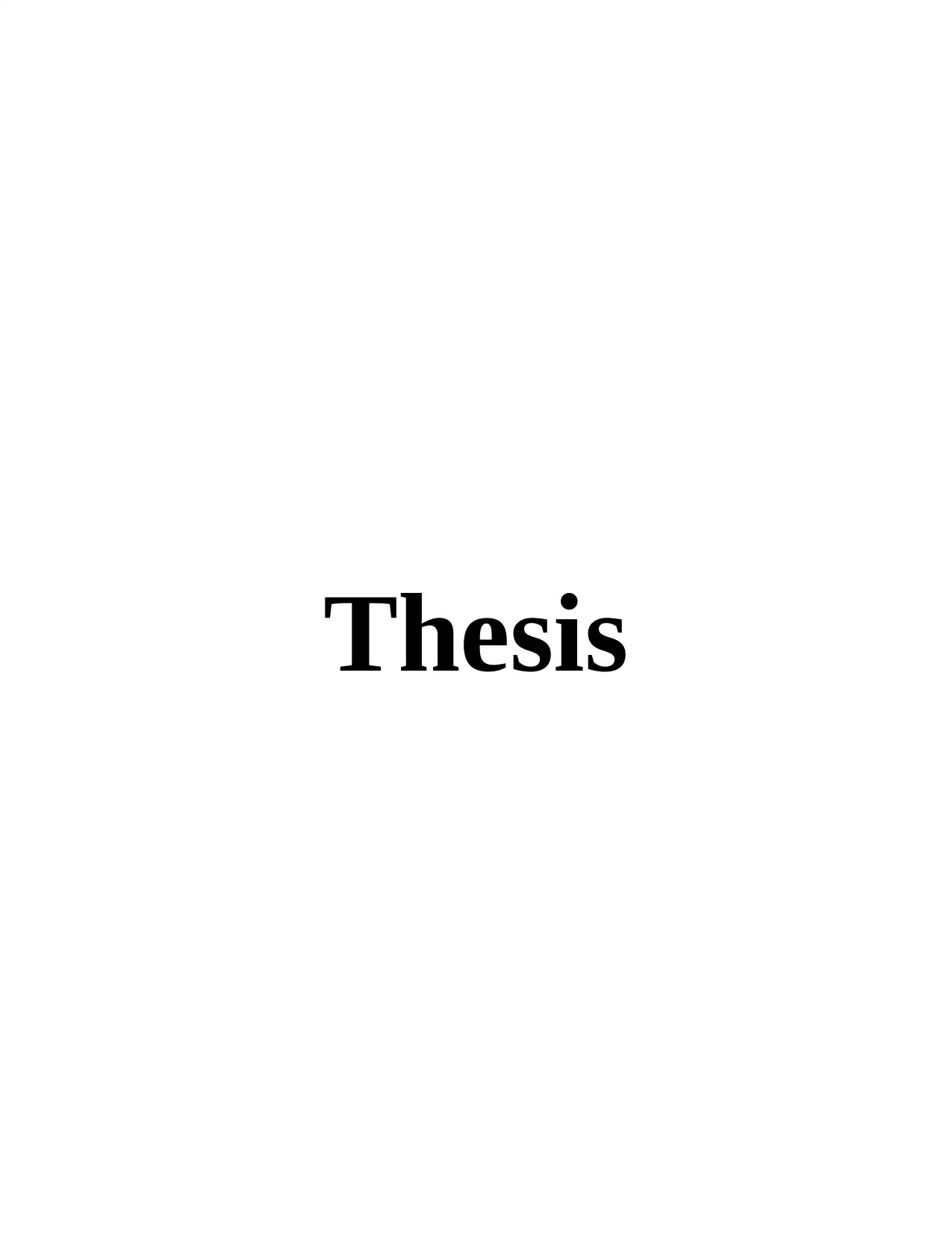
Thesis
Secure Best Marks with AI Grader
Need help grading? Try our AI Grader for instant feedback on your assignments.
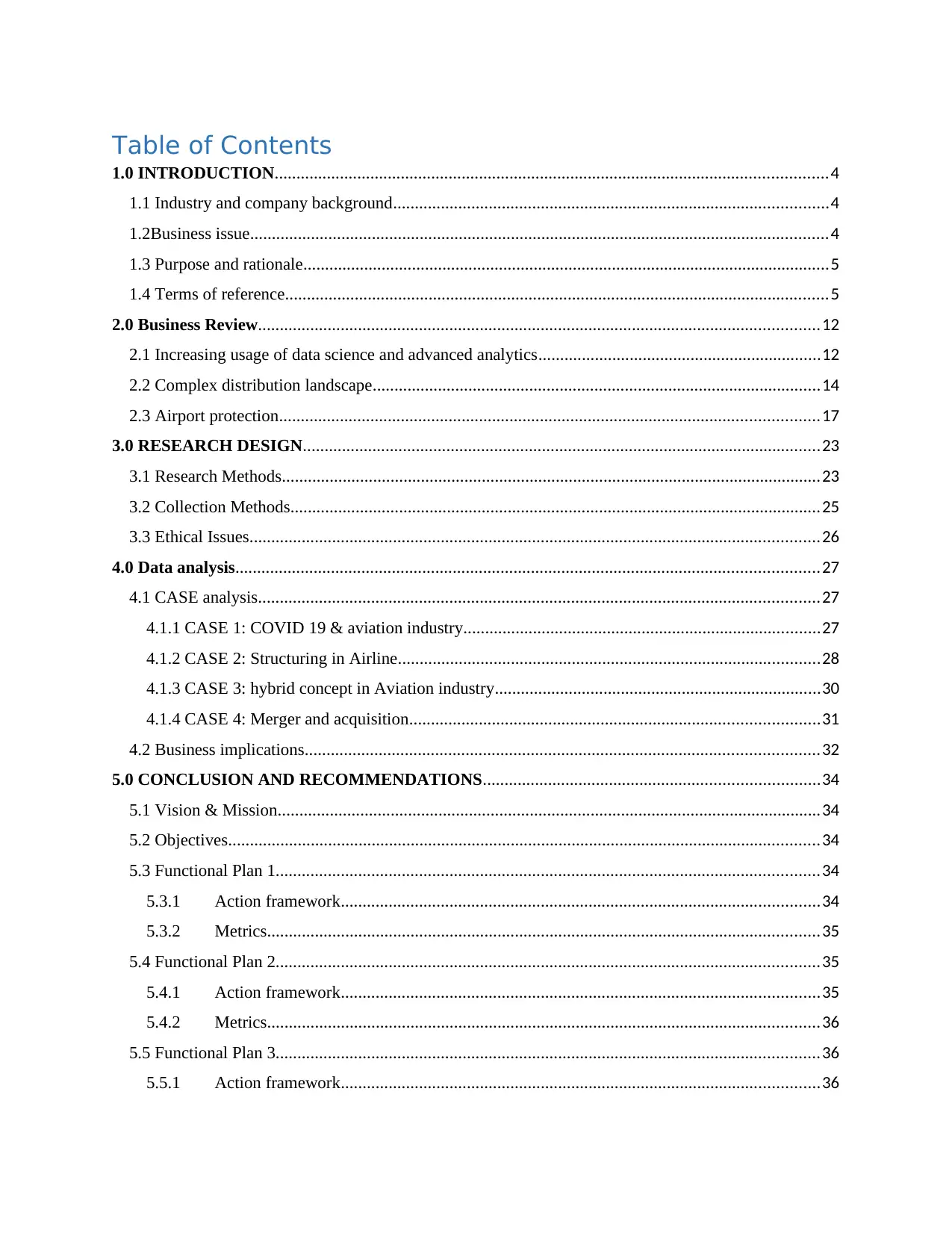
Table of Contents
1.0 INTRODUCTION...............................................................................................................................4
1.1 Industry and company background....................................................................................................4
1.2Business issue.....................................................................................................................................4
1.3 Purpose and rationale.........................................................................................................................5
1.4 Terms of reference.............................................................................................................................5
2.0 Business Review.................................................................................................................................12
2.1 Increasing usage of data science and advanced analytics.................................................................12
2.2 Complex distribution landscape.......................................................................................................14
2.3 Airport protection............................................................................................................................17
3.0 RESEARCH DESIGN.......................................................................................................................23
3.1 Research Methods............................................................................................................................23
3.2 Collection Methods..........................................................................................................................25
3.3 Ethical Issues...................................................................................................................................26
4.0 Data analysis......................................................................................................................................27
4.1 CASE analysis.................................................................................................................................27
4.1.1 CASE 1: COVID 19 & aviation industry..................................................................................27
4.1.2 CASE 2: Structuring in Airline.................................................................................................28
4.1.3 CASE 3: hybrid concept in Aviation industry...........................................................................30
4.1.4 CASE 4: Merger and acquisition..............................................................................................31
4.2 Business implications......................................................................................................................32
5.0 CONCLUSION AND RECOMMENDATIONS.............................................................................34
5.1 Vision & Mission.............................................................................................................................34
5.2 Objectives........................................................................................................................................34
5.3 Functional Plan 1.............................................................................................................................34
5.3.1 Action framework..............................................................................................................34
5.3.2 Metrics...............................................................................................................................35
5.4 Functional Plan 2.............................................................................................................................35
5.4.1 Action framework..............................................................................................................35
5.4.2 Metrics...............................................................................................................................36
5.5 Functional Plan 3.............................................................................................................................36
5.5.1 Action framework..............................................................................................................36
1.0 INTRODUCTION...............................................................................................................................4
1.1 Industry and company background....................................................................................................4
1.2Business issue.....................................................................................................................................4
1.3 Purpose and rationale.........................................................................................................................5
1.4 Terms of reference.............................................................................................................................5
2.0 Business Review.................................................................................................................................12
2.1 Increasing usage of data science and advanced analytics.................................................................12
2.2 Complex distribution landscape.......................................................................................................14
2.3 Airport protection............................................................................................................................17
3.0 RESEARCH DESIGN.......................................................................................................................23
3.1 Research Methods............................................................................................................................23
3.2 Collection Methods..........................................................................................................................25
3.3 Ethical Issues...................................................................................................................................26
4.0 Data analysis......................................................................................................................................27
4.1 CASE analysis.................................................................................................................................27
4.1.1 CASE 1: COVID 19 & aviation industry..................................................................................27
4.1.2 CASE 2: Structuring in Airline.................................................................................................28
4.1.3 CASE 3: hybrid concept in Aviation industry...........................................................................30
4.1.4 CASE 4: Merger and acquisition..............................................................................................31
4.2 Business implications......................................................................................................................32
5.0 CONCLUSION AND RECOMMENDATIONS.............................................................................34
5.1 Vision & Mission.............................................................................................................................34
5.2 Objectives........................................................................................................................................34
5.3 Functional Plan 1.............................................................................................................................34
5.3.1 Action framework..............................................................................................................34
5.3.2 Metrics...............................................................................................................................35
5.4 Functional Plan 2.............................................................................................................................35
5.4.1 Action framework..............................................................................................................35
5.4.2 Metrics...............................................................................................................................36
5.5 Functional Plan 3.............................................................................................................................36
5.5.1 Action framework..............................................................................................................36
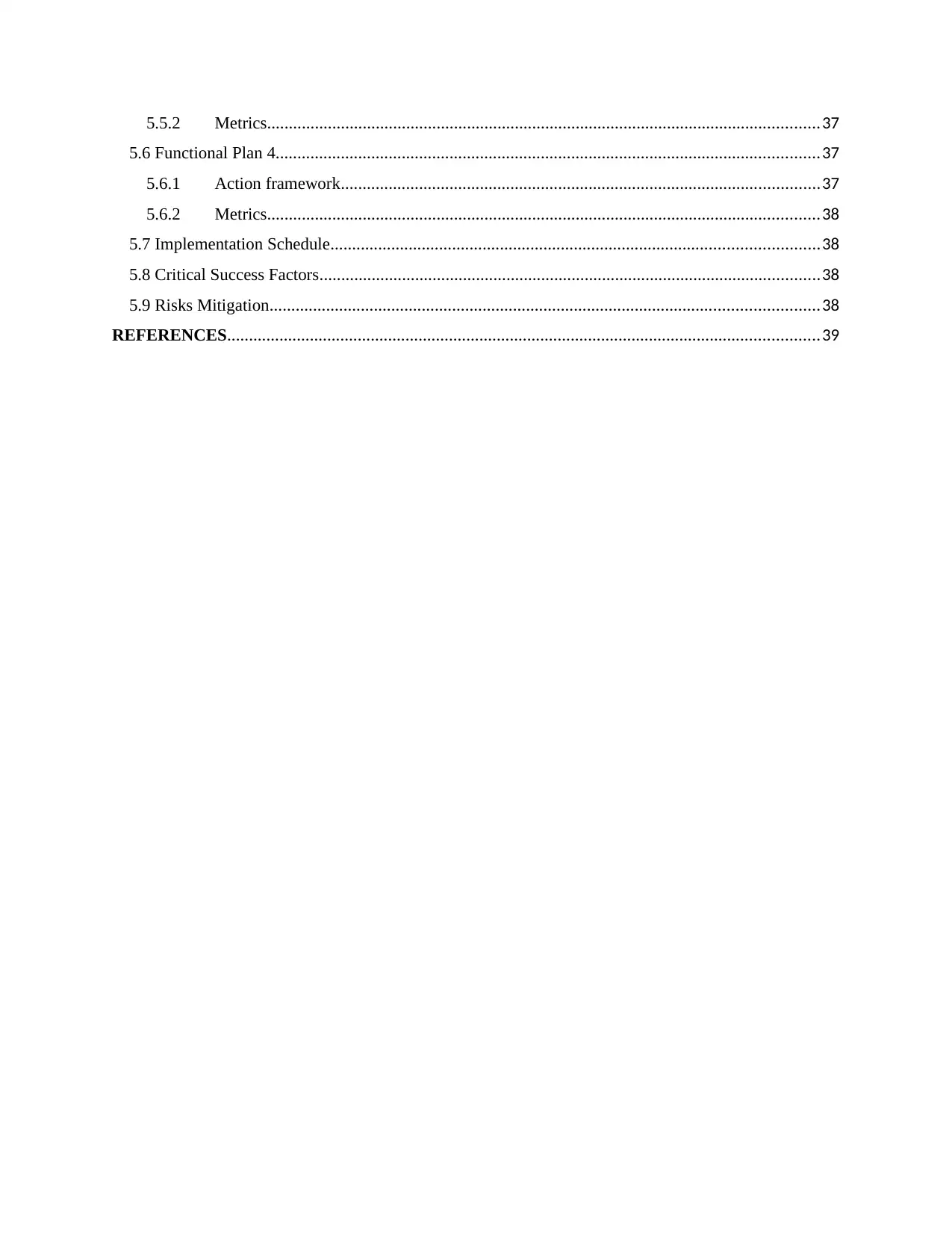
5.5.2 Metrics...............................................................................................................................37
5.6 Functional Plan 4.............................................................................................................................37
5.6.1 Action framework..............................................................................................................37
5.6.2 Metrics...............................................................................................................................38
5.7 Implementation Schedule................................................................................................................38
5.8 Critical Success Factors...................................................................................................................38
5.9 Risks Mitigation..............................................................................................................................38
REFERENCES........................................................................................................................................39
5.6 Functional Plan 4.............................................................................................................................37
5.6.1 Action framework..............................................................................................................37
5.6.2 Metrics...............................................................................................................................38
5.7 Implementation Schedule................................................................................................................38
5.8 Critical Success Factors...................................................................................................................38
5.9 Risks Mitigation..............................................................................................................................38
REFERENCES........................................................................................................................................39
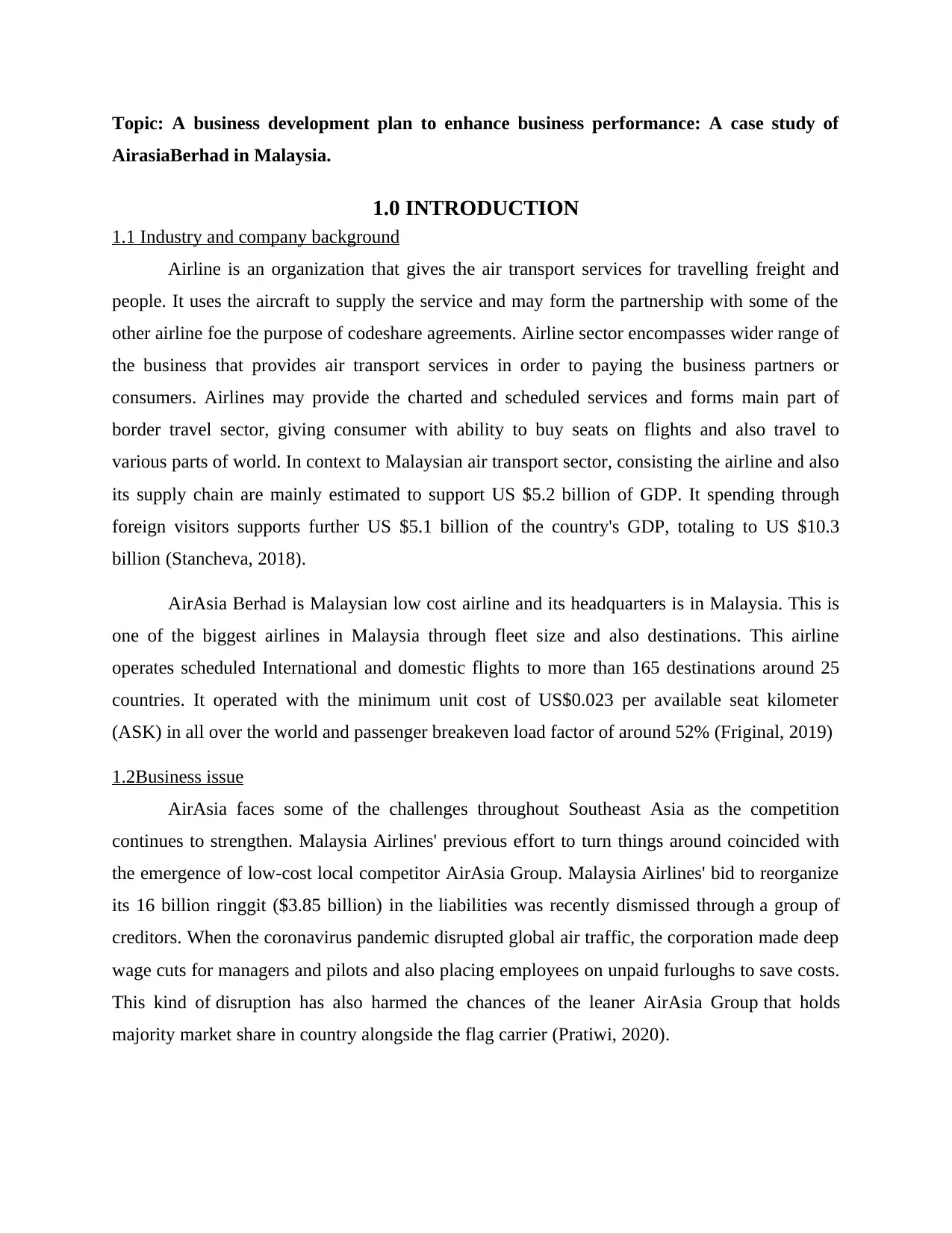
Topic: A business development plan to enhance business performance: A case study of
AirasiaBerhad in Malaysia.
1.0 INTRODUCTION
1.1 Industry and company background
Airline is an organization that gives the air transport services for travelling freight and
people. It uses the aircraft to supply the service and may form the partnership with some of the
other airline foe the purpose of codeshare agreements. Airline sector encompasses wider range of
the business that provides air transport services in order to paying the business partners or
consumers. Airlines may provide the charted and scheduled services and forms main part of
border travel sector, giving consumer with ability to buy seats on flights and also travel to
various parts of world. In context to Malaysian air transport sector, consisting the airline and also
its supply chain are mainly estimated to support US $5.2 billion of GDP. It spending through
foreign visitors supports further US $5.1 billion of the country's GDP, totaling to US $10.3
billion (Stancheva, 2018).
AirAsia Berhad is Malaysian low cost airline and its headquarters is in Malaysia. This is
one of the biggest airlines in Malaysia through fleet size and also destinations. This airline
operates scheduled International and domestic flights to more than 165 destinations around 25
countries. It operated with the minimum unit cost of US$0.023 per available seat kilometer
(ASK) in all over the world and passenger breakeven load factor of around 52% (Friginal, 2019)
1.2Business issue
AirAsia faces some of the challenges throughout Southeast Asia as the competition
continues to strengthen. Malaysia Airlines' previous effort to turn things around coincided with
the emergence of low-cost local competitor AirAsia Group. Malaysia Airlines' bid to reorganize
its 16 billion ringgit ($3.85 billion) in the liabilities was recently dismissed through a group of
creditors. When the coronavirus pandemic disrupted global air traffic, the corporation made deep
wage cuts for managers and pilots and also placing employees on unpaid furloughs to save costs.
This kind of disruption has also harmed the chances of the leaner AirAsia Group that holds
majority market share in country alongside the flag carrier (Pratiwi, 2020).
AirasiaBerhad in Malaysia.
1.0 INTRODUCTION
1.1 Industry and company background
Airline is an organization that gives the air transport services for travelling freight and
people. It uses the aircraft to supply the service and may form the partnership with some of the
other airline foe the purpose of codeshare agreements. Airline sector encompasses wider range of
the business that provides air transport services in order to paying the business partners or
consumers. Airlines may provide the charted and scheduled services and forms main part of
border travel sector, giving consumer with ability to buy seats on flights and also travel to
various parts of world. In context to Malaysian air transport sector, consisting the airline and also
its supply chain are mainly estimated to support US $5.2 billion of GDP. It spending through
foreign visitors supports further US $5.1 billion of the country's GDP, totaling to US $10.3
billion (Stancheva, 2018).
AirAsia Berhad is Malaysian low cost airline and its headquarters is in Malaysia. This is
one of the biggest airlines in Malaysia through fleet size and also destinations. This airline
operates scheduled International and domestic flights to more than 165 destinations around 25
countries. It operated with the minimum unit cost of US$0.023 per available seat kilometer
(ASK) in all over the world and passenger breakeven load factor of around 52% (Friginal, 2019)
1.2Business issue
AirAsia faces some of the challenges throughout Southeast Asia as the competition
continues to strengthen. Malaysia Airlines' previous effort to turn things around coincided with
the emergence of low-cost local competitor AirAsia Group. Malaysia Airlines' bid to reorganize
its 16 billion ringgit ($3.85 billion) in the liabilities was recently dismissed through a group of
creditors. When the coronavirus pandemic disrupted global air traffic, the corporation made deep
wage cuts for managers and pilots and also placing employees on unpaid furloughs to save costs.
This kind of disruption has also harmed the chances of the leaner AirAsia Group that holds
majority market share in country alongside the flag carrier (Pratiwi, 2020).
Secure Best Marks with AI Grader
Need help grading? Try our AI Grader for instant feedback on your assignments.
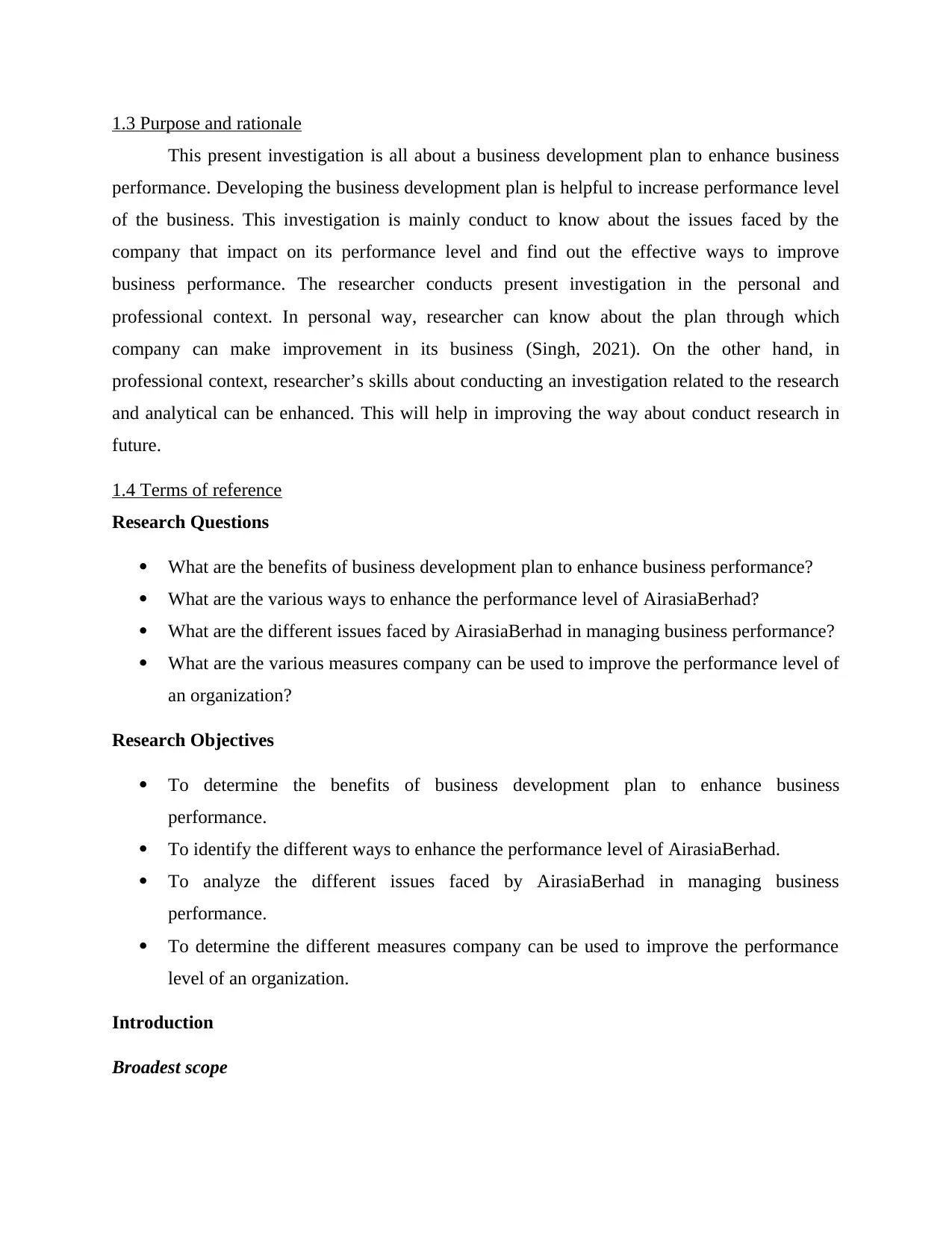
1.3 Purpose and rationale
This present investigation is all about a business development plan to enhance business
performance. Developing the business development plan is helpful to increase performance level
of the business. This investigation is mainly conduct to know about the issues faced by the
company that impact on its performance level and find out the effective ways to improve
business performance. The researcher conducts present investigation in the personal and
professional context. In personal way, researcher can know about the plan through which
company can make improvement in its business (Singh, 2021). On the other hand, in
professional context, researcher’s skills about conducting an investigation related to the research
and analytical can be enhanced. This will help in improving the way about conduct research in
future.
1.4 Terms of reference
Research Questions
What are the benefits of business development plan to enhance business performance?
What are the various ways to enhance the performance level of AirasiaBerhad?
What are the different issues faced by AirasiaBerhad in managing business performance?
What are the various measures company can be used to improve the performance level of
an organization?
Research Objectives
To determine the benefits of business development plan to enhance business
performance.
To identify the different ways to enhance the performance level of AirasiaBerhad.
To analyze the different issues faced by AirasiaBerhad in managing business
performance.
To determine the different measures company can be used to improve the performance
level of an organization.
Introduction
Broadest scope
This present investigation is all about a business development plan to enhance business
performance. Developing the business development plan is helpful to increase performance level
of the business. This investigation is mainly conduct to know about the issues faced by the
company that impact on its performance level and find out the effective ways to improve
business performance. The researcher conducts present investigation in the personal and
professional context. In personal way, researcher can know about the plan through which
company can make improvement in its business (Singh, 2021). On the other hand, in
professional context, researcher’s skills about conducting an investigation related to the research
and analytical can be enhanced. This will help in improving the way about conduct research in
future.
1.4 Terms of reference
Research Questions
What are the benefits of business development plan to enhance business performance?
What are the various ways to enhance the performance level of AirasiaBerhad?
What are the different issues faced by AirasiaBerhad in managing business performance?
What are the various measures company can be used to improve the performance level of
an organization?
Research Objectives
To determine the benefits of business development plan to enhance business
performance.
To identify the different ways to enhance the performance level of AirasiaBerhad.
To analyze the different issues faced by AirasiaBerhad in managing business
performance.
To determine the different measures company can be used to improve the performance
level of an organization.
Introduction
Broadest scope
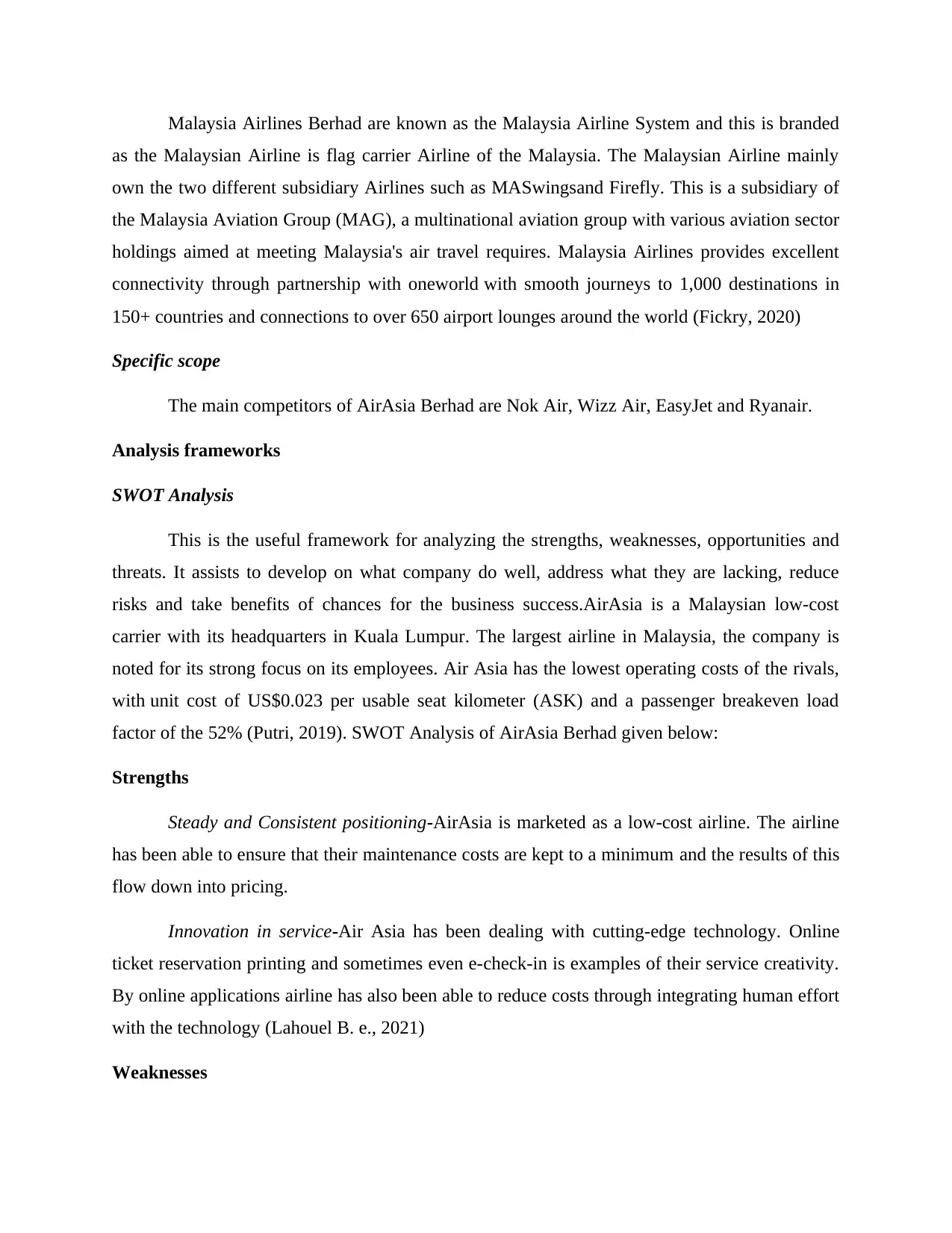
Malaysia Airlines Berhad are known as the Malaysia Airline System and this is branded
as the Malaysian Airline is flag carrier Airline of the Malaysia. The Malaysian Airline mainly
own the two different subsidiary Airlines such as MASwingsand Firefly. This is a subsidiary of
the Malaysia Aviation Group (MAG), a multinational aviation group with various aviation sector
holdings aimed at meeting Malaysia's air travel requires. Malaysia Airlines provides excellent
connectivity through partnership with oneworld with smooth journeys to 1,000 destinations in
150+ countries and connections to over 650 airport lounges around the world (Fickry, 2020)
Specific scope
The main competitors of AirAsia Berhad are Nok Air, Wizz Air, EasyJet and Ryanair.
Analysis frameworks
SWOT Analysis
This is the useful framework for analyzing the strengths, weaknesses, opportunities and
threats. It assists to develop on what company do well, address what they are lacking, reduce
risks and take benefits of chances for the business success.AirAsia is a Malaysian low-cost
carrier with its headquarters in Kuala Lumpur. The largest airline in Malaysia, the company is
noted for its strong focus on its employees. Air Asia has the lowest operating costs of the rivals,
with unit cost of US$0.023 per usable seat kilometer (ASK) and a passenger breakeven load
factor of the 52% (Putri, 2019). SWOT Analysis of AirAsia Berhad given below:
Strengths
Steady and Consistent positioning-AirAsia is marketed as a low-cost airline. The airline
has been able to ensure that their maintenance costs are kept to a minimum and the results of this
flow down into pricing.
Innovation in service-Air Asia has been dealing with cutting-edge technology. Online
ticket reservation printing and sometimes even e-check-in is examples of their service creativity.
By online applications airline has also been able to reduce costs through integrating human effort
with the technology (Lahouel B. e., 2021)
Weaknesses
as the Malaysian Airline is flag carrier Airline of the Malaysia. The Malaysian Airline mainly
own the two different subsidiary Airlines such as MASwingsand Firefly. This is a subsidiary of
the Malaysia Aviation Group (MAG), a multinational aviation group with various aviation sector
holdings aimed at meeting Malaysia's air travel requires. Malaysia Airlines provides excellent
connectivity through partnership with oneworld with smooth journeys to 1,000 destinations in
150+ countries and connections to over 650 airport lounges around the world (Fickry, 2020)
Specific scope
The main competitors of AirAsia Berhad are Nok Air, Wizz Air, EasyJet and Ryanair.
Analysis frameworks
SWOT Analysis
This is the useful framework for analyzing the strengths, weaknesses, opportunities and
threats. It assists to develop on what company do well, address what they are lacking, reduce
risks and take benefits of chances for the business success.AirAsia is a Malaysian low-cost
carrier with its headquarters in Kuala Lumpur. The largest airline in Malaysia, the company is
noted for its strong focus on its employees. Air Asia has the lowest operating costs of the rivals,
with unit cost of US$0.023 per usable seat kilometer (ASK) and a passenger breakeven load
factor of the 52% (Putri, 2019). SWOT Analysis of AirAsia Berhad given below:
Strengths
Steady and Consistent positioning-AirAsia is marketed as a low-cost airline. The airline
has been able to ensure that their maintenance costs are kept to a minimum and the results of this
flow down into pricing.
Innovation in service-Air Asia has been dealing with cutting-edge technology. Online
ticket reservation printing and sometimes even e-check-in is examples of their service creativity.
By online applications airline has also been able to reduce costs through integrating human effort
with the technology (Lahouel B. e., 2021)
Weaknesses
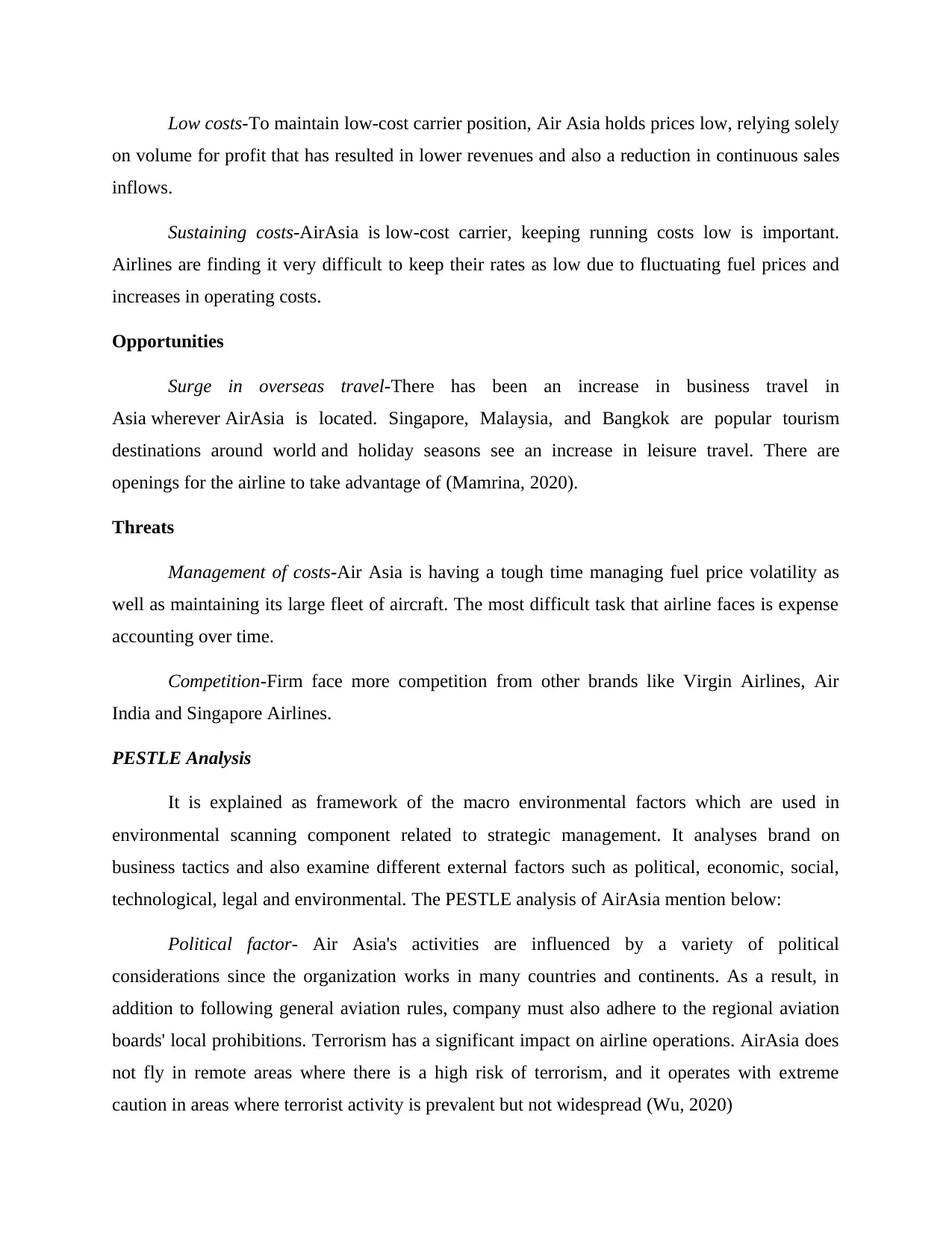
Low costs-To maintain low-cost carrier position, Air Asia holds prices low, relying solely
on volume for profit that has resulted in lower revenues and also a reduction in continuous sales
inflows.
Sustaining costs-AirAsia is low-cost carrier, keeping running costs low is important.
Airlines are finding it very difficult to keep their rates as low due to fluctuating fuel prices and
increases in operating costs.
Opportunities
Surge in overseas travel-There has been an increase in business travel in
Asia wherever AirAsia is located. Singapore, Malaysia, and Bangkok are popular tourism
destinations around world and holiday seasons see an increase in leisure travel. There are
openings for the airline to take advantage of (Mamrina, 2020).
Threats
Management of costs-Air Asia is having a tough time managing fuel price volatility as
well as maintaining its large fleet of aircraft. The most difficult task that airline faces is expense
accounting over time.
Competition-Firm face more competition from other brands like Virgin Airlines, Air
India and Singapore Airlines.
PESTLE Analysis
It is explained as framework of the macro environmental factors which are used in
environmental scanning component related to strategic management. It analyses brand on
business tactics and also examine different external factors such as political, economic, social,
technological, legal and environmental. The PESTLE analysis of AirAsia mention below:
Political factor- Air Asia's activities are influenced by a variety of political
considerations since the organization works in many countries and continents. As a result, in
addition to following general aviation rules, company must also adhere to the regional aviation
boards' local prohibitions. Terrorism has a significant impact on airline operations. AirAsia does
not fly in remote areas where there is a high risk of terrorism, and it operates with extreme
caution in areas where terrorist activity is prevalent but not widespread (Wu, 2020)
on volume for profit that has resulted in lower revenues and also a reduction in continuous sales
inflows.
Sustaining costs-AirAsia is low-cost carrier, keeping running costs low is important.
Airlines are finding it very difficult to keep their rates as low due to fluctuating fuel prices and
increases in operating costs.
Opportunities
Surge in overseas travel-There has been an increase in business travel in
Asia wherever AirAsia is located. Singapore, Malaysia, and Bangkok are popular tourism
destinations around world and holiday seasons see an increase in leisure travel. There are
openings for the airline to take advantage of (Mamrina, 2020).
Threats
Management of costs-Air Asia is having a tough time managing fuel price volatility as
well as maintaining its large fleet of aircraft. The most difficult task that airline faces is expense
accounting over time.
Competition-Firm face more competition from other brands like Virgin Airlines, Air
India and Singapore Airlines.
PESTLE Analysis
It is explained as framework of the macro environmental factors which are used in
environmental scanning component related to strategic management. It analyses brand on
business tactics and also examine different external factors such as political, economic, social,
technological, legal and environmental. The PESTLE analysis of AirAsia mention below:
Political factor- Air Asia's activities are influenced by a variety of political
considerations since the organization works in many countries and continents. As a result, in
addition to following general aviation rules, company must also adhere to the regional aviation
boards' local prohibitions. Terrorism has a significant impact on airline operations. AirAsia does
not fly in remote areas where there is a high risk of terrorism, and it operates with extreme
caution in areas where terrorist activity is prevalent but not widespread (Wu, 2020)
Paraphrase This Document
Need a fresh take? Get an instant paraphrase of this document with our AI Paraphraser

Economic factor-The GDP per capita income of Asia-Pacific countries has been steadily
increasing, indicating a growing buying power (2014). As a result of this economic development,
AirAsia is now able to sell tickets to middle-income earners at a reasonable price.Consumers and
other low incomes have been able to benefit from AirAsia's lowered air fare prices.
Social factor-The standard of airline services is more important to Asian passengers than
the expense. Passengers want flights to follow such service requirements. In addition, the
growing number of local and international tourists in the Asia-Pacific region supports AirAsia's
expansion.
Technological factor-Within Asia-Pacific zone, public transportation, domestic
airports and international airports all prove to be challenging. Like, almost every state in
Malaysia has an airport and larger cities can have both domestic and international terminals. The
widespread availability of internet facilities in Malaysia has made this simple to buy air tickets
through the internet that is both cost-effective and easy (Virappan, 2020).
Legal factor-The widespread market liberalization in Asia has provided AirAsia with
tremendous growth opportunities. However, same liberalization has generated more regulatory
concerns for carrier, as they must comply with all legal obligations and regulations in order to
conduct domestic and foreign business activities.
Environmental factor-Airlines are a significant source of air pollution and should be
subject to strict environmental regulations. AirAsia has put in place policies to protect the
environment from any kind of negative pollution that could arise as result of its activities.
McKinsey 7S
This framework is management model that developed through Robert H. Waterman,Jr.
and Tom Peters in year 1980. It was strategic vision for the groups, include businesses, teams
and business units.
Strategy-This is related to organization for developing as well as maintaining competitive
benefits over its rivals. AirAsia has sparked revolution in the air travel with more people around
region selecting AirAsia as preferred choice regarding air transport (Aprilia, (2020).).
increasing, indicating a growing buying power (2014). As a result of this economic development,
AirAsia is now able to sell tickets to middle-income earners at a reasonable price.Consumers and
other low incomes have been able to benefit from AirAsia's lowered air fare prices.
Social factor-The standard of airline services is more important to Asian passengers than
the expense. Passengers want flights to follow such service requirements. In addition, the
growing number of local and international tourists in the Asia-Pacific region supports AirAsia's
expansion.
Technological factor-Within Asia-Pacific zone, public transportation, domestic
airports and international airports all prove to be challenging. Like, almost every state in
Malaysia has an airport and larger cities can have both domestic and international terminals. The
widespread availability of internet facilities in Malaysia has made this simple to buy air tickets
through the internet that is both cost-effective and easy (Virappan, 2020).
Legal factor-The widespread market liberalization in Asia has provided AirAsia with
tremendous growth opportunities. However, same liberalization has generated more regulatory
concerns for carrier, as they must comply with all legal obligations and regulations in order to
conduct domestic and foreign business activities.
Environmental factor-Airlines are a significant source of air pollution and should be
subject to strict environmental regulations. AirAsia has put in place policies to protect the
environment from any kind of negative pollution that could arise as result of its activities.
McKinsey 7S
This framework is management model that developed through Robert H. Waterman,Jr.
and Tom Peters in year 1980. It was strategic vision for the groups, include businesses, teams
and business units.
Strategy-This is related to organization for developing as well as maintaining competitive
benefits over its rivals. AirAsia has sparked revolution in the air travel with more people around
region selecting AirAsia as preferred choice regarding air transport (Aprilia, (2020).).

Structure-Together with business partner, Tony Fernandes has been developed the
AirAsia since 2001. It consists extensive network across Australia and Asia. Affiliated airlines of
the AirAsia consists AirAsia Bernard, AirAsia Japan, Philippines AirAsia and ThaiAirAsia.
Systems-AirAsia has make use of the internet technology for operational as well as
strategic management. It gives online booking services to the traveler online.
Shared values-For AirAsia Company, employees will come first and then customers. If
the employees are happy then they will look after consumers. this company allowed its staff
members to express themselves to perform in a better manner.
Style-Many leader of AirAsia had own social media account that consists Instagram and
Twitter. It enables the public to interact them easily and this will help leader to receive the
comments about receiving services faster.
Staff –AirAsia company do have limited human resources and its staff members have
many roles to save on the cost. This company provides the training to its staff members so that
they can give the better services to its consumers (Kasinathan, 2020).
Skills-AirAsia identified to become better firm to work whereby staff members are
treated as part of big family, to accomplish minimum cost so that each one can fly withAirAsia,
develop globally identified the ASEANbrand and maintain better quality product.
Feasibility factors
Marketing feasibility-It determines depth as well as condition of specific state of market
and ability to support specific development. AirAsia Bernard company provide its services at the
low cost to people so that each one can travel.
Operational feasibility-Operational feasibility is measure for how well the proposed
solution addresses challenges and exploits opportunities found throughout scope definition and it
meets the specifications identified during in requirements review process of system creation.
Technical feasibility-A technological feasibility looks at the specifics about offer product
or service to consumers. AirAsia company provide the online services to its consumers so that
they can make their reservations and also book tickets through online. This is helpful for them in
time saving as well as cost saving (Eng, 2019).
AirAsia since 2001. It consists extensive network across Australia and Asia. Affiliated airlines of
the AirAsia consists AirAsia Bernard, AirAsia Japan, Philippines AirAsia and ThaiAirAsia.
Systems-AirAsia has make use of the internet technology for operational as well as
strategic management. It gives online booking services to the traveler online.
Shared values-For AirAsia Company, employees will come first and then customers. If
the employees are happy then they will look after consumers. this company allowed its staff
members to express themselves to perform in a better manner.
Style-Many leader of AirAsia had own social media account that consists Instagram and
Twitter. It enables the public to interact them easily and this will help leader to receive the
comments about receiving services faster.
Staff –AirAsia company do have limited human resources and its staff members have
many roles to save on the cost. This company provides the training to its staff members so that
they can give the better services to its consumers (Kasinathan, 2020).
Skills-AirAsia identified to become better firm to work whereby staff members are
treated as part of big family, to accomplish minimum cost so that each one can fly withAirAsia,
develop globally identified the ASEANbrand and maintain better quality product.
Feasibility factors
Marketing feasibility-It determines depth as well as condition of specific state of market
and ability to support specific development. AirAsia Bernard company provide its services at the
low cost to people so that each one can travel.
Operational feasibility-Operational feasibility is measure for how well the proposed
solution addresses challenges and exploits opportunities found throughout scope definition and it
meets the specifications identified during in requirements review process of system creation.
Technical feasibility-A technological feasibility looks at the specifics about offer product
or service to consumers. AirAsia company provide the online services to its consumers so that
they can make their reservations and also book tickets through online. This is helpful for them in
time saving as well as cost saving (Eng, 2019).
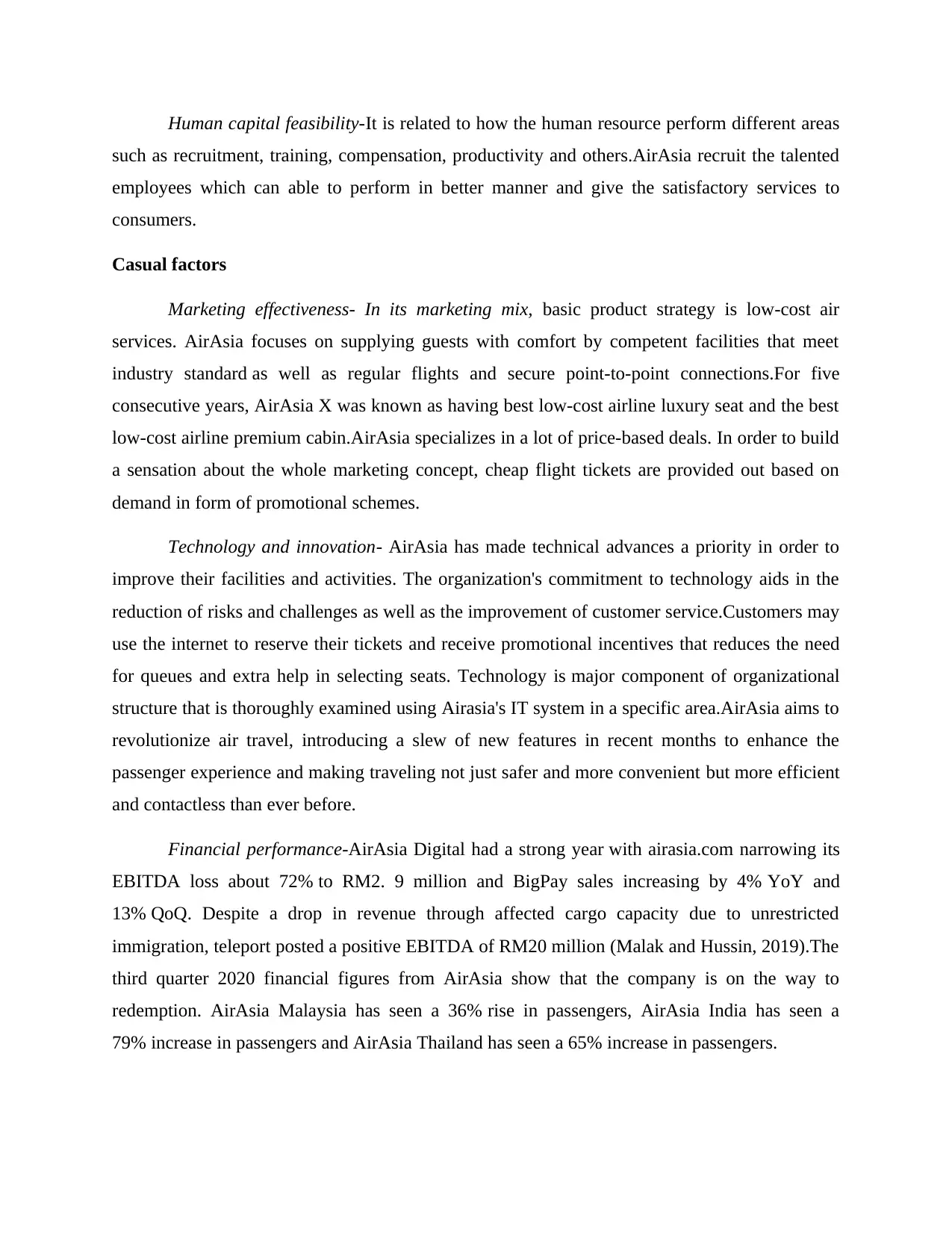
Human capital feasibility-It is related to how the human resource perform different areas
such as recruitment, training, compensation, productivity and others.AirAsia recruit the talented
employees which can able to perform in better manner and give the satisfactory services to
consumers.
Casual factors
Marketing effectiveness- In its marketing mix, basic product strategy is low-cost air
services. AirAsia focuses on supplying guests with comfort by competent facilities that meet
industry standard as well as regular flights and secure point-to-point connections.For five
consecutive years, AirAsia X was known as having best low-cost airline luxury seat and the best
low-cost airline premium cabin.AirAsia specializes in a lot of price-based deals. In order to build
a sensation about the whole marketing concept, cheap flight tickets are provided out based on
demand in form of promotional schemes.
Technology and innovation- AirAsia has made technical advances a priority in order to
improve their facilities and activities. The organization's commitment to technology aids in the
reduction of risks and challenges as well as the improvement of customer service.Customers may
use the internet to reserve their tickets and receive promotional incentives that reduces the need
for queues and extra help in selecting seats. Technology is major component of organizational
structure that is thoroughly examined using Airasia's IT system in a specific area.AirAsia aims to
revolutionize air travel, introducing a slew of new features in recent months to enhance the
passenger experience and making traveling not just safer and more convenient but more efficient
and contactless than ever before.
Financial performance-AirAsia Digital had a strong year with airasia.com narrowing its
EBITDA loss about 72% to RM2. 9 million and BigPay sales increasing by 4% YoY and
13% QoQ. Despite a drop in revenue through affected cargo capacity due to unrestricted
immigration, teleport posted a positive EBITDA of RM20 million (Malak and Hussin, 2019).The
third quarter 2020 financial figures from AirAsia show that the company is on the way to
redemption. AirAsia Malaysia has seen a 36% rise in passengers, AirAsia India has seen a
79% increase in passengers and AirAsia Thailand has seen a 65% increase in passengers.
such as recruitment, training, compensation, productivity and others.AirAsia recruit the talented
employees which can able to perform in better manner and give the satisfactory services to
consumers.
Casual factors
Marketing effectiveness- In its marketing mix, basic product strategy is low-cost air
services. AirAsia focuses on supplying guests with comfort by competent facilities that meet
industry standard as well as regular flights and secure point-to-point connections.For five
consecutive years, AirAsia X was known as having best low-cost airline luxury seat and the best
low-cost airline premium cabin.AirAsia specializes in a lot of price-based deals. In order to build
a sensation about the whole marketing concept, cheap flight tickets are provided out based on
demand in form of promotional schemes.
Technology and innovation- AirAsia has made technical advances a priority in order to
improve their facilities and activities. The organization's commitment to technology aids in the
reduction of risks and challenges as well as the improvement of customer service.Customers may
use the internet to reserve their tickets and receive promotional incentives that reduces the need
for queues and extra help in selecting seats. Technology is major component of organizational
structure that is thoroughly examined using Airasia's IT system in a specific area.AirAsia aims to
revolutionize air travel, introducing a slew of new features in recent months to enhance the
passenger experience and making traveling not just safer and more convenient but more efficient
and contactless than ever before.
Financial performance-AirAsia Digital had a strong year with airasia.com narrowing its
EBITDA loss about 72% to RM2. 9 million and BigPay sales increasing by 4% YoY and
13% QoQ. Despite a drop in revenue through affected cargo capacity due to unrestricted
immigration, teleport posted a positive EBITDA of RM20 million (Malak and Hussin, 2019).The
third quarter 2020 financial figures from AirAsia show that the company is on the way to
redemption. AirAsia Malaysia has seen a 36% rise in passengers, AirAsia India has seen a
79% increase in passengers and AirAsia Thailand has seen a 65% increase in passengers.
Secure Best Marks with AI Grader
Need help grading? Try our AI Grader for instant feedback on your assignments.
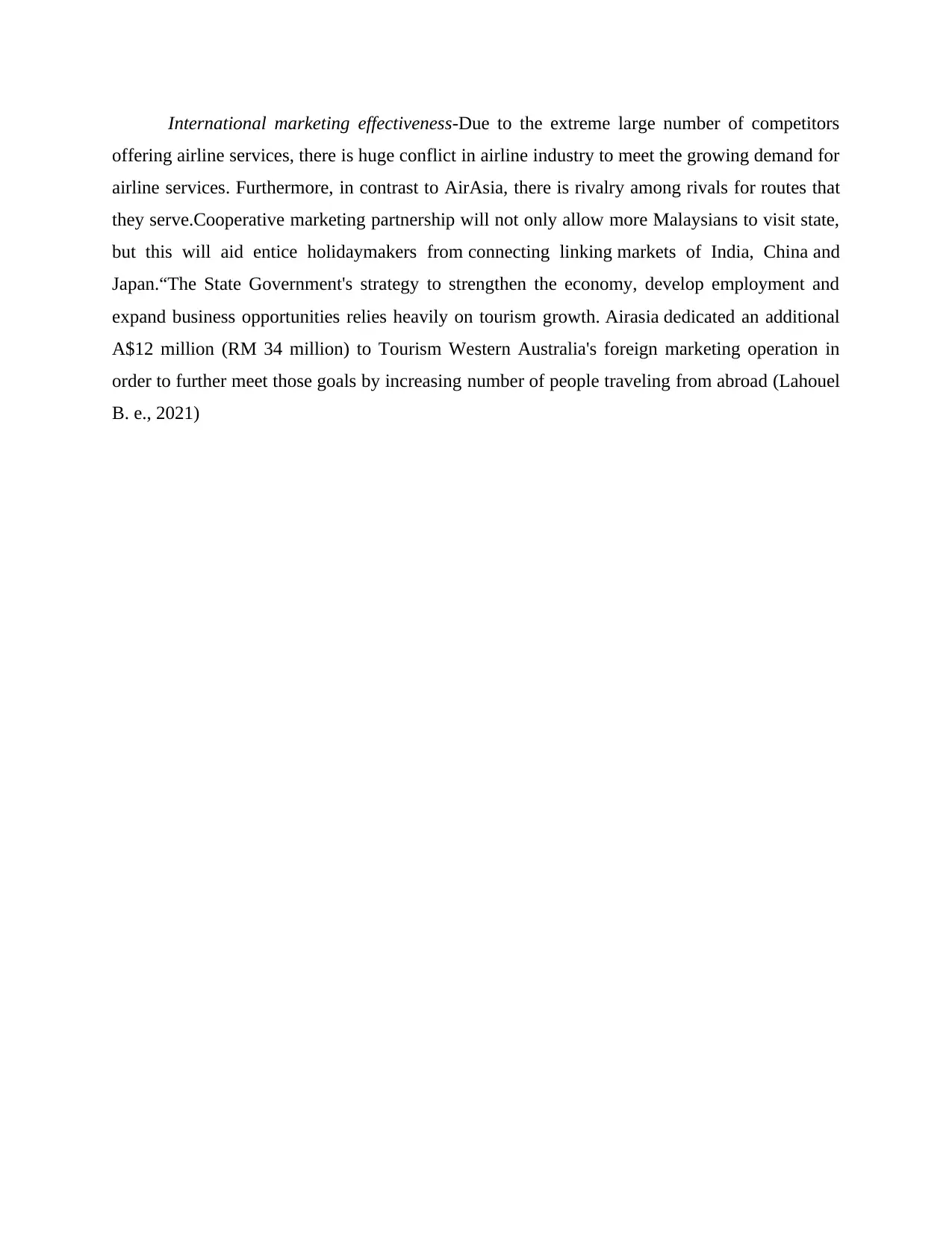
International marketing effectiveness-Due to the extreme large number of competitors
offering airline services, there is huge conflict in airline industry to meet the growing demand for
airline services. Furthermore, in contrast to AirAsia, there is rivalry among rivals for routes that
they serve.Cooperative marketing partnership will not only allow more Malaysians to visit state,
but this will aid entice holidaymakers from connecting linking markets of India, China and
Japan.“The State Government's strategy to strengthen the economy, develop employment and
expand business opportunities relies heavily on tourism growth. Airasia dedicated an additional
A$12 million (RM 34 million) to Tourism Western Australia's foreign marketing operation in
order to further meet those goals by increasing number of people traveling from abroad (Lahouel
B. e., 2021)
offering airline services, there is huge conflict in airline industry to meet the growing demand for
airline services. Furthermore, in contrast to AirAsia, there is rivalry among rivals for routes that
they serve.Cooperative marketing partnership will not only allow more Malaysians to visit state,
but this will aid entice holidaymakers from connecting linking markets of India, China and
Japan.“The State Government's strategy to strengthen the economy, develop employment and
expand business opportunities relies heavily on tourism growth. Airasia dedicated an additional
A$12 million (RM 34 million) to Tourism Western Australia's foreign marketing operation in
order to further meet those goals by increasing number of people traveling from abroad (Lahouel
B. e., 2021)

2.0 Business Review
2.1 Increasing usage of data science and advanced analytics
Aviation industry is facing a rise in usage of data science and advanced analytics similar
to other business sectors in the present data driven age. The rise in usage of data science and data
analytics is contributed to the increasing usefulness of data science in improving consumer
journey in the aviation industry. Data science and analytics can be used to send personalized
marketing messages to consumers at the beginning of their journey. Revenue management
algorithms can be used to provide personalized pricing offers to the consumer to persuade them
into shopping with the company. In addition to these data analytics can solve the problem of
consumer dissatisfaction caused by travel disruption. AI can be used to offer consumers the next
best option swiftly in case of travel disruption due to external factors such as weather (Sardjono,
2019).
With the use of AI airline firms can conduct landing and departing activities such as
flight transfer or hotel booking automatically. Huge scope of data science and advanced analytics
in the aviation industry is the primary reason for increasing usage. This multifunctional factor
affects various operations of the aviation industry. Businesses operating in the airline sector can
use data analytics to enhance consumer journey and increase consumer satisfaction. Sentiment
analysis, predictive analysis and travel journey analysis are some of the primary data analysis
tools used in the Aviation sector. The increasing consumer centric nature of the airline industry is
also the driving force behind usage of data analytics. This is because data science and advanced
analytics can be used by airline firms to gain consumer insight and understand each consumer
more effectively. This multifunctional factor impacts the core functions of an airline
organization. Data science and advanced analytics are being used in the airline industry to
improve decision making related to fleet and ground operations, maintenance, crew and
passenger needs for each flight on a daily basis. In addition to this usage of data science and
advanced analytics can improve coordination related with various on ground aviation operations.
Vast amount of data available to the airline industry about consumer behavior, air traffic, impact
and changes in weather conditions and other elements of aviation operations can be fed to
algorithm to ensure most effective usage of data science. Aircraft maintenance is another core
activity of the airline firms; this factor is also affected by usage of advanced analytics. Airline
2.1 Increasing usage of data science and advanced analytics
Aviation industry is facing a rise in usage of data science and advanced analytics similar
to other business sectors in the present data driven age. The rise in usage of data science and data
analytics is contributed to the increasing usefulness of data science in improving consumer
journey in the aviation industry. Data science and analytics can be used to send personalized
marketing messages to consumers at the beginning of their journey. Revenue management
algorithms can be used to provide personalized pricing offers to the consumer to persuade them
into shopping with the company. In addition to these data analytics can solve the problem of
consumer dissatisfaction caused by travel disruption. AI can be used to offer consumers the next
best option swiftly in case of travel disruption due to external factors such as weather (Sardjono,
2019).
With the use of AI airline firms can conduct landing and departing activities such as
flight transfer or hotel booking automatically. Huge scope of data science and advanced analytics
in the aviation industry is the primary reason for increasing usage. This multifunctional factor
affects various operations of the aviation industry. Businesses operating in the airline sector can
use data analytics to enhance consumer journey and increase consumer satisfaction. Sentiment
analysis, predictive analysis and travel journey analysis are some of the primary data analysis
tools used in the Aviation sector. The increasing consumer centric nature of the airline industry is
also the driving force behind usage of data analytics. This is because data science and advanced
analytics can be used by airline firms to gain consumer insight and understand each consumer
more effectively. This multifunctional factor impacts the core functions of an airline
organization. Data science and advanced analytics are being used in the airline industry to
improve decision making related to fleet and ground operations, maintenance, crew and
passenger needs for each flight on a daily basis. In addition to this usage of data science and
advanced analytics can improve coordination related with various on ground aviation operations.
Vast amount of data available to the airline industry about consumer behavior, air traffic, impact
and changes in weather conditions and other elements of aviation operations can be fed to
algorithm to ensure most effective usage of data science. Aircraft maintenance is another core
activity of the airline firms; this factor is also affected by usage of advanced analytics. Airline

organizations are shifting from usage of traditional technologies to digitization of core activities
and central functions.
This multifunctional factor has impacted core functions of the airline industry. Advantages and
unpropitious of rise in usage of data science and advanced analytics in context of airline industry
are provided below:
Advantages
Improved aircraft safety: Aircrafts generate huge amount of data. Average six hour
flights are capable of generating 2.5 terabytes data every day. This data is increased in case of
transcontinental flights. Data analytics can be used to asses and scrutinize data generated by
aircraft. Advanced analytics and data science can be helpful in determining reasons behind flight
delays, identify safety risks and provide solutions for improving aircraft safety and performance.
Smart maintenance: Airspace optimization in relation to flight routes, runaway
bandwidth and selection of right type of aircraft are several barriers faced by airline firms due to
increasing air traffic. Data analytics can be used by airline firms to eliminate these barriers and
increase passenger satisfaction. Predictive data analytics can be used to reduce flight
cancellations and delays. In addition to this big data and AI ensures planned maintenance as
aircraft technicians gain access to real time data to find solutions swiftly (Pratiyudha, 2021).
Revenue management: Data science and advanced analytics enable airline firms to
enhance revenue management. The focus on revenue management is to identify the best ways to
sell services to the target consumer. This involves determining the right price, right time and the
most effective channels to communicate with target consumer base. Data analytics allows airline
firms to regulate prices and identify most effective distribution channels. AI can accomplish this
by assessing various factors such as income groups, time of purchase.
Enhance consumer Journey: Airline firms can utilize advance analytics to increase
consumer satisfaction at every point of their journey. Personalized marketing and appropriate
ancillary services can be provided by airline firms with the help of AI and big data. This will
improve consumer journey at every consumer touch point and produce a loyal consumer base for
the firm.
and central functions.
This multifunctional factor has impacted core functions of the airline industry. Advantages and
unpropitious of rise in usage of data science and advanced analytics in context of airline industry
are provided below:
Advantages
Improved aircraft safety: Aircrafts generate huge amount of data. Average six hour
flights are capable of generating 2.5 terabytes data every day. This data is increased in case of
transcontinental flights. Data analytics can be used to asses and scrutinize data generated by
aircraft. Advanced analytics and data science can be helpful in determining reasons behind flight
delays, identify safety risks and provide solutions for improving aircraft safety and performance.
Smart maintenance: Airspace optimization in relation to flight routes, runaway
bandwidth and selection of right type of aircraft are several barriers faced by airline firms due to
increasing air traffic. Data analytics can be used by airline firms to eliminate these barriers and
increase passenger satisfaction. Predictive data analytics can be used to reduce flight
cancellations and delays. In addition to this big data and AI ensures planned maintenance as
aircraft technicians gain access to real time data to find solutions swiftly (Pratiyudha, 2021).
Revenue management: Data science and advanced analytics enable airline firms to
enhance revenue management. The focus on revenue management is to identify the best ways to
sell services to the target consumer. This involves determining the right price, right time and the
most effective channels to communicate with target consumer base. Data analytics allows airline
firms to regulate prices and identify most effective distribution channels. AI can accomplish this
by assessing various factors such as income groups, time of purchase.
Enhance consumer Journey: Airline firms can utilize advance analytics to increase
consumer satisfaction at every point of their journey. Personalized marketing and appropriate
ancillary services can be provided by airline firms with the help of AI and big data. This will
improve consumer journey at every consumer touch point and produce a loyal consumer base for
the firm.
Paraphrase This Document
Need a fresh take? Get an instant paraphrase of this document with our AI Paraphraser

Disadvantages
Complexity of data: Single aircraft produces large amount of data which is equal to
several terabytes. With increasing air traffic, airline firms gain access to vast amount of data
which is diverse. The diverse range of data available to airlines includes different types of data
formats and structures. The data ranges from air traffic, aircraft speed, fuel consumption, engine
performance, real time sensor, border sectors and more. Management of huge and complex data
sets is disadvantage of usage of Data science and advanced analytics in the aviation sector.
Limitation of predictive analytics: Predictive analysis utilizes existing data to determine
patterns and predict future outcomes. The usage of this analytics tool is unpropitious for the
aviation industry as this tool fails to consider several variables such as changes in mood of the
consumers, sudden climate changes. In addition to this time constraint related to predictive
analytics model is unpropitious for the airline sector (Handayani, 2021). Predictive analytics
models which provide successful results at particular time donor necessary provide such results
in future usage. This factor affects the effectiveness of data driven decision making of airline
industries.
Cyber security risks: Usage of data science and data analytics in the airline industry
increase the threat of cybercrime against airline businesses. The data gained by airline industries
includes sensitive information such as flight routes, financial details of the consumers and
technical information about aircrafts. This data becomes open to cyber-attacks with digitization
of various operations of the airline industry. Cyber criminals can use and sell this data to cause
financial and physical damage to passengers. This increases security risks and is to airline
firms.
From the above discussion it a determined that the usage of data science and advanced
analytics has impacted various operations in the airline industry. Data analytics provides various
advantages to airline business firms and opportunities to enhance consumer experience and
business processes. Airline firms need to address various unpropitious associated with data
science and advanced analytics in order to gain effective results.
Complexity of data: Single aircraft produces large amount of data which is equal to
several terabytes. With increasing air traffic, airline firms gain access to vast amount of data
which is diverse. The diverse range of data available to airlines includes different types of data
formats and structures. The data ranges from air traffic, aircraft speed, fuel consumption, engine
performance, real time sensor, border sectors and more. Management of huge and complex data
sets is disadvantage of usage of Data science and advanced analytics in the aviation sector.
Limitation of predictive analytics: Predictive analysis utilizes existing data to determine
patterns and predict future outcomes. The usage of this analytics tool is unpropitious for the
aviation industry as this tool fails to consider several variables such as changes in mood of the
consumers, sudden climate changes. In addition to this time constraint related to predictive
analytics model is unpropitious for the airline sector (Handayani, 2021). Predictive analytics
models which provide successful results at particular time donor necessary provide such results
in future usage. This factor affects the effectiveness of data driven decision making of airline
industries.
Cyber security risks: Usage of data science and data analytics in the airline industry
increase the threat of cybercrime against airline businesses. The data gained by airline industries
includes sensitive information such as flight routes, financial details of the consumers and
technical information about aircrafts. This data becomes open to cyber-attacks with digitization
of various operations of the airline industry. Cyber criminals can use and sell this data to cause
financial and physical damage to passengers. This increases security risks and is to airline
firms.
From the above discussion it a determined that the usage of data science and advanced
analytics has impacted various operations in the airline industry. Data analytics provides various
advantages to airline business firms and opportunities to enhance consumer experience and
business processes. Airline firms need to address various unpropitious associated with data
science and advanced analytics in order to gain effective results.
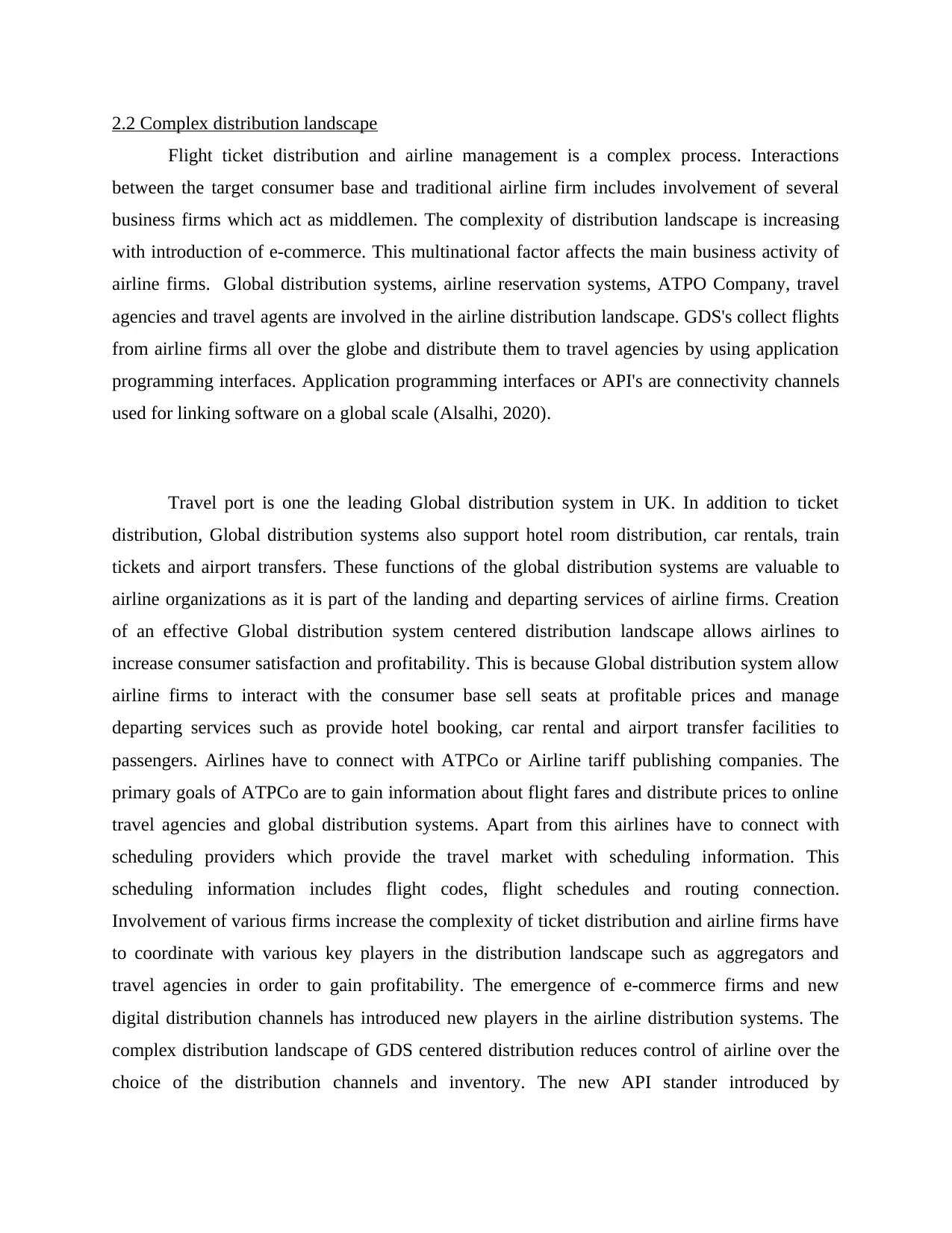
2.2 Complex distribution landscape
Flight ticket distribution and airline management is a complex process. Interactions
between the target consumer base and traditional airline firm includes involvement of several
business firms which act as middlemen. The complexity of distribution landscape is increasing
with introduction of e-commerce. This multinational factor affects the main business activity of
airline firms. Global distribution systems, airline reservation systems, ATPO Company, travel
agencies and travel agents are involved in the airline distribution landscape. GDS's collect flights
from airline firms all over the globe and distribute them to travel agencies by using application
programming interfaces. Application programming interfaces or API's are connectivity channels
used for linking software on a global scale (Alsalhi, 2020).
Travel port is one the leading Global distribution system in UK. In addition to ticket
distribution, Global distribution systems also support hotel room distribution, car rentals, train
tickets and airport transfers. These functions of the global distribution systems are valuable to
airline organizations as it is part of the landing and departing services of airline firms. Creation
of an effective Global distribution system centered distribution landscape allows airlines to
increase consumer satisfaction and profitability. This is because Global distribution system allow
airline firms to interact with the consumer base sell seats at profitable prices and manage
departing services such as provide hotel booking, car rental and airport transfer facilities to
passengers. Airlines have to connect with ATPCo or Airline tariff publishing companies. The
primary goals of ATPCo are to gain information about flight fares and distribute prices to online
travel agencies and global distribution systems. Apart from this airlines have to connect with
scheduling providers which provide the travel market with scheduling information. This
scheduling information includes flight codes, flight schedules and routing connection.
Involvement of various firms increase the complexity of ticket distribution and airline firms have
to coordinate with various key players in the distribution landscape such as aggregators and
travel agencies in order to gain profitability. The emergence of e-commerce firms and new
digital distribution channels has introduced new players in the airline distribution systems. The
complex distribution landscape of GDS centered distribution reduces control of airline over the
choice of the distribution channels and inventory. The new API stander introduced by
Flight ticket distribution and airline management is a complex process. Interactions
between the target consumer base and traditional airline firm includes involvement of several
business firms which act as middlemen. The complexity of distribution landscape is increasing
with introduction of e-commerce. This multinational factor affects the main business activity of
airline firms. Global distribution systems, airline reservation systems, ATPO Company, travel
agencies and travel agents are involved in the airline distribution landscape. GDS's collect flights
from airline firms all over the globe and distribute them to travel agencies by using application
programming interfaces. Application programming interfaces or API's are connectivity channels
used for linking software on a global scale (Alsalhi, 2020).
Travel port is one the leading Global distribution system in UK. In addition to ticket
distribution, Global distribution systems also support hotel room distribution, car rentals, train
tickets and airport transfers. These functions of the global distribution systems are valuable to
airline organizations as it is part of the landing and departing services of airline firms. Creation
of an effective Global distribution system centered distribution landscape allows airlines to
increase consumer satisfaction and profitability. This is because Global distribution system allow
airline firms to interact with the consumer base sell seats at profitable prices and manage
departing services such as provide hotel booking, car rental and airport transfer facilities to
passengers. Airlines have to connect with ATPCo or Airline tariff publishing companies. The
primary goals of ATPCo are to gain information about flight fares and distribute prices to online
travel agencies and global distribution systems. Apart from this airlines have to connect with
scheduling providers which provide the travel market with scheduling information. This
scheduling information includes flight codes, flight schedules and routing connection.
Involvement of various firms increase the complexity of ticket distribution and airline firms have
to coordinate with various key players in the distribution landscape such as aggregators and
travel agencies in order to gain profitability. The emergence of e-commerce firms and new
digital distribution channels has introduced new players in the airline distribution systems. The
complex distribution landscape of GDS centered distribution reduces control of airline over the
choice of the distribution channels and inventory. The new API stander introduced by

International air transport association enables airline firms to construct their own API's. This
gives airlines options to suggest their API's to GDC's or eliminate their role by directly
connecting with online travel agencies. Environment of more effective communication between
airlines travel agencies and travel companies is created with the introduction of NDC.
In addition to this new direct channels are being developed in the airline industry which
increases key players. This includes conversational commerce and social media messaging
application which allow consumer to access flight tickets and ancillary bundles through their
smart devices and social media applications. In addition to this search engine which play a
significant role in initial phase of the consumer journey can collaborate with airline firms to use
consumer date and provide personalized offers to consumers. E-commerce firms are another
entrant in the airline distribution landscape. E-commerce firms team up with airline to gain
access to rich consumer database and attract them to their platforms. The increasing complexity
of the airline distribution landscape has various advantages and disadvantages which are
provided below:
Advantages
Access to new markets: Collaboration with e-commerce giants allows airline firms to
enter new markets and enhance their International presence. Airline firms can easily tackle
regional competition by teaming up with e-commerce firms to connect with consumers of
foreign markets (Lee, 2019).
Control over distribution channels: The new distribution capabilities standard allows
business firms to gain more control over their distribution landscape. This will allow airlines to
increase their profitability as the main source of profit for most airlines is by give seating
options, priority boarding, customized meals and increase luggage amount for extra price. This
type of ancillary support information is limited during transfer of information from GDC to
online travel agencies.
Disadvantages
Dependency on firms: The introduction of new distribution capabilities standard does not
make airlines independent from other firms such as ATPCo and scheduling providers. Airlines
are only able to eliminate GDC from their distribution landscape. The distribution landscape of
gives airlines options to suggest their API's to GDC's or eliminate their role by directly
connecting with online travel agencies. Environment of more effective communication between
airlines travel agencies and travel companies is created with the introduction of NDC.
In addition to this new direct channels are being developed in the airline industry which
increases key players. This includes conversational commerce and social media messaging
application which allow consumer to access flight tickets and ancillary bundles through their
smart devices and social media applications. In addition to this search engine which play a
significant role in initial phase of the consumer journey can collaborate with airline firms to use
consumer date and provide personalized offers to consumers. E-commerce firms are another
entrant in the airline distribution landscape. E-commerce firms team up with airline to gain
access to rich consumer database and attract them to their platforms. The increasing complexity
of the airline distribution landscape has various advantages and disadvantages which are
provided below:
Advantages
Access to new markets: Collaboration with e-commerce giants allows airline firms to
enter new markets and enhance their International presence. Airline firms can easily tackle
regional competition by teaming up with e-commerce firms to connect with consumers of
foreign markets (Lee, 2019).
Control over distribution channels: The new distribution capabilities standard allows
business firms to gain more control over their distribution landscape. This will allow airlines to
increase their profitability as the main source of profit for most airlines is by give seating
options, priority boarding, customized meals and increase luggage amount for extra price. This
type of ancillary support information is limited during transfer of information from GDC to
online travel agencies.
Disadvantages
Dependency on firms: The introduction of new distribution capabilities standard does not
make airlines independent from other firms such as ATPCo and scheduling providers. Airlines
are only able to eliminate GDC from their distribution landscape. The distribution landscape of
Secure Best Marks with AI Grader
Need help grading? Try our AI Grader for instant feedback on your assignments.
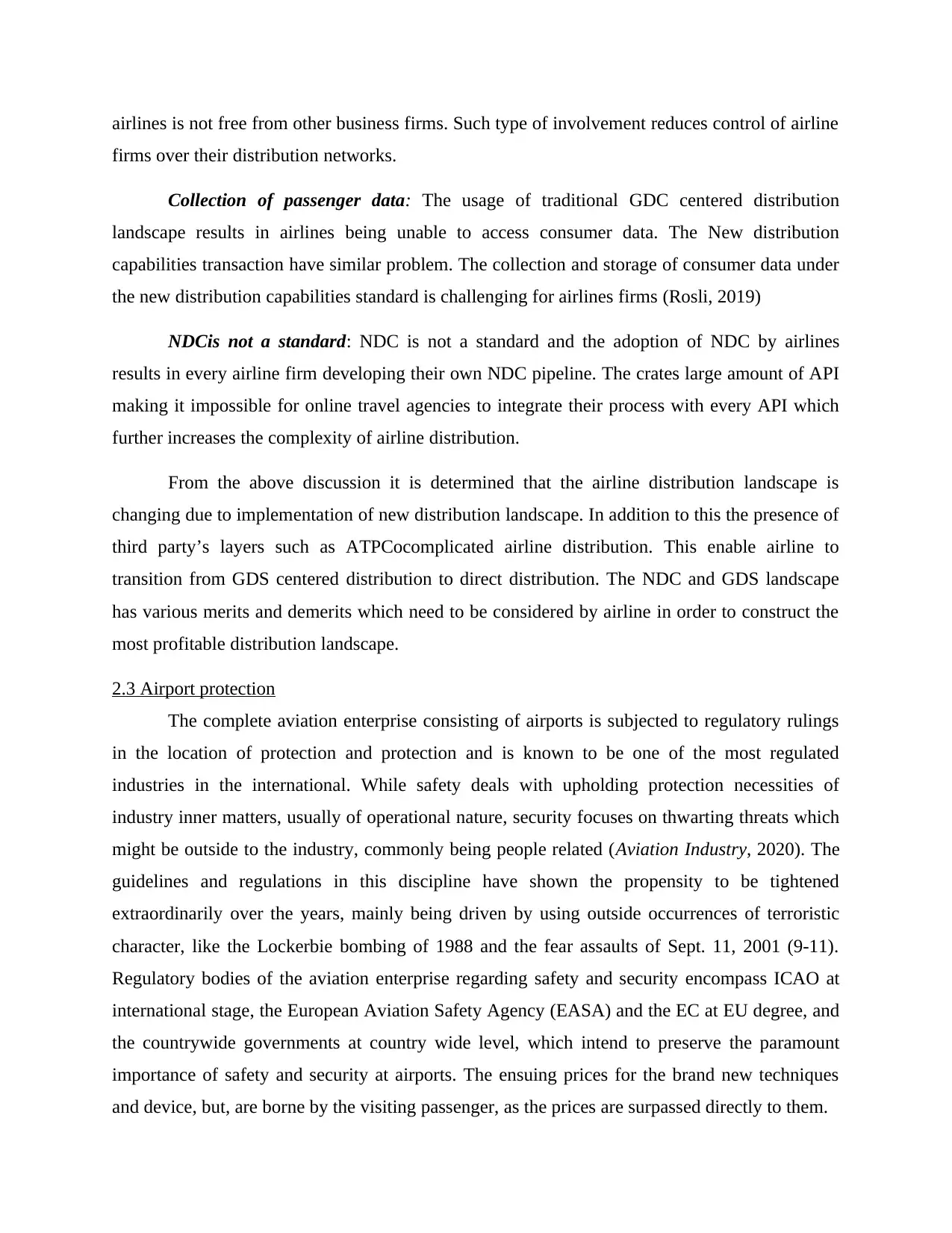
airlines is not free from other business firms. Such type of involvement reduces control of airline
firms over their distribution networks.
Collection of passenger data: The usage of traditional GDC centered distribution
landscape results in airlines being unable to access consumer data. The New distribution
capabilities transaction have similar problem. The collection and storage of consumer data under
the new distribution capabilities standard is challenging for airlines firms (Rosli, 2019)
NDCis not a standard: NDC is not a standard and the adoption of NDC by airlines
results in every airline firm developing their own NDC pipeline. The crates large amount of API
making it impossible for online travel agencies to integrate their process with every API which
further increases the complexity of airline distribution.
From the above discussion it is determined that the airline distribution landscape is
changing due to implementation of new distribution landscape. In addition to this the presence of
third party’s layers such as ATPCocomplicated airline distribution. This enable airline to
transition from GDS centered distribution to direct distribution. The NDC and GDS landscape
has various merits and demerits which need to be considered by airline in order to construct the
most profitable distribution landscape.
2.3 Airport protection
The complete aviation enterprise consisting of airports is subjected to regulatory rulings
in the location of protection and protection and is known to be one of the most regulated
industries in the international. While safety deals with upholding protection necessities of
industry inner matters, usually of operational nature, security focuses on thwarting threats which
might be outside to the industry, commonly being people related (Aviation Industry, 2020). The
guidelines and regulations in this discipline have shown the propensity to be tightened
extraordinarily over the years, mainly being driven by using outside occurrences of terroristic
character, like the Lockerbie bombing of 1988 and the fear assaults of Sept. 11, 2001 (9-11).
Regulatory bodies of the aviation enterprise regarding safety and security encompass ICAO at
international stage, the European Aviation Safety Agency (EASA) and the EC at EU degree, and
the countrywide governments at country wide level, which intend to preserve the paramount
importance of safety and security at airports. The ensuing prices for the brand new techniques
and device, but, are borne by the visiting passenger, as the prices are surpassed directly to them.
firms over their distribution networks.
Collection of passenger data: The usage of traditional GDC centered distribution
landscape results in airlines being unable to access consumer data. The New distribution
capabilities transaction have similar problem. The collection and storage of consumer data under
the new distribution capabilities standard is challenging for airlines firms (Rosli, 2019)
NDCis not a standard: NDC is not a standard and the adoption of NDC by airlines
results in every airline firm developing their own NDC pipeline. The crates large amount of API
making it impossible for online travel agencies to integrate their process with every API which
further increases the complexity of airline distribution.
From the above discussion it is determined that the airline distribution landscape is
changing due to implementation of new distribution landscape. In addition to this the presence of
third party’s layers such as ATPCocomplicated airline distribution. This enable airline to
transition from GDS centered distribution to direct distribution. The NDC and GDS landscape
has various merits and demerits which need to be considered by airline in order to construct the
most profitable distribution landscape.
2.3 Airport protection
The complete aviation enterprise consisting of airports is subjected to regulatory rulings
in the location of protection and protection and is known to be one of the most regulated
industries in the international. While safety deals with upholding protection necessities of
industry inner matters, usually of operational nature, security focuses on thwarting threats which
might be outside to the industry, commonly being people related (Aviation Industry, 2020). The
guidelines and regulations in this discipline have shown the propensity to be tightened
extraordinarily over the years, mainly being driven by using outside occurrences of terroristic
character, like the Lockerbie bombing of 1988 and the fear assaults of Sept. 11, 2001 (9-11).
Regulatory bodies of the aviation enterprise regarding safety and security encompass ICAO at
international stage, the European Aviation Safety Agency (EASA) and the EC at EU degree, and
the countrywide governments at country wide level, which intend to preserve the paramount
importance of safety and security at airports. The ensuing prices for the brand new techniques
and device, but, are borne by the visiting passenger, as the prices are surpassed directly to them.
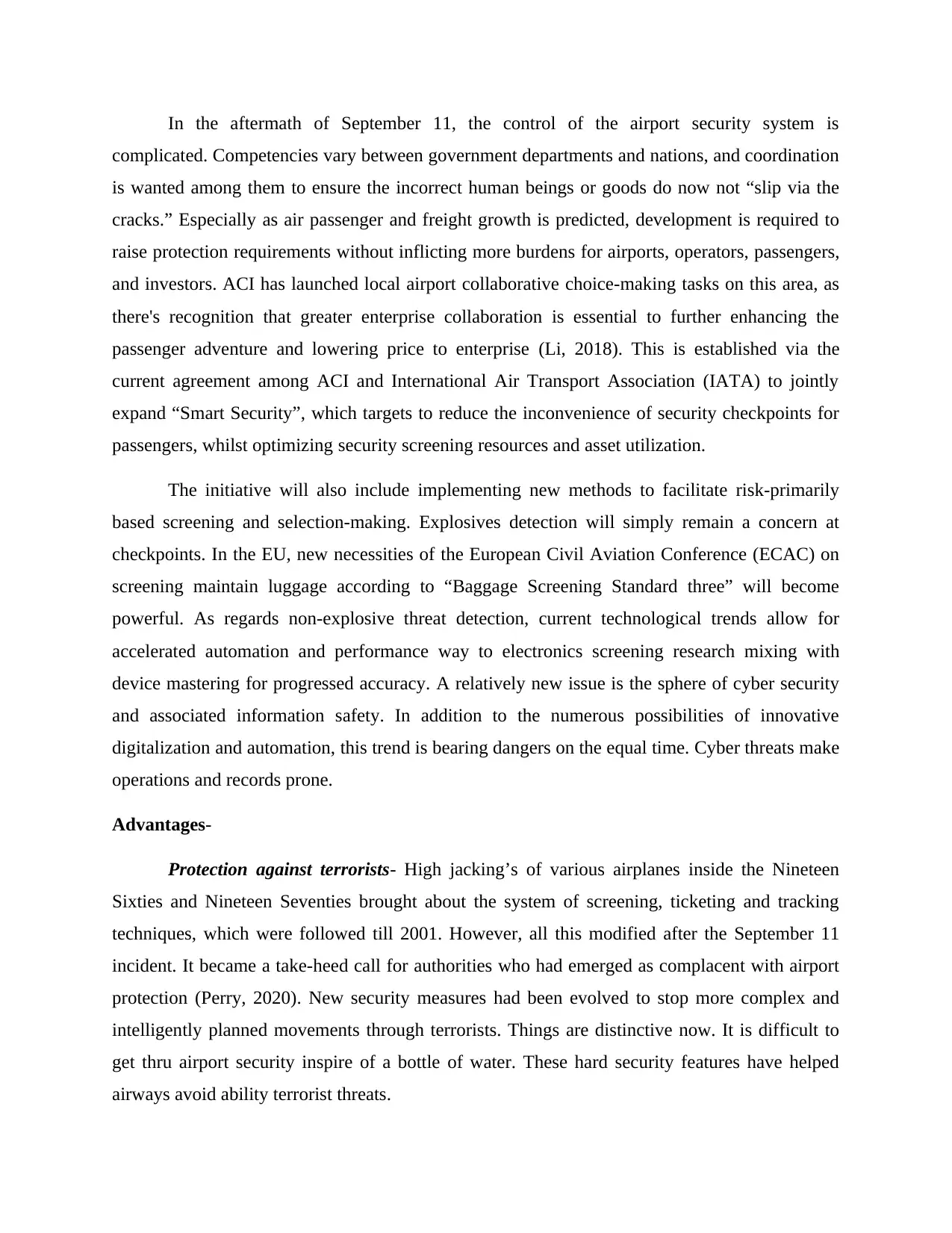
In the aftermath of September 11, the control of the airport security system is
complicated. Competencies vary between government departments and nations, and coordination
is wanted among them to ensure the incorrect human beings or goods do now not “slip via the
cracks.” Especially as air passenger and freight growth is predicted, development is required to
raise protection requirements without inflicting more burdens for airports, operators, passengers,
and investors. ACI has launched local airport collaborative choice-making tasks on this area, as
there's recognition that greater enterprise collaboration is essential to further enhancing the
passenger adventure and lowering price to enterprise (Li, 2018). This is established via the
current agreement among ACI and International Air Transport Association (IATA) to jointly
expand “Smart Security”, which targets to reduce the inconvenience of security checkpoints for
passengers, whilst optimizing security screening resources and asset utilization.
The initiative will also include implementing new methods to facilitate risk-primarily
based screening and selection-making. Explosives detection will simply remain a concern at
checkpoints. In the EU, new necessities of the European Civil Aviation Conference (ECAC) on
screening maintain luggage according to “Baggage Screening Standard three” will become
powerful. As regards non-explosive threat detection, current technological trends allow for
accelerated automation and performance way to electronics screening research mixing with
device mastering for progressed accuracy. A relatively new issue is the sphere of cyber security
and associated information safety. In addition to the numerous possibilities of innovative
digitalization and automation, this trend is bearing dangers on the equal time. Cyber threats make
operations and records prone.
Advantages-
Protection against terrorists- High jacking’s of various airplanes inside the Nineteen
Sixties and Nineteen Seventies brought about the system of screening, ticketing and tracking
techniques, which were followed till 2001. However, all this modified after the September 11
incident. It became a take-heed call for authorities who had emerged as complacent with airport
protection (Perry, 2020). New security measures had been evolved to stop more complex and
intelligently planned movements through terrorists. Things are distinctive now. It is difficult to
get thru airport security inspire of a bottle of water. These hard security features have helped
airways avoid ability terrorist threats.
complicated. Competencies vary between government departments and nations, and coordination
is wanted among them to ensure the incorrect human beings or goods do now not “slip via the
cracks.” Especially as air passenger and freight growth is predicted, development is required to
raise protection requirements without inflicting more burdens for airports, operators, passengers,
and investors. ACI has launched local airport collaborative choice-making tasks on this area, as
there's recognition that greater enterprise collaboration is essential to further enhancing the
passenger adventure and lowering price to enterprise (Li, 2018). This is established via the
current agreement among ACI and International Air Transport Association (IATA) to jointly
expand “Smart Security”, which targets to reduce the inconvenience of security checkpoints for
passengers, whilst optimizing security screening resources and asset utilization.
The initiative will also include implementing new methods to facilitate risk-primarily
based screening and selection-making. Explosives detection will simply remain a concern at
checkpoints. In the EU, new necessities of the European Civil Aviation Conference (ECAC) on
screening maintain luggage according to “Baggage Screening Standard three” will become
powerful. As regards non-explosive threat detection, current technological trends allow for
accelerated automation and performance way to electronics screening research mixing with
device mastering for progressed accuracy. A relatively new issue is the sphere of cyber security
and associated information safety. In addition to the numerous possibilities of innovative
digitalization and automation, this trend is bearing dangers on the equal time. Cyber threats make
operations and records prone.
Advantages-
Protection against terrorists- High jacking’s of various airplanes inside the Nineteen
Sixties and Nineteen Seventies brought about the system of screening, ticketing and tracking
techniques, which were followed till 2001. However, all this modified after the September 11
incident. It became a take-heed call for authorities who had emerged as complacent with airport
protection (Perry, 2020). New security measures had been evolved to stop more complex and
intelligently planned movements through terrorists. Things are distinctive now. It is difficult to
get thru airport security inspire of a bottle of water. These hard security features have helped
airways avoid ability terrorist threats.
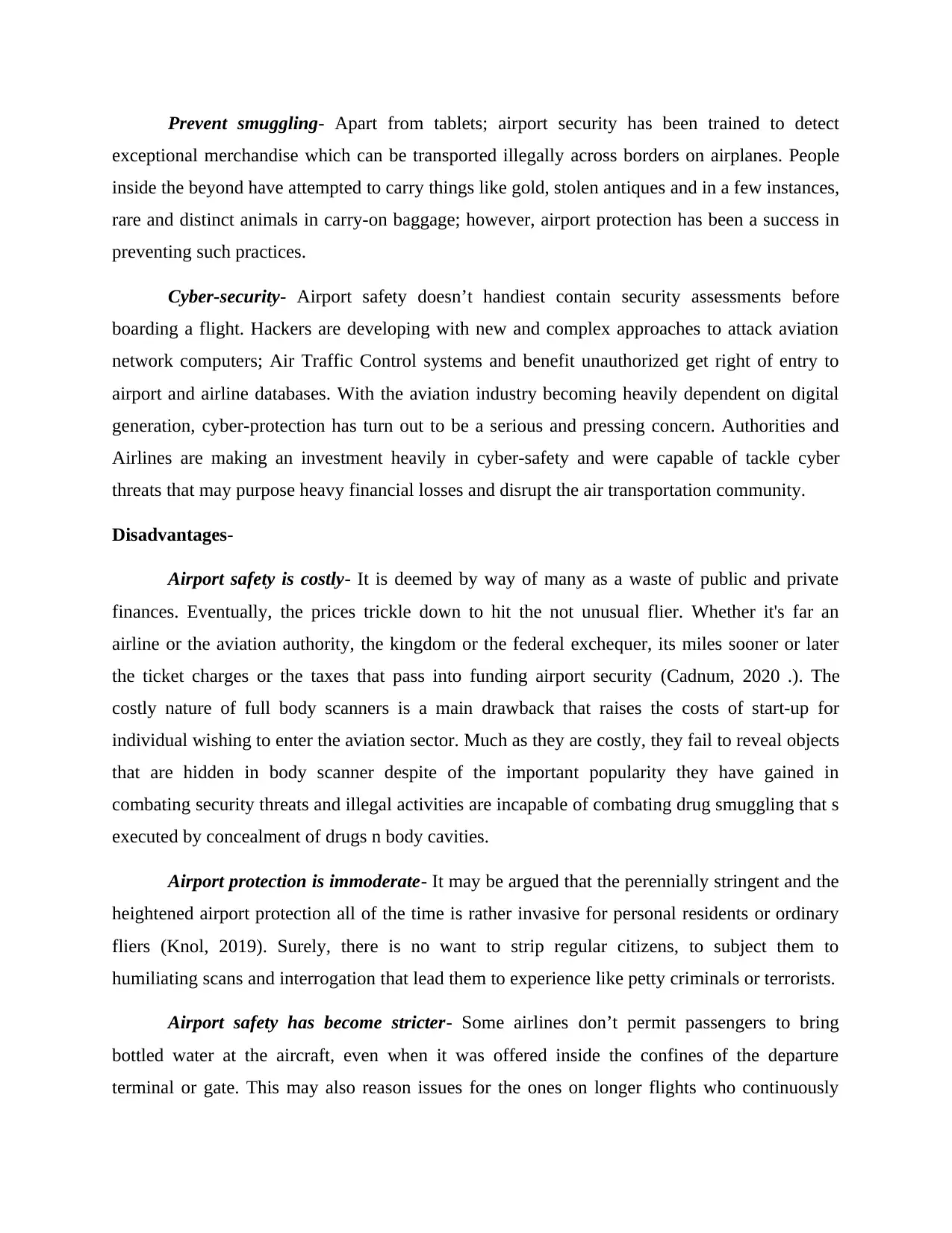
Prevent smuggling- Apart from tablets; airport security has been trained to detect
exceptional merchandise which can be transported illegally across borders on airplanes. People
inside the beyond have attempted to carry things like gold, stolen antiques and in a few instances,
rare and distinct animals in carry-on baggage; however, airport protection has been a success in
preventing such practices.
Cyber-security- Airport safety doesn’t handiest contain security assessments before
boarding a flight. Hackers are developing with new and complex approaches to attack aviation
network computers; Air Traffic Control systems and benefit unauthorized get right of entry to
airport and airline databases. With the aviation industry becoming heavily dependent on digital
generation, cyber-protection has turn out to be a serious and pressing concern. Authorities and
Airlines are making an investment heavily in cyber-safety and were capable of tackle cyber
threats that may purpose heavy financial losses and disrupt the air transportation community.
Disadvantages-
Airport safety is costly- It is deemed by way of many as a waste of public and private
finances. Eventually, the prices trickle down to hit the not unusual flier. Whether it's far an
airline or the aviation authority, the kingdom or the federal exchequer, its miles sooner or later
the ticket charges or the taxes that pass into funding airport security (Cadnum, 2020 .). The
costly nature of full body scanners is a main drawback that raises the costs of start-up for
individual wishing to enter the aviation sector. Much as they are costly, they fail to reveal objects
that are hidden in body scanner despite of the important popularity they have gained in
combating security threats and illegal activities are incapable of combating drug smuggling that s
executed by concealment of drugs n body cavities.
Airport protection is immoderate- It may be argued that the perennially stringent and the
heightened airport protection all of the time is rather invasive for personal residents or ordinary
fliers (Knol, 2019). Surely, there is no want to strip regular citizens, to subject them to
humiliating scans and interrogation that lead them to experience like petty criminals or terrorists.
Airport safety has become stricter- Some airlines don’t permit passengers to bring
bottled water at the aircraft, even when it was offered inside the confines of the departure
terminal or gate. This may also reason issues for the ones on longer flights who continuously
exceptional merchandise which can be transported illegally across borders on airplanes. People
inside the beyond have attempted to carry things like gold, stolen antiques and in a few instances,
rare and distinct animals in carry-on baggage; however, airport protection has been a success in
preventing such practices.
Cyber-security- Airport safety doesn’t handiest contain security assessments before
boarding a flight. Hackers are developing with new and complex approaches to attack aviation
network computers; Air Traffic Control systems and benefit unauthorized get right of entry to
airport and airline databases. With the aviation industry becoming heavily dependent on digital
generation, cyber-protection has turn out to be a serious and pressing concern. Authorities and
Airlines are making an investment heavily in cyber-safety and were capable of tackle cyber
threats that may purpose heavy financial losses and disrupt the air transportation community.
Disadvantages-
Airport safety is costly- It is deemed by way of many as a waste of public and private
finances. Eventually, the prices trickle down to hit the not unusual flier. Whether it's far an
airline or the aviation authority, the kingdom or the federal exchequer, its miles sooner or later
the ticket charges or the taxes that pass into funding airport security (Cadnum, 2020 .). The
costly nature of full body scanners is a main drawback that raises the costs of start-up for
individual wishing to enter the aviation sector. Much as they are costly, they fail to reveal objects
that are hidden in body scanner despite of the important popularity they have gained in
combating security threats and illegal activities are incapable of combating drug smuggling that s
executed by concealment of drugs n body cavities.
Airport protection is immoderate- It may be argued that the perennially stringent and the
heightened airport protection all of the time is rather invasive for personal residents or ordinary
fliers (Knol, 2019). Surely, there is no want to strip regular citizens, to subject them to
humiliating scans and interrogation that lead them to experience like petty criminals or terrorists.
Airport safety has become stricter- Some airlines don’t permit passengers to bring
bottled water at the aircraft, even when it was offered inside the confines of the departure
terminal or gate. This may also reason issues for the ones on longer flights who continuously
Paraphrase This Document
Need a fresh take? Get an instant paraphrase of this document with our AI Paraphraser
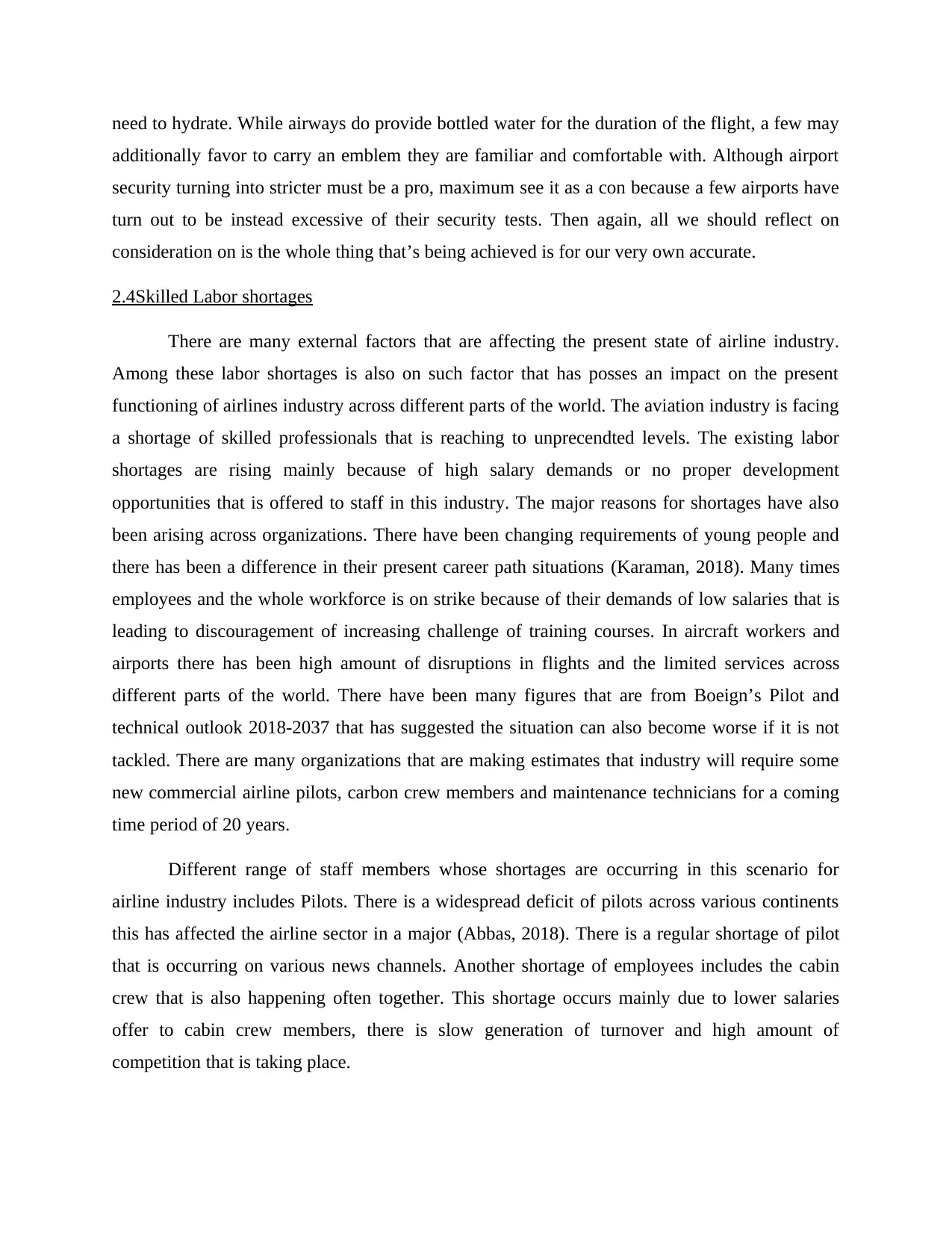
need to hydrate. While airways do provide bottled water for the duration of the flight, a few may
additionally favor to carry an emblem they are familiar and comfortable with. Although airport
security turning into stricter must be a pro, maximum see it as a con because a few airports have
turn out to be instead excessive of their security tests. Then again, all we should reflect on
consideration on is the whole thing that’s being achieved is for our very own accurate.
2.4Skilled Labor shortages
There are many external factors that are affecting the present state of airline industry.
Among these labor shortages is also on such factor that has posses an impact on the present
functioning of airlines industry across different parts of the world. The aviation industry is facing
a shortage of skilled professionals that is reaching to unprecendted levels. The existing labor
shortages are rising mainly because of high salary demands or no proper development
opportunities that is offered to staff in this industry. The major reasons for shortages have also
been arising across organizations. There have been changing requirements of young people and
there has been a difference in their present career path situations (Karaman, 2018). Many times
employees and the whole workforce is on strike because of their demands of low salaries that is
leading to discouragement of increasing challenge of training courses. In aircraft workers and
airports there has been high amount of disruptions in flights and the limited services across
different parts of the world. There have been many figures that are from Boeign’s Pilot and
technical outlook 2018-2037 that has suggested the situation can also become worse if it is not
tackled. There are many organizations that are making estimates that industry will require some
new commercial airline pilots, carbon crew members and maintenance technicians for a coming
time period of 20 years.
Different range of staff members whose shortages are occurring in this scenario for
airline industry includes Pilots. There is a widespread deficit of pilots across various continents
this has affected the airline sector in a major (Abbas, 2018). There is a regular shortage of pilot
that is occurring on various news channels. Another shortage of employees includes the cabin
crew that is also happening often together. This shortage occurs mainly due to lower salaries
offer to cabin crew members, there is slow generation of turnover and high amount of
competition that is taking place.
additionally favor to carry an emblem they are familiar and comfortable with. Although airport
security turning into stricter must be a pro, maximum see it as a con because a few airports have
turn out to be instead excessive of their security tests. Then again, all we should reflect on
consideration on is the whole thing that’s being achieved is for our very own accurate.
2.4Skilled Labor shortages
There are many external factors that are affecting the present state of airline industry.
Among these labor shortages is also on such factor that has posses an impact on the present
functioning of airlines industry across different parts of the world. The aviation industry is facing
a shortage of skilled professionals that is reaching to unprecendted levels. The existing labor
shortages are rising mainly because of high salary demands or no proper development
opportunities that is offered to staff in this industry. The major reasons for shortages have also
been arising across organizations. There have been changing requirements of young people and
there has been a difference in their present career path situations (Karaman, 2018). Many times
employees and the whole workforce is on strike because of their demands of low salaries that is
leading to discouragement of increasing challenge of training courses. In aircraft workers and
airports there has been high amount of disruptions in flights and the limited services across
different parts of the world. There have been many figures that are from Boeign’s Pilot and
technical outlook 2018-2037 that has suggested the situation can also become worse if it is not
tackled. There are many organizations that are making estimates that industry will require some
new commercial airline pilots, carbon crew members and maintenance technicians for a coming
time period of 20 years.
Different range of staff members whose shortages are occurring in this scenario for
airline industry includes Pilots. There is a widespread deficit of pilots across various continents
this has affected the airline sector in a major (Abbas, 2018). There is a regular shortage of pilot
that is occurring on various news channels. Another shortage of employees includes the cabin
crew that is also happening often together. This shortage occurs mainly due to lower salaries
offer to cabin crew members, there is slow generation of turnover and high amount of
competition that is taking place.
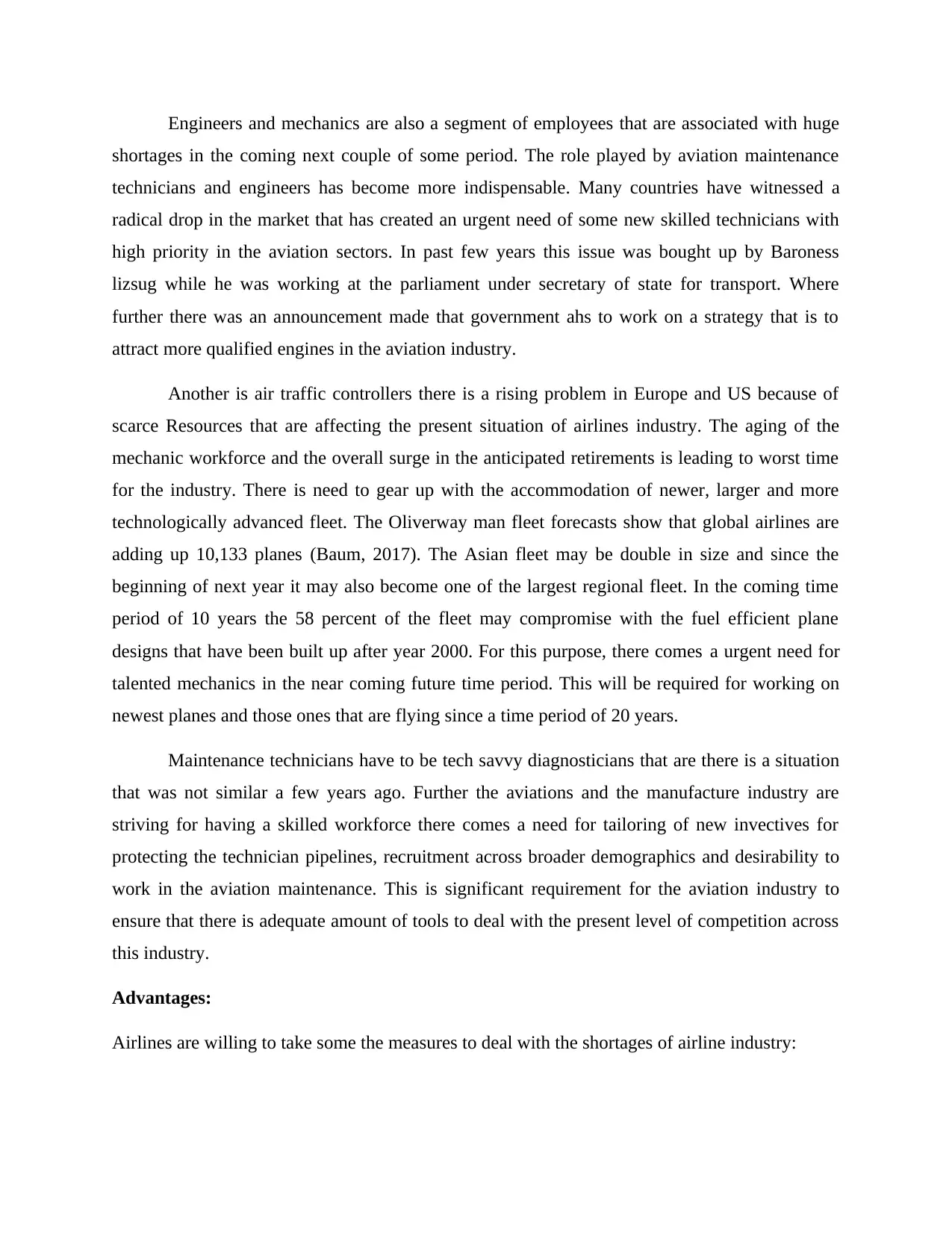
Engineers and mechanics are also a segment of employees that are associated with huge
shortages in the coming next couple of some period. The role played by aviation maintenance
technicians and engineers has become more indispensable. Many countries have witnessed a
radical drop in the market that has created an urgent need of some new skilled technicians with
high priority in the aviation sectors. In past few years this issue was bought up by Baroness
lizsug while he was working at the parliament under secretary of state for transport. Where
further there was an announcement made that government ahs to work on a strategy that is to
attract more qualified engines in the aviation industry.
Another is air traffic controllers there is a rising problem in Europe and US because of
scarce Resources that are affecting the present situation of airlines industry. The aging of the
mechanic workforce and the overall surge in the anticipated retirements is leading to worst time
for the industry. There is need to gear up with the accommodation of newer, larger and more
technologically advanced fleet. The Oliverway man fleet forecasts show that global airlines are
adding up 10,133 planes (Baum, 2017). The Asian fleet may be double in size and since the
beginning of next year it may also become one of the largest regional fleet. In the coming time
period of 10 years the 58 percent of the fleet may compromise with the fuel efficient plane
designs that have been built up after year 2000. For this purpose, there comes a urgent need for
talented mechanics in the near coming future time period. This will be required for working on
newest planes and those ones that are flying since a time period of 20 years.
Maintenance technicians have to be tech savvy diagnosticians that are there is a situation
that was not similar a few years ago. Further the aviations and the manufacture industry are
striving for having a skilled workforce there comes a need for tailoring of new invectives for
protecting the technician pipelines, recruitment across broader demographics and desirability to
work in the aviation maintenance. This is significant requirement for the aviation industry to
ensure that there is adequate amount of tools to deal with the present level of competition across
this industry.
Advantages:
Airlines are willing to take some the measures to deal with the shortages of airline industry:
shortages in the coming next couple of some period. The role played by aviation maintenance
technicians and engineers has become more indispensable. Many countries have witnessed a
radical drop in the market that has created an urgent need of some new skilled technicians with
high priority in the aviation sectors. In past few years this issue was bought up by Baroness
lizsug while he was working at the parliament under secretary of state for transport. Where
further there was an announcement made that government ahs to work on a strategy that is to
attract more qualified engines in the aviation industry.
Another is air traffic controllers there is a rising problem in Europe and US because of
scarce Resources that are affecting the present situation of airlines industry. The aging of the
mechanic workforce and the overall surge in the anticipated retirements is leading to worst time
for the industry. There is need to gear up with the accommodation of newer, larger and more
technologically advanced fleet. The Oliverway man fleet forecasts show that global airlines are
adding up 10,133 planes (Baum, 2017). The Asian fleet may be double in size and since the
beginning of next year it may also become one of the largest regional fleet. In the coming time
period of 10 years the 58 percent of the fleet may compromise with the fuel efficient plane
designs that have been built up after year 2000. For this purpose, there comes a urgent need for
talented mechanics in the near coming future time period. This will be required for working on
newest planes and those ones that are flying since a time period of 20 years.
Maintenance technicians have to be tech savvy diagnosticians that are there is a situation
that was not similar a few years ago. Further the aviations and the manufacture industry are
striving for having a skilled workforce there comes a need for tailoring of new invectives for
protecting the technician pipelines, recruitment across broader demographics and desirability to
work in the aviation maintenance. This is significant requirement for the aviation industry to
ensure that there is adequate amount of tools to deal with the present level of competition across
this industry.
Advantages:
Airlines are willing to take some the measures to deal with the shortages of airline industry:
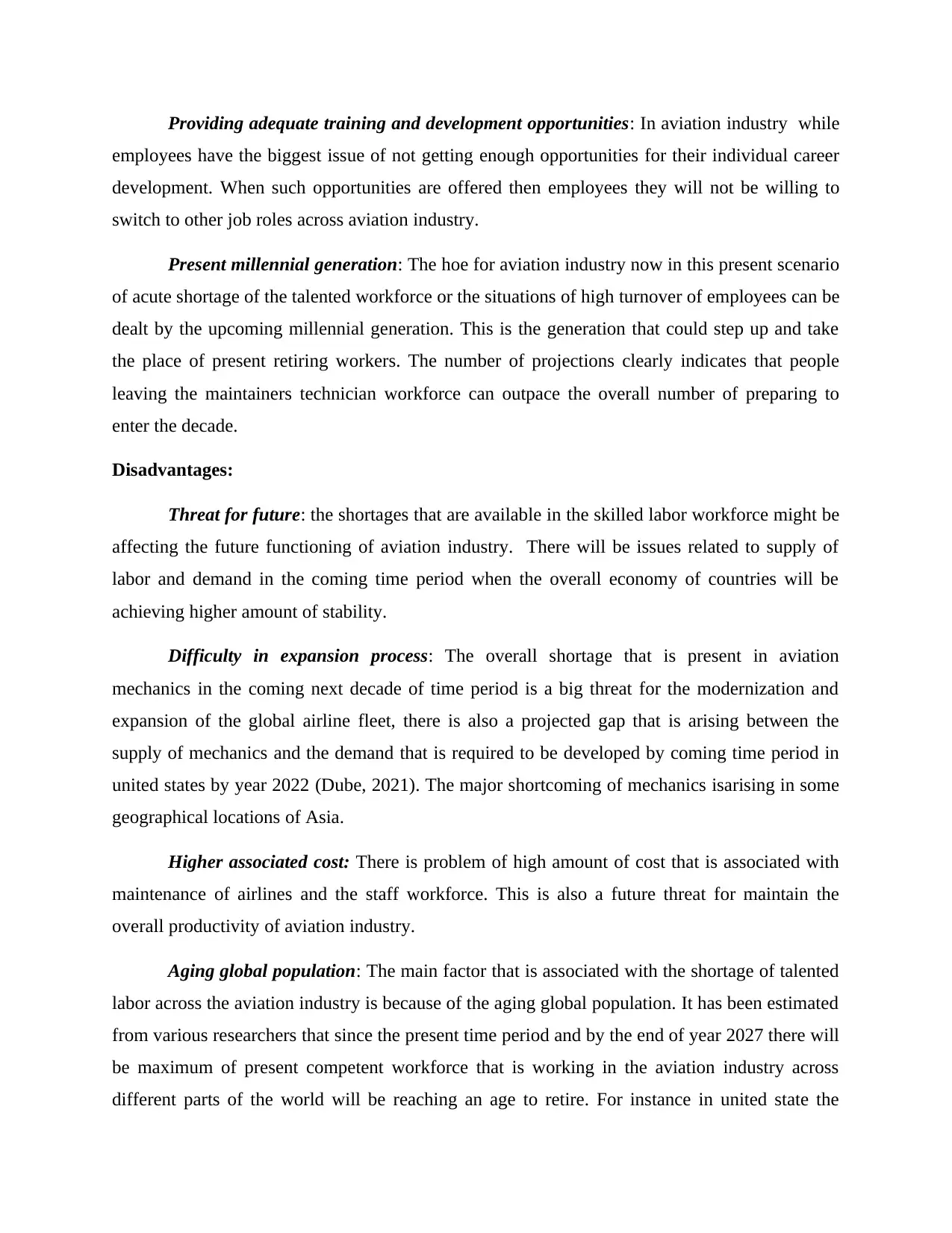
Providing adequate training and development opportunities: In aviation industry while
employees have the biggest issue of not getting enough opportunities for their individual career
development. When such opportunities are offered then employees they will not be willing to
switch to other job roles across aviation industry.
Present millennial generation: The hoe for aviation industry now in this present scenario
of acute shortage of the talented workforce or the situations of high turnover of employees can be
dealt by the upcoming millennial generation. This is the generation that could step up and take
the place of present retiring workers. The number of projections clearly indicates that people
leaving the maintainers technician workforce can outpace the overall number of preparing to
enter the decade.
Disadvantages:
Threat for future: the shortages that are available in the skilled labor workforce might be
affecting the future functioning of aviation industry. There will be issues related to supply of
labor and demand in the coming time period when the overall economy of countries will be
achieving higher amount of stability.
Difficulty in expansion process: The overall shortage that is present in aviation
mechanics in the coming next decade of time period is a big threat for the modernization and
expansion of the global airline fleet, there is also a projected gap that is arising between the
supply of mechanics and the demand that is required to be developed by coming time period in
united states by year 2022 (Dube, 2021). The major shortcoming of mechanics isarising in some
geographical locations of Asia.
Higher associated cost: There is problem of high amount of cost that is associated with
maintenance of airlines and the staff workforce. This is also a future threat for maintain the
overall productivity of aviation industry.
Aging global population: The main factor that is associated with the shortage of talented
labor across the aviation industry is because of the aging global population. It has been estimated
from various researchers that since the present time period and by the end of year 2027 there will
be maximum of present competent workforce that is working in the aviation industry across
different parts of the world will be reaching an age to retire. For instance in united state the
employees have the biggest issue of not getting enough opportunities for their individual career
development. When such opportunities are offered then employees they will not be willing to
switch to other job roles across aviation industry.
Present millennial generation: The hoe for aviation industry now in this present scenario
of acute shortage of the talented workforce or the situations of high turnover of employees can be
dealt by the upcoming millennial generation. This is the generation that could step up and take
the place of present retiring workers. The number of projections clearly indicates that people
leaving the maintainers technician workforce can outpace the overall number of preparing to
enter the decade.
Disadvantages:
Threat for future: the shortages that are available in the skilled labor workforce might be
affecting the future functioning of aviation industry. There will be issues related to supply of
labor and demand in the coming time period when the overall economy of countries will be
achieving higher amount of stability.
Difficulty in expansion process: The overall shortage that is present in aviation
mechanics in the coming next decade of time period is a big threat for the modernization and
expansion of the global airline fleet, there is also a projected gap that is arising between the
supply of mechanics and the demand that is required to be developed by coming time period in
united states by year 2022 (Dube, 2021). The major shortcoming of mechanics isarising in some
geographical locations of Asia.
Higher associated cost: There is problem of high amount of cost that is associated with
maintenance of airlines and the staff workforce. This is also a future threat for maintain the
overall productivity of aviation industry.
Aging global population: The main factor that is associated with the shortage of talented
labor across the aviation industry is because of the aging global population. It has been estimated
from various researchers that since the present time period and by the end of year 2027 there will
be maximum of present competent workforce that is working in the aviation industry across
different parts of the world will be reaching an age to retire. For instance in united state the
Secure Best Marks with AI Grader
Need help grading? Try our AI Grader for instant feedback on your assignments.

median age of aviation mechanics is 51 years and 9 years older median age of the broader United
States workforce can be calculated by the US bureau of labor statistics.
States workforce can be calculated by the US bureau of labor statistics.
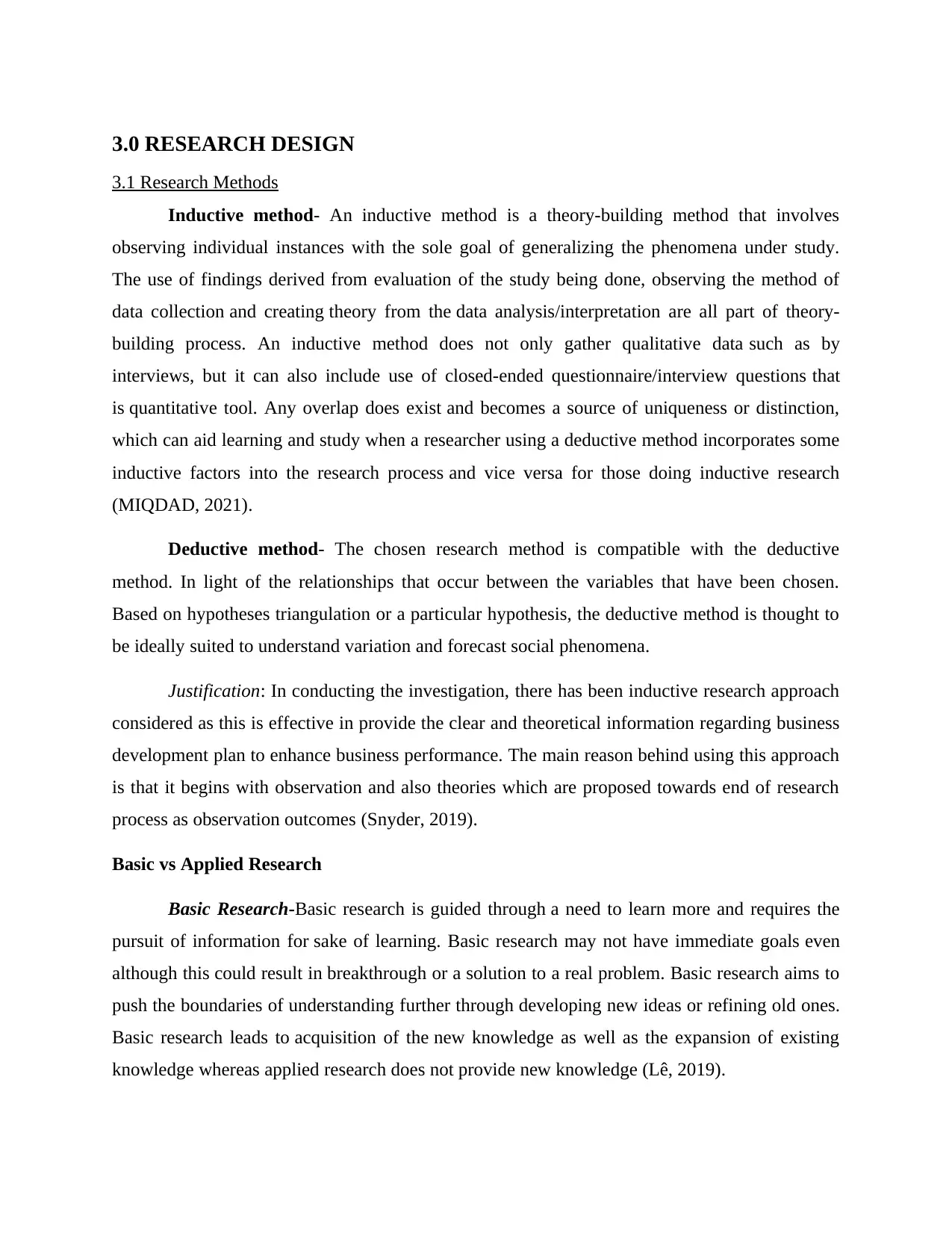
3.0 RESEARCH DESIGN
3.1 Research Methods
Inductive method- An inductive method is a theory-building method that involves
observing individual instances with the sole goal of generalizing the phenomena under study.
The use of findings derived from evaluation of the study being done, observing the method of
data collection and creating theory from the data analysis/interpretation are all part of theory-
building process. An inductive method does not only gather qualitative data such as by
interviews, but it can also include use of closed-ended questionnaire/interview questions that
is quantitative tool. Any overlap does exist and becomes a source of uniqueness or distinction,
which can aid learning and study when a researcher using a deductive method incorporates some
inductive factors into the research process and vice versa for those doing inductive research
(MIQDAD, 2021).
Deductive method- The chosen research method is compatible with the deductive
method. In light of the relationships that occur between the variables that have been chosen.
Based on hypotheses triangulation or a particular hypothesis, the deductive method is thought to
be ideally suited to understand variation and forecast social phenomena.
Justification: In conducting the investigation, there has been inductive research approach
considered as this is effective in provide the clear and theoretical information regarding business
development plan to enhance business performance. The main reason behind using this approach
is that it begins with observation and also theories which are proposed towards end of research
process as observation outcomes (Snyder, 2019).
Basic vs Applied Research
Basic Research-Basic research is guided through a need to learn more and requires the
pursuit of information for sake of learning. Basic research may not have immediate goals even
although this could result in breakthrough or a solution to a real problem. Basic research aims to
push the boundaries of understanding further through developing new ideas or refining old ones.
Basic research leads to acquisition of the new knowledge as well as the expansion of existing
knowledge whereas applied research does not provide new knowledge (Lê, 2019).
3.1 Research Methods
Inductive method- An inductive method is a theory-building method that involves
observing individual instances with the sole goal of generalizing the phenomena under study.
The use of findings derived from evaluation of the study being done, observing the method of
data collection and creating theory from the data analysis/interpretation are all part of theory-
building process. An inductive method does not only gather qualitative data such as by
interviews, but it can also include use of closed-ended questionnaire/interview questions that
is quantitative tool. Any overlap does exist and becomes a source of uniqueness or distinction,
which can aid learning and study when a researcher using a deductive method incorporates some
inductive factors into the research process and vice versa for those doing inductive research
(MIQDAD, 2021).
Deductive method- The chosen research method is compatible with the deductive
method. In light of the relationships that occur between the variables that have been chosen.
Based on hypotheses triangulation or a particular hypothesis, the deductive method is thought to
be ideally suited to understand variation and forecast social phenomena.
Justification: In conducting the investigation, there has been inductive research approach
considered as this is effective in provide the clear and theoretical information regarding business
development plan to enhance business performance. The main reason behind using this approach
is that it begins with observation and also theories which are proposed towards end of research
process as observation outcomes (Snyder, 2019).
Basic vs Applied Research
Basic Research-Basic research is guided through a need to learn more and requires the
pursuit of information for sake of learning. Basic research may not have immediate goals even
although this could result in breakthrough or a solution to a real problem. Basic research aims to
push the boundaries of understanding further through developing new ideas or refining old ones.
Basic research leads to acquisition of the new knowledge as well as the expansion of existing
knowledge whereas applied research does not provide new knowledge (Lê, 2019).
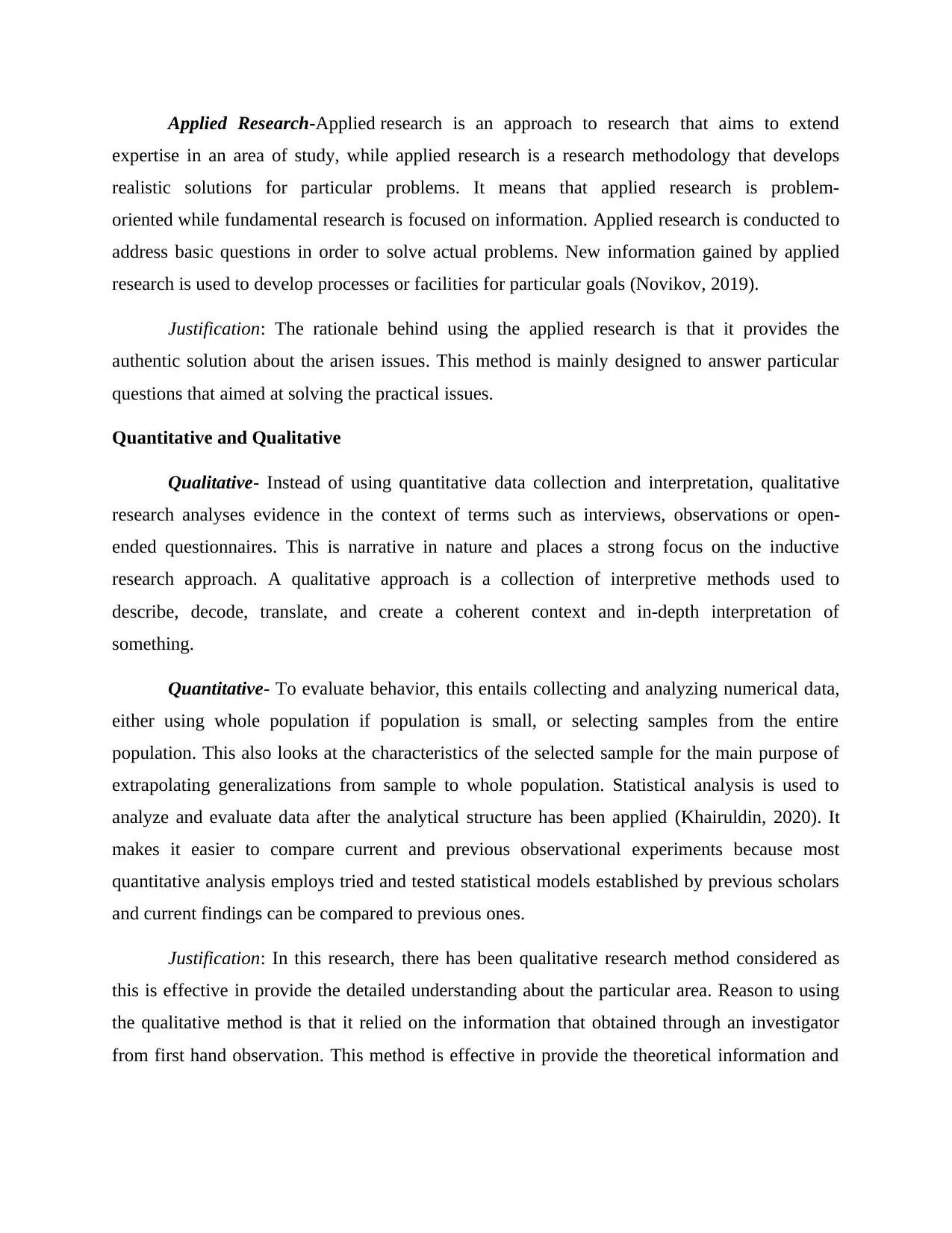
Applied Research-Applied research is an approach to research that aims to extend
expertise in an area of study, while applied research is a research methodology that develops
realistic solutions for particular problems. It means that applied research is problem-
oriented while fundamental research is focused on information. Applied research is conducted to
address basic questions in order to solve actual problems. New information gained by applied
research is used to develop processes or facilities for particular goals (Novikov, 2019).
Justification: The rationale behind using the applied research is that it provides the
authentic solution about the arisen issues. This method is mainly designed to answer particular
questions that aimed at solving the practical issues.
Quantitative and Qualitative
Qualitative- Instead of using quantitative data collection and interpretation, qualitative
research analyses evidence in the context of terms such as interviews, observations or open-
ended questionnaires. This is narrative in nature and places a strong focus on the inductive
research approach. A qualitative approach is a collection of interpretive methods used to
describe, decode, translate, and create a coherent context and in-depth interpretation of
something.
Quantitative- To evaluate behavior, this entails collecting and analyzing numerical data,
either using whole population if population is small, or selecting samples from the entire
population. This also looks at the characteristics of the selected sample for the main purpose of
extrapolating generalizations from sample to whole population. Statistical analysis is used to
analyze and evaluate data after the analytical structure has been applied (Khairuldin, 2020). It
makes it easier to compare current and previous observational experiments because most
quantitative analysis employs tried and tested statistical models established by previous scholars
and current findings can be compared to previous ones.
Justification: In this research, there has been qualitative research method considered as
this is effective in provide the detailed understanding about the particular area. Reason to using
the qualitative method is that it relied on the information that obtained through an investigator
from first hand observation. This method is effective in provide the theoretical information and
expertise in an area of study, while applied research is a research methodology that develops
realistic solutions for particular problems. It means that applied research is problem-
oriented while fundamental research is focused on information. Applied research is conducted to
address basic questions in order to solve actual problems. New information gained by applied
research is used to develop processes or facilities for particular goals (Novikov, 2019).
Justification: The rationale behind using the applied research is that it provides the
authentic solution about the arisen issues. This method is mainly designed to answer particular
questions that aimed at solving the practical issues.
Quantitative and Qualitative
Qualitative- Instead of using quantitative data collection and interpretation, qualitative
research analyses evidence in the context of terms such as interviews, observations or open-
ended questionnaires. This is narrative in nature and places a strong focus on the inductive
research approach. A qualitative approach is a collection of interpretive methods used to
describe, decode, translate, and create a coherent context and in-depth interpretation of
something.
Quantitative- To evaluate behavior, this entails collecting and analyzing numerical data,
either using whole population if population is small, or selecting samples from the entire
population. This also looks at the characteristics of the selected sample for the main purpose of
extrapolating generalizations from sample to whole population. Statistical analysis is used to
analyze and evaluate data after the analytical structure has been applied (Khairuldin, 2020). It
makes it easier to compare current and previous observational experiments because most
quantitative analysis employs tried and tested statistical models established by previous scholars
and current findings can be compared to previous ones.
Justification: In this research, there has been qualitative research method considered as
this is effective in provide the detailed understanding about the particular area. Reason to using
the qualitative method is that it relied on the information that obtained through an investigator
from first hand observation. This method is effective in provide the theoretical information and
Paraphrase This Document
Need a fresh take? Get an instant paraphrase of this document with our AI Paraphraser
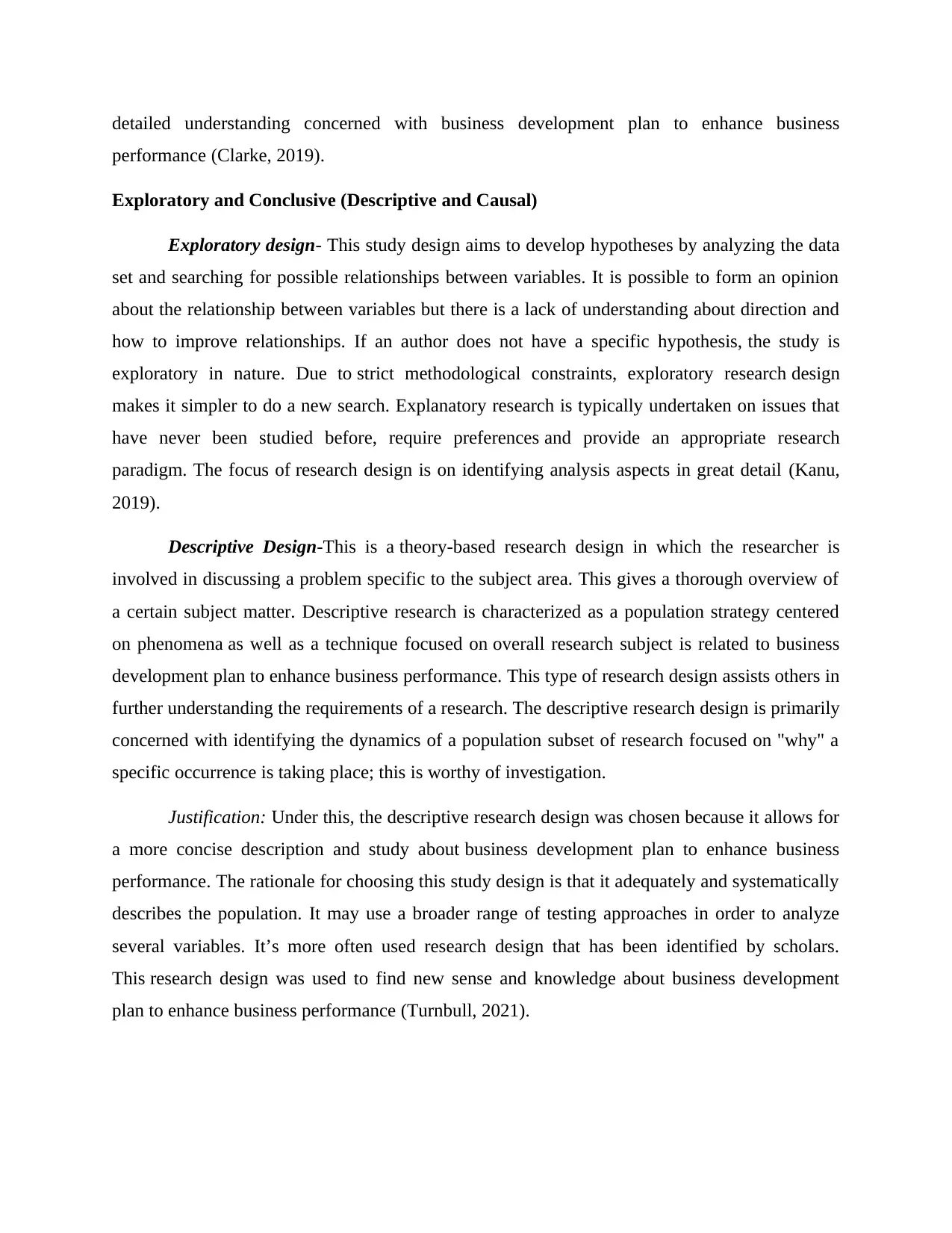
detailed understanding concerned with business development plan to enhance business
performance (Clarke, 2019).
Exploratory and Conclusive (Descriptive and Causal)
Exploratory design- This study design aims to develop hypotheses by analyzing the data
set and searching for possible relationships between variables. It is possible to form an opinion
about the relationship between variables but there is a lack of understanding about direction and
how to improve relationships. If an author does not have a specific hypothesis, the study is
exploratory in nature. Due to strict methodological constraints, exploratory research design
makes it simpler to do a new search. Explanatory research is typically undertaken on issues that
have never been studied before, require preferences and provide an appropriate research
paradigm. The focus of research design is on identifying analysis aspects in great detail (Kanu,
2019).
Descriptive Design-This is a theory-based research design in which the researcher is
involved in discussing a problem specific to the subject area. This gives a thorough overview of
a certain subject matter. Descriptive research is characterized as a population strategy centered
on phenomena as well as a technique focused on overall research subject is related to business
development plan to enhance business performance. This type of research design assists others in
further understanding the requirements of a research. The descriptive research design is primarily
concerned with identifying the dynamics of a population subset of research focused on "why" a
specific occurrence is taking place; this is worthy of investigation.
Justification: Under this, the descriptive research design was chosen because it allows for
a more concise description and study about business development plan to enhance business
performance. The rationale for choosing this study design is that it adequately and systematically
describes the population. It may use a broader range of testing approaches in order to analyze
several variables. It’s more often used research design that has been identified by scholars.
This research design was used to find new sense and knowledge about business development
plan to enhance business performance (Turnbull, 2021).
performance (Clarke, 2019).
Exploratory and Conclusive (Descriptive and Causal)
Exploratory design- This study design aims to develop hypotheses by analyzing the data
set and searching for possible relationships between variables. It is possible to form an opinion
about the relationship between variables but there is a lack of understanding about direction and
how to improve relationships. If an author does not have a specific hypothesis, the study is
exploratory in nature. Due to strict methodological constraints, exploratory research design
makes it simpler to do a new search. Explanatory research is typically undertaken on issues that
have never been studied before, require preferences and provide an appropriate research
paradigm. The focus of research design is on identifying analysis aspects in great detail (Kanu,
2019).
Descriptive Design-This is a theory-based research design in which the researcher is
involved in discussing a problem specific to the subject area. This gives a thorough overview of
a certain subject matter. Descriptive research is characterized as a population strategy centered
on phenomena as well as a technique focused on overall research subject is related to business
development plan to enhance business performance. This type of research design assists others in
further understanding the requirements of a research. The descriptive research design is primarily
concerned with identifying the dynamics of a population subset of research focused on "why" a
specific occurrence is taking place; this is worthy of investigation.
Justification: Under this, the descriptive research design was chosen because it allows for
a more concise description and study about business development plan to enhance business
performance. The rationale for choosing this study design is that it adequately and systematically
describes the population. It may use a broader range of testing approaches in order to analyze
several variables. It’s more often used research design that has been identified by scholars.
This research design was used to find new sense and knowledge about business development
plan to enhance business performance (Turnbull, 2021).
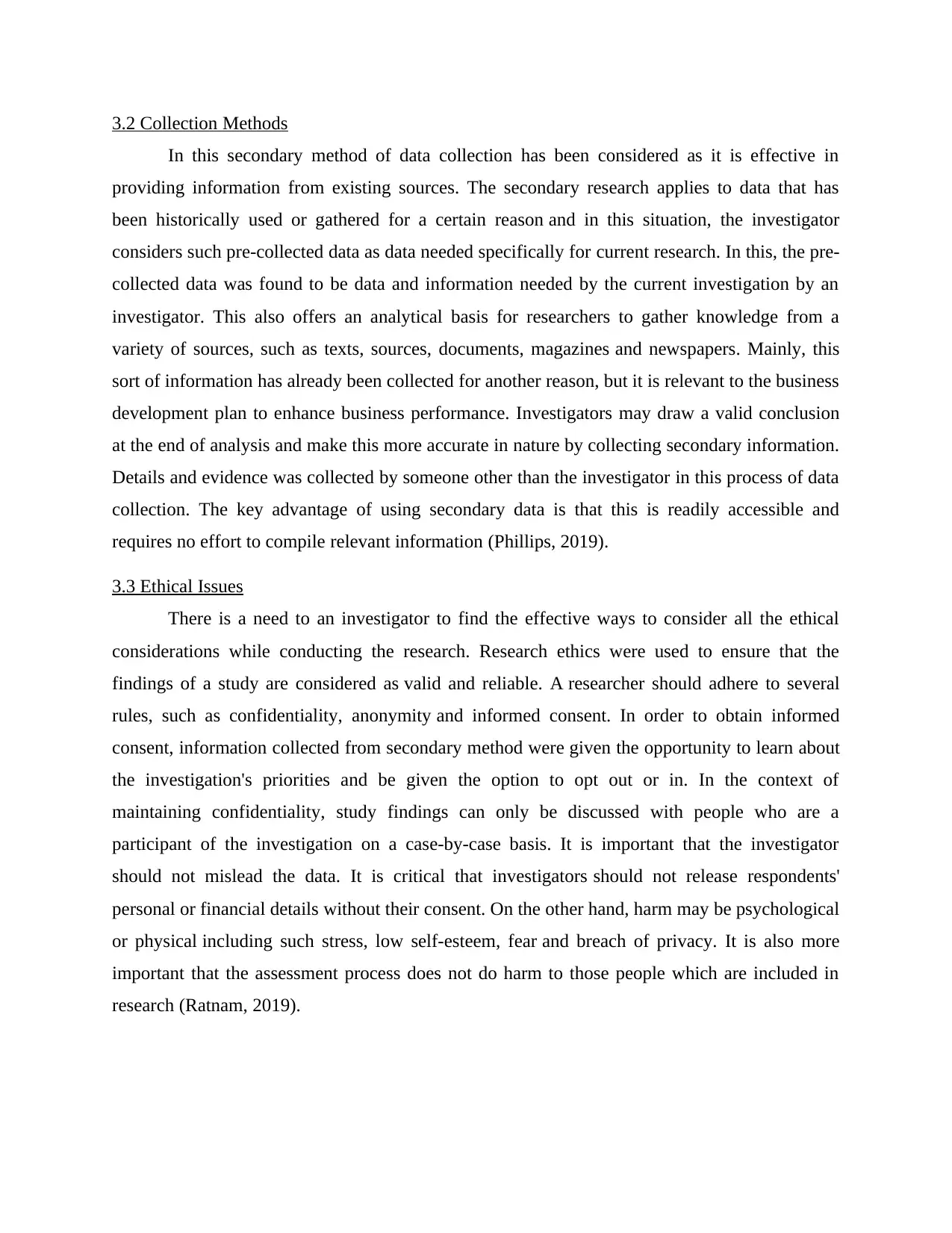
3.2 Collection Methods
In this secondary method of data collection has been considered as it is effective in
providing information from existing sources. The secondary research applies to data that has
been historically used or gathered for a certain reason and in this situation, the investigator
considers such pre-collected data as data needed specifically for current research. In this, the pre-
collected data was found to be data and information needed by the current investigation by an
investigator. This also offers an analytical basis for researchers to gather knowledge from a
variety of sources, such as texts, sources, documents, magazines and newspapers. Mainly, this
sort of information has already been collected for another reason, but it is relevant to the business
development plan to enhance business performance. Investigators may draw a valid conclusion
at the end of analysis and make this more accurate in nature by collecting secondary information.
Details and evidence was collected by someone other than the investigator in this process of data
collection. The key advantage of using secondary data is that this is readily accessible and
requires no effort to compile relevant information (Phillips, 2019).
3.3 Ethical Issues
There is a need to an investigator to find the effective ways to consider all the ethical
considerations while conducting the research. Research ethics were used to ensure that the
findings of a study are considered as valid and reliable. A researcher should adhere to several
rules, such as confidentiality, anonymity and informed consent. In order to obtain informed
consent, information collected from secondary method were given the opportunity to learn about
the investigation's priorities and be given the option to opt out or in. In the context of
maintaining confidentiality, study findings can only be discussed with people who are a
participant of the investigation on a case-by-case basis. It is important that the investigator
should not mislead the data. It is critical that investigators should not release respondents'
personal or financial details without their consent. On the other hand, harm may be psychological
or physical including such stress, low self-esteem, fear and breach of privacy. It is also more
important that the assessment process does not do harm to those people which are included in
research (Ratnam, 2019).
In this secondary method of data collection has been considered as it is effective in
providing information from existing sources. The secondary research applies to data that has
been historically used or gathered for a certain reason and in this situation, the investigator
considers such pre-collected data as data needed specifically for current research. In this, the pre-
collected data was found to be data and information needed by the current investigation by an
investigator. This also offers an analytical basis for researchers to gather knowledge from a
variety of sources, such as texts, sources, documents, magazines and newspapers. Mainly, this
sort of information has already been collected for another reason, but it is relevant to the business
development plan to enhance business performance. Investigators may draw a valid conclusion
at the end of analysis and make this more accurate in nature by collecting secondary information.
Details and evidence was collected by someone other than the investigator in this process of data
collection. The key advantage of using secondary data is that this is readily accessible and
requires no effort to compile relevant information (Phillips, 2019).
3.3 Ethical Issues
There is a need to an investigator to find the effective ways to consider all the ethical
considerations while conducting the research. Research ethics were used to ensure that the
findings of a study are considered as valid and reliable. A researcher should adhere to several
rules, such as confidentiality, anonymity and informed consent. In order to obtain informed
consent, information collected from secondary method were given the opportunity to learn about
the investigation's priorities and be given the option to opt out or in. In the context of
maintaining confidentiality, study findings can only be discussed with people who are a
participant of the investigation on a case-by-case basis. It is important that the investigator
should not mislead the data. It is critical that investigators should not release respondents'
personal or financial details without their consent. On the other hand, harm may be psychological
or physical including such stress, low self-esteem, fear and breach of privacy. It is also more
important that the assessment process does not do harm to those people which are included in
research (Ratnam, 2019).
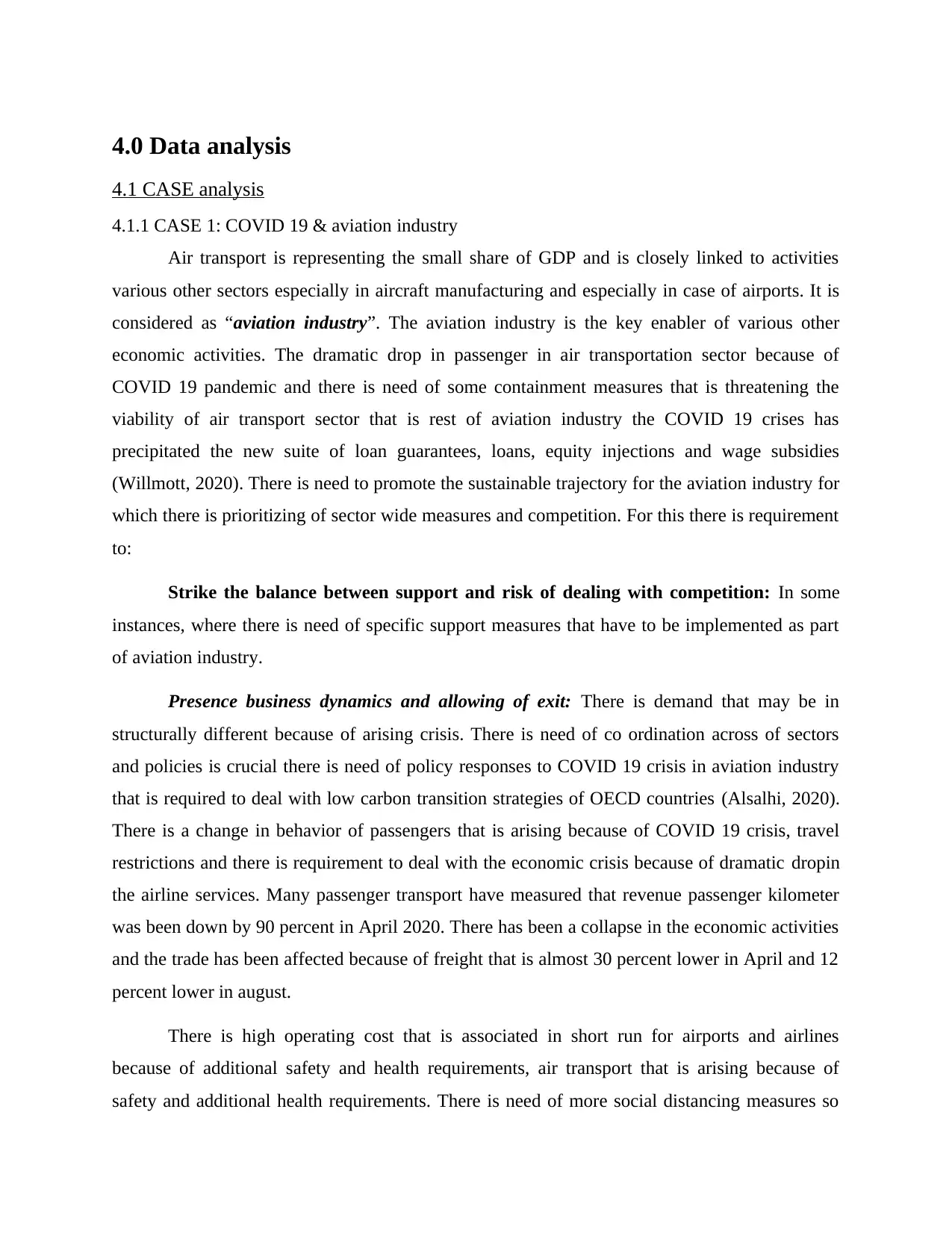
4.0 Data analysis
4.1 CASE analysis
4.1.1 CASE 1: COVID 19 & aviation industry
Air transport is representing the small share of GDP and is closely linked to activities
various other sectors especially in aircraft manufacturing and especially in case of airports. It is
considered as “aviation industry”. The aviation industry is the key enabler of various other
economic activities. The dramatic drop in passenger in air transportation sector because of
COVID 19 pandemic and there is need of some containment measures that is threatening the
viability of air transport sector that is rest of aviation industry the COVID 19 crises has
precipitated the new suite of loan guarantees, loans, equity injections and wage subsidies
(Willmott, 2020). There is need to promote the sustainable trajectory for the aviation industry for
which there is prioritizing of sector wide measures and competition. For this there is requirement
to:
Strike the balance between support and risk of dealing with competition: In some
instances, where there is need of specific support measures that have to be implemented as part
of aviation industry.
Presence business dynamics and allowing of exit: There is demand that may be in
structurally different because of arising crisis. There is need of co ordination across of sectors
and policies is crucial there is need of policy responses to COVID 19 crisis in aviation industry
that is required to deal with low carbon transition strategies of OECD countries (Alsalhi, 2020).
There is a change in behavior of passengers that is arising because of COVID 19 crisis, travel
restrictions and there is requirement to deal with the economic crisis because of dramatic dropin
the airline services. Many passenger transport have measured that revenue passenger kilometer
was been down by 90 percent in April 2020. There has been a collapse in the economic activities
and the trade has been affected because of freight that is almost 30 percent lower in April and 12
percent lower in august.
There is high operating cost that is associated in short run for airports and airlines
because of additional safety and health requirements, air transport that is arising because of
safety and additional health requirements. There is need of more social distancing measures so
4.1 CASE analysis
4.1.1 CASE 1: COVID 19 & aviation industry
Air transport is representing the small share of GDP and is closely linked to activities
various other sectors especially in aircraft manufacturing and especially in case of airports. It is
considered as “aviation industry”. The aviation industry is the key enabler of various other
economic activities. The dramatic drop in passenger in air transportation sector because of
COVID 19 pandemic and there is need of some containment measures that is threatening the
viability of air transport sector that is rest of aviation industry the COVID 19 crises has
precipitated the new suite of loan guarantees, loans, equity injections and wage subsidies
(Willmott, 2020). There is need to promote the sustainable trajectory for the aviation industry for
which there is prioritizing of sector wide measures and competition. For this there is requirement
to:
Strike the balance between support and risk of dealing with competition: In some
instances, where there is need of specific support measures that have to be implemented as part
of aviation industry.
Presence business dynamics and allowing of exit: There is demand that may be in
structurally different because of arising crisis. There is need of co ordination across of sectors
and policies is crucial there is need of policy responses to COVID 19 crisis in aviation industry
that is required to deal with low carbon transition strategies of OECD countries (Alsalhi, 2020).
There is a change in behavior of passengers that is arising because of COVID 19 crisis, travel
restrictions and there is requirement to deal with the economic crisis because of dramatic dropin
the airline services. Many passenger transport have measured that revenue passenger kilometer
was been down by 90 percent in April 2020. There has been a collapse in the economic activities
and the trade has been affected because of freight that is almost 30 percent lower in April and 12
percent lower in august.
There is high operating cost that is associated in short run for airports and airlines
because of additional safety and health requirements, air transport that is arising because of
safety and additional health requirements. There is need of more social distancing measures so
Secure Best Marks with AI Grader
Need help grading? Try our AI Grader for instant feedback on your assignments.
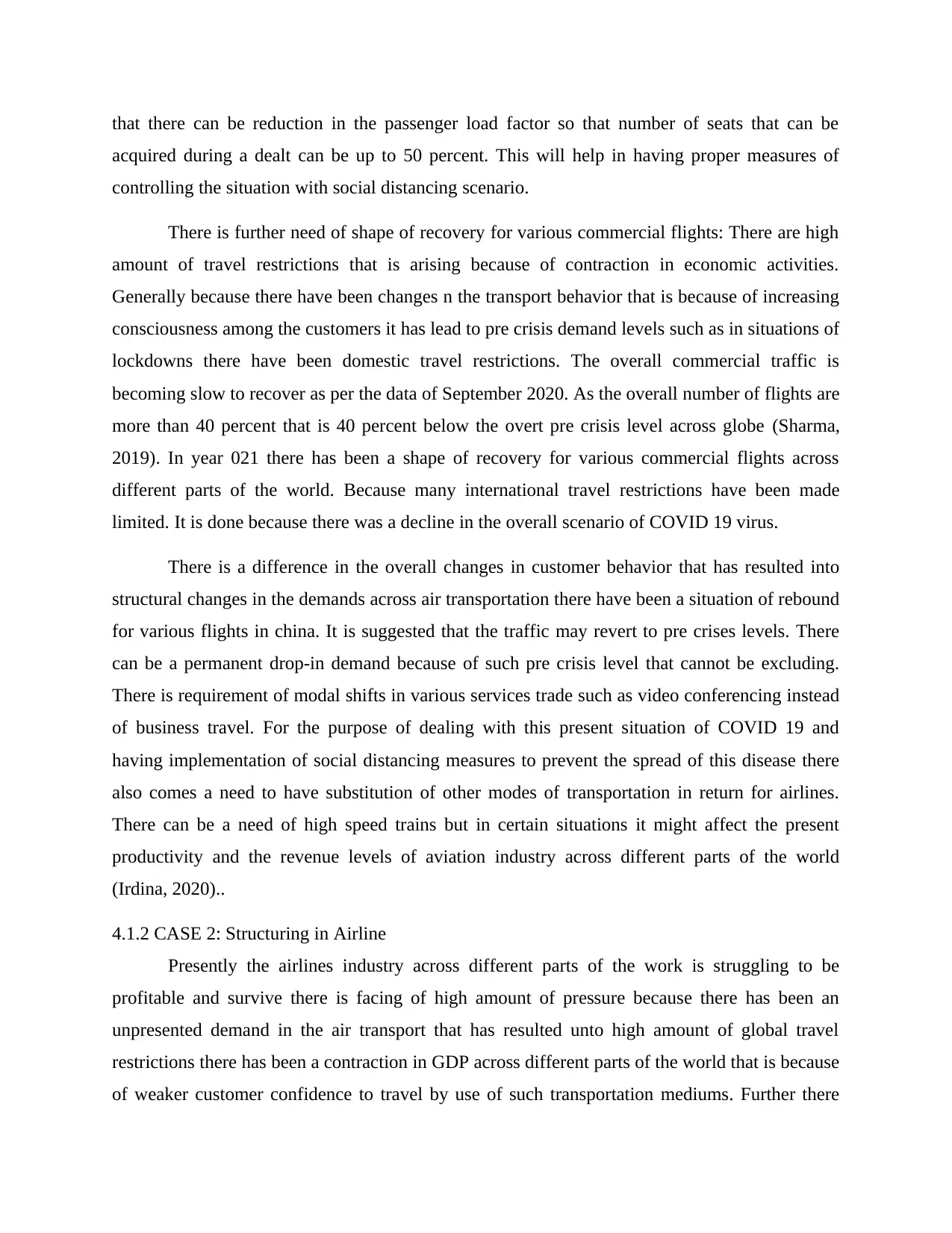
that there can be reduction in the passenger load factor so that number of seats that can be
acquired during a dealt can be up to 50 percent. This will help in having proper measures of
controlling the situation with social distancing scenario.
There is further need of shape of recovery for various commercial flights: There are high
amount of travel restrictions that is arising because of contraction in economic activities.
Generally because there have been changes n the transport behavior that is because of increasing
consciousness among the customers it has lead to pre crisis demand levels such as in situations of
lockdowns there have been domestic travel restrictions. The overall commercial traffic is
becoming slow to recover as per the data of September 2020. As the overall number of flights are
more than 40 percent that is 40 percent below the overt pre crisis level across globe (Sharma,
2019). In year 021 there has been a shape of recovery for various commercial flights across
different parts of the world. Because many international travel restrictions have been made
limited. It is done because there was a decline in the overall scenario of COVID 19 virus.
There is a difference in the overall changes in customer behavior that has resulted into
structural changes in the demands across air transportation there have been a situation of rebound
for various flights in china. It is suggested that the traffic may revert to pre crises levels. There
can be a permanent drop-in demand because of such pre crisis level that cannot be excluding.
There is requirement of modal shifts in various services trade such as video conferencing instead
of business travel. For the purpose of dealing with this present situation of COVID 19 and
having implementation of social distancing measures to prevent the spread of this disease there
also comes a need to have substitution of other modes of transportation in return for airlines.
There can be a need of high speed trains but in certain situations it might affect the present
productivity and the revenue levels of aviation industry across different parts of the world
(Irdina, 2020)..
4.1.2 CASE 2: Structuring in Airline
Presently the airlines industry across different parts of the work is struggling to be
profitable and survive there is facing of high amount of pressure because there has been an
unpresented demand in the air transport that has resulted unto high amount of global travel
restrictions there has been a contraction in GDP across different parts of the world that is because
of weaker customer confidence to travel by use of such transportation mediums. Further there
acquired during a dealt can be up to 50 percent. This will help in having proper measures of
controlling the situation with social distancing scenario.
There is further need of shape of recovery for various commercial flights: There are high
amount of travel restrictions that is arising because of contraction in economic activities.
Generally because there have been changes n the transport behavior that is because of increasing
consciousness among the customers it has lead to pre crisis demand levels such as in situations of
lockdowns there have been domestic travel restrictions. The overall commercial traffic is
becoming slow to recover as per the data of September 2020. As the overall number of flights are
more than 40 percent that is 40 percent below the overt pre crisis level across globe (Sharma,
2019). In year 021 there has been a shape of recovery for various commercial flights across
different parts of the world. Because many international travel restrictions have been made
limited. It is done because there was a decline in the overall scenario of COVID 19 virus.
There is a difference in the overall changes in customer behavior that has resulted into
structural changes in the demands across air transportation there have been a situation of rebound
for various flights in china. It is suggested that the traffic may revert to pre crises levels. There
can be a permanent drop-in demand because of such pre crisis level that cannot be excluding.
There is requirement of modal shifts in various services trade such as video conferencing instead
of business travel. For the purpose of dealing with this present situation of COVID 19 and
having implementation of social distancing measures to prevent the spread of this disease there
also comes a need to have substitution of other modes of transportation in return for airlines.
There can be a need of high speed trains but in certain situations it might affect the present
productivity and the revenue levels of aviation industry across different parts of the world
(Irdina, 2020)..
4.1.2 CASE 2: Structuring in Airline
Presently the airlines industry across different parts of the work is struggling to be
profitable and survive there is facing of high amount of pressure because there has been an
unpresented demand in the air transport that has resulted unto high amount of global travel
restrictions there has been a contraction in GDP across different parts of the world that is because
of weaker customer confidence to travel by use of such transportation mediums. Further there
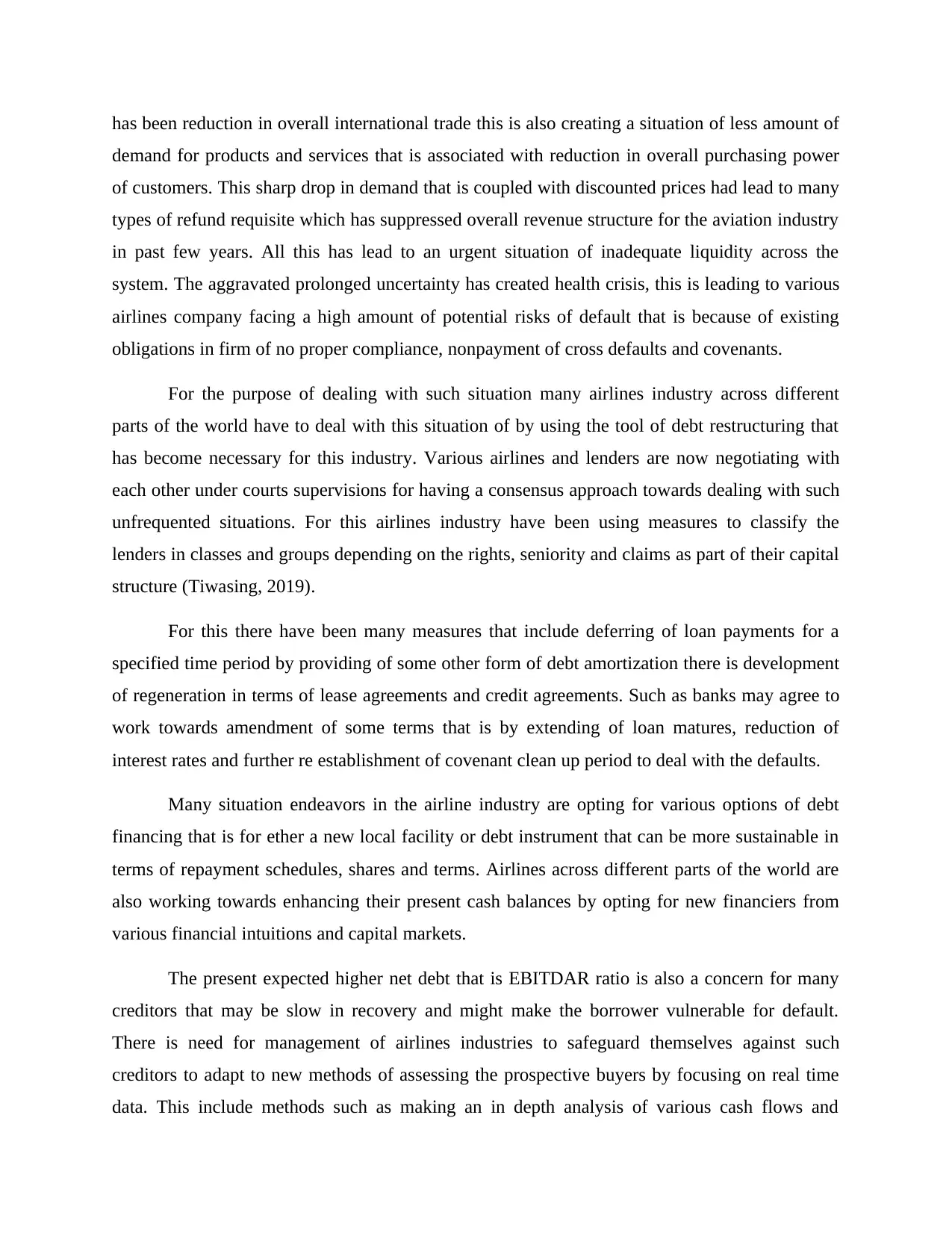
has been reduction in overall international trade this is also creating a situation of less amount of
demand for products and services that is associated with reduction in overall purchasing power
of customers. This sharp drop in demand that is coupled with discounted prices had lead to many
types of refund requisite which has suppressed overall revenue structure for the aviation industry
in past few years. All this has lead to an urgent situation of inadequate liquidity across the
system. The aggravated prolonged uncertainty has created health crisis, this is leading to various
airlines company facing a high amount of potential risks of default that is because of existing
obligations in firm of no proper compliance, nonpayment of cross defaults and covenants.
For the purpose of dealing with such situation many airlines industry across different
parts of the world have to deal with this situation of by using the tool of debt restructuring that
has become necessary for this industry. Various airlines and lenders are now negotiating with
each other under courts supervisions for having a consensus approach towards dealing with such
unfrequented situations. For this airlines industry have been using measures to classify the
lenders in classes and groups depending on the rights, seniority and claims as part of their capital
structure (Tiwasing, 2019).
For this there have been many measures that include deferring of loan payments for a
specified time period by providing of some other form of debt amortization there is development
of regeneration in terms of lease agreements and credit agreements. Such as banks may agree to
work towards amendment of some terms that is by extending of loan matures, reduction of
interest rates and further re establishment of covenant clean up period to deal with the defaults.
Many situation endeavors in the airline industry are opting for various options of debt
financing that is for ether a new local facility or debt instrument that can be more sustainable in
terms of repayment schedules, shares and terms. Airlines across different parts of the world are
also working towards enhancing their present cash balances by opting for new financiers from
various financial intuitions and capital markets.
The present expected higher net debt that is EBITDAR ratio is also a concern for many
creditors that may be slow in recovery and might make the borrower vulnerable for default.
There is need for management of airlines industries to safeguard themselves against such
creditors to adapt to new methods of assessing the prospective buyers by focusing on real time
data. This include methods such as making an in depth analysis of various cash flows and
demand for products and services that is associated with reduction in overall purchasing power
of customers. This sharp drop in demand that is coupled with discounted prices had lead to many
types of refund requisite which has suppressed overall revenue structure for the aviation industry
in past few years. All this has lead to an urgent situation of inadequate liquidity across the
system. The aggravated prolonged uncertainty has created health crisis, this is leading to various
airlines company facing a high amount of potential risks of default that is because of existing
obligations in firm of no proper compliance, nonpayment of cross defaults and covenants.
For the purpose of dealing with such situation many airlines industry across different
parts of the world have to deal with this situation of by using the tool of debt restructuring that
has become necessary for this industry. Various airlines and lenders are now negotiating with
each other under courts supervisions for having a consensus approach towards dealing with such
unfrequented situations. For this airlines industry have been using measures to classify the
lenders in classes and groups depending on the rights, seniority and claims as part of their capital
structure (Tiwasing, 2019).
For this there have been many measures that include deferring of loan payments for a
specified time period by providing of some other form of debt amortization there is development
of regeneration in terms of lease agreements and credit agreements. Such as banks may agree to
work towards amendment of some terms that is by extending of loan matures, reduction of
interest rates and further re establishment of covenant clean up period to deal with the defaults.
Many situation endeavors in the airline industry are opting for various options of debt
financing that is for ether a new local facility or debt instrument that can be more sustainable in
terms of repayment schedules, shares and terms. Airlines across different parts of the world are
also working towards enhancing their present cash balances by opting for new financiers from
various financial intuitions and capital markets.
The present expected higher net debt that is EBITDAR ratio is also a concern for many
creditors that may be slow in recovery and might make the borrower vulnerable for default.
There is need for management of airlines industries to safeguard themselves against such
creditors to adapt to new methods of assessing the prospective buyers by focusing on real time
data. This include methods such as making an in depth analysis of various cash flows and
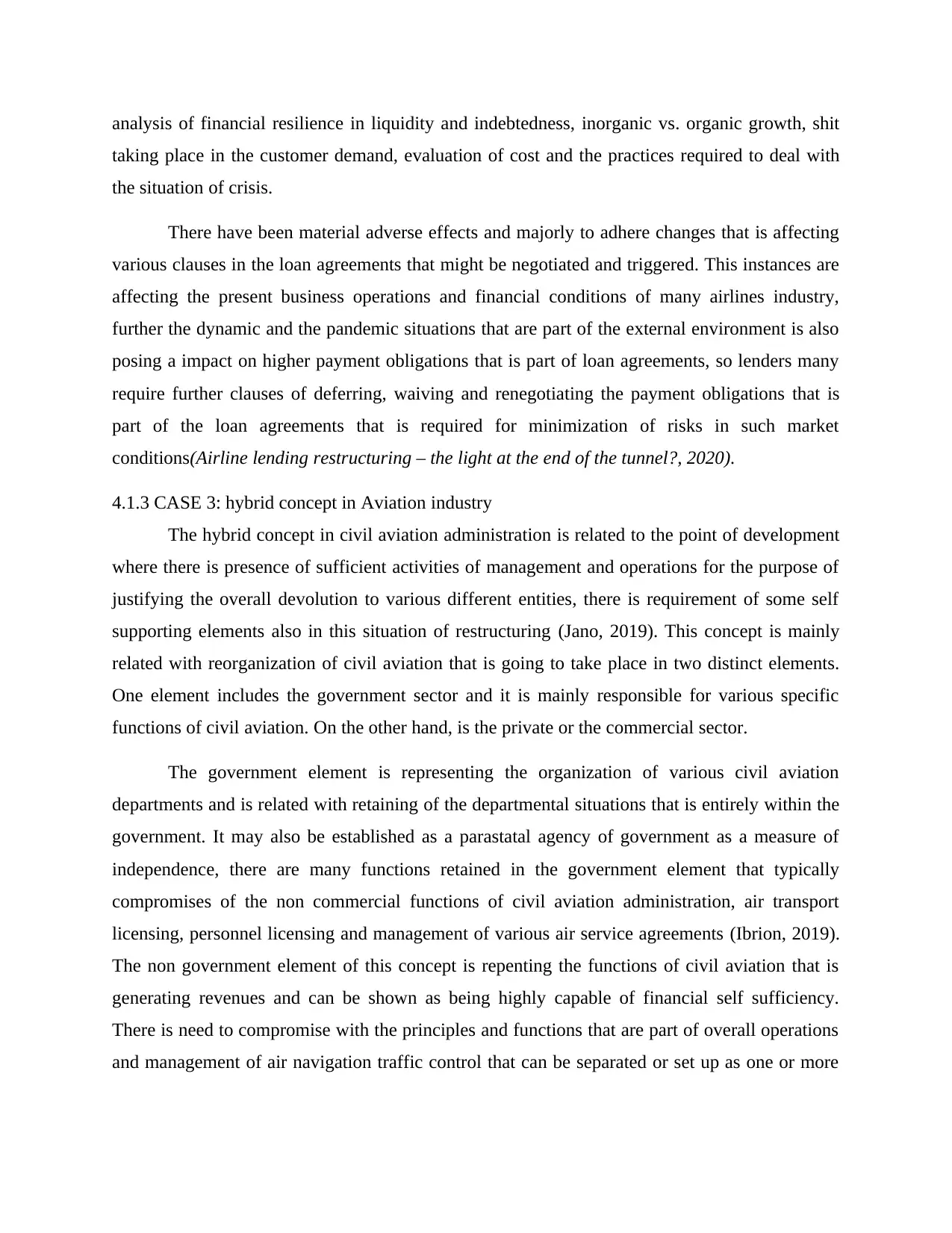
analysis of financial resilience in liquidity and indebtedness, inorganic vs. organic growth, shit
taking place in the customer demand, evaluation of cost and the practices required to deal with
the situation of crisis.
There have been material adverse effects and majorly to adhere changes that is affecting
various clauses in the loan agreements that might be negotiated and triggered. This instances are
affecting the present business operations and financial conditions of many airlines industry,
further the dynamic and the pandemic situations that are part of the external environment is also
posing a impact on higher payment obligations that is part of loan agreements, so lenders many
require further clauses of deferring, waiving and renegotiating the payment obligations that is
part of the loan agreements that is required for minimization of risks in such market
conditions(Airline lending restructuring – the light at the end of the tunnel?, 2020).
4.1.3 CASE 3: hybrid concept in Aviation industry
The hybrid concept in civil aviation administration is related to the point of development
where there is presence of sufficient activities of management and operations for the purpose of
justifying the overall devolution to various different entities, there is requirement of some self
supporting elements also in this situation of restructuring (Jano, 2019). This concept is mainly
related with reorganization of civil aviation that is going to take place in two distinct elements.
One element includes the government sector and it is mainly responsible for various specific
functions of civil aviation. On the other hand, is the private or the commercial sector.
The government element is representing the organization of various civil aviation
departments and is related with retaining of the departmental situations that is entirely within the
government. It may also be established as a parastatal agency of government as a measure of
independence, there are many functions retained in the government element that typically
compromises of the non commercial functions of civil aviation administration, air transport
licensing, personnel licensing and management of various air service agreements (Ibrion, 2019).
The non government element of this concept is repenting the functions of civil aviation that is
generating revenues and can be shown as being highly capable of financial self sufficiency.
There is need to compromise with the principles and functions that are part of overall operations
and management of air navigation traffic control that can be separated or set up as one or more
taking place in the customer demand, evaluation of cost and the practices required to deal with
the situation of crisis.
There have been material adverse effects and majorly to adhere changes that is affecting
various clauses in the loan agreements that might be negotiated and triggered. This instances are
affecting the present business operations and financial conditions of many airlines industry,
further the dynamic and the pandemic situations that are part of the external environment is also
posing a impact on higher payment obligations that is part of loan agreements, so lenders many
require further clauses of deferring, waiving and renegotiating the payment obligations that is
part of the loan agreements that is required for minimization of risks in such market
conditions(Airline lending restructuring – the light at the end of the tunnel?, 2020).
4.1.3 CASE 3: hybrid concept in Aviation industry
The hybrid concept in civil aviation administration is related to the point of development
where there is presence of sufficient activities of management and operations for the purpose of
justifying the overall devolution to various different entities, there is requirement of some self
supporting elements also in this situation of restructuring (Jano, 2019). This concept is mainly
related with reorganization of civil aviation that is going to take place in two distinct elements.
One element includes the government sector and it is mainly responsible for various specific
functions of civil aviation. On the other hand, is the private or the commercial sector.
The government element is representing the organization of various civil aviation
departments and is related with retaining of the departmental situations that is entirely within the
government. It may also be established as a parastatal agency of government as a measure of
independence, there are many functions retained in the government element that typically
compromises of the non commercial functions of civil aviation administration, air transport
licensing, personnel licensing and management of various air service agreements (Ibrion, 2019).
The non government element of this concept is repenting the functions of civil aviation that is
generating revenues and can be shown as being highly capable of financial self sufficiency.
There is need to compromise with the principles and functions that are part of overall operations
and management of air navigation traffic control that can be separated or set up as one or more
Paraphrase This Document
Need a fresh take? Get an instant paraphrase of this document with our AI Paraphraser
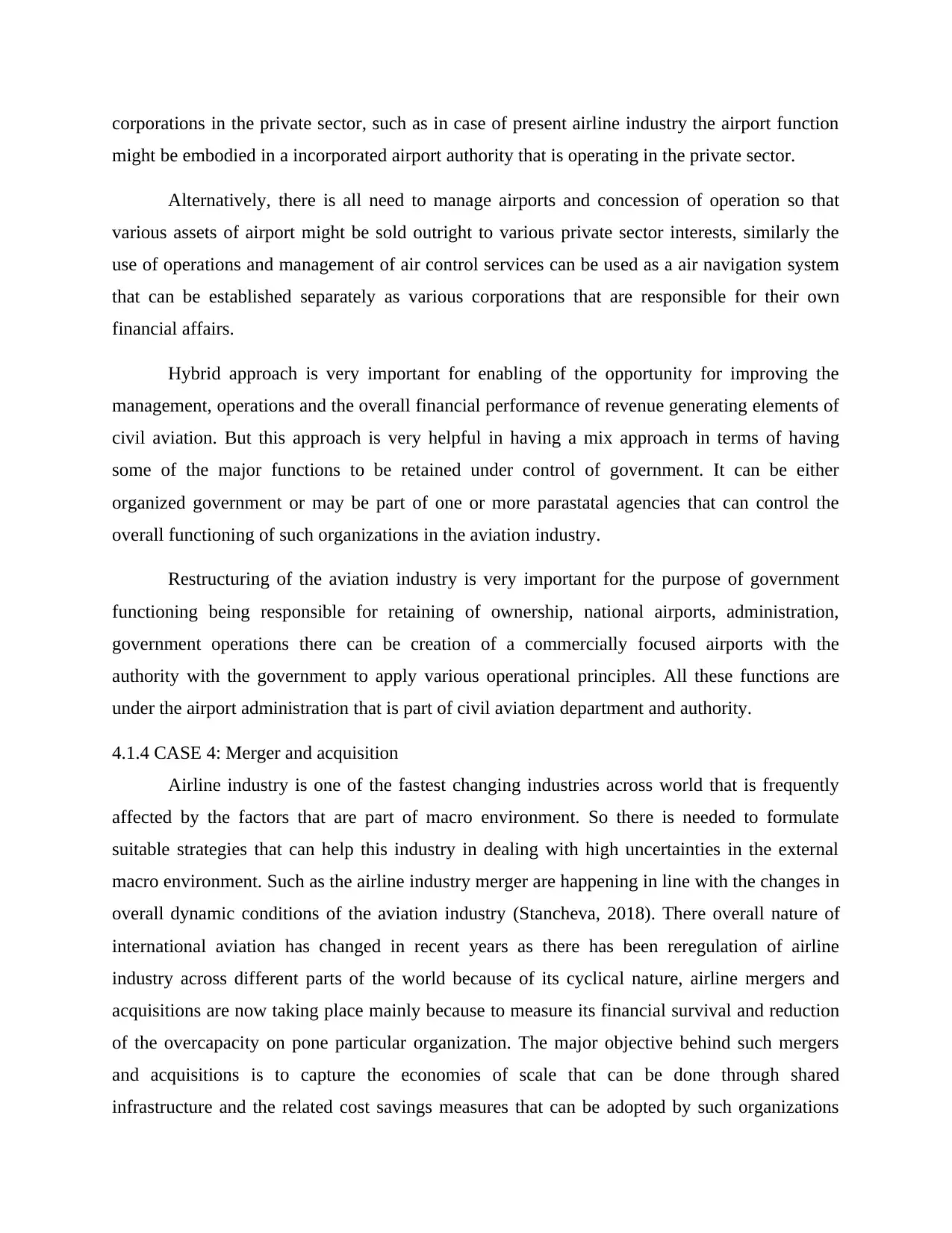
corporations in the private sector, such as in case of present airline industry the airport function
might be embodied in a incorporated airport authority that is operating in the private sector.
Alternatively, there is all need to manage airports and concession of operation so that
various assets of airport might be sold outright to various private sector interests, similarly the
use of operations and management of air control services can be used as a air navigation system
that can be established separately as various corporations that are responsible for their own
financial affairs.
Hybrid approach is very important for enabling of the opportunity for improving the
management, operations and the overall financial performance of revenue generating elements of
civil aviation. But this approach is very helpful in having a mix approach in terms of having
some of the major functions to be retained under control of government. It can be either
organized government or may be part of one or more parastatal agencies that can control the
overall functioning of such organizations in the aviation industry.
Restructuring of the aviation industry is very important for the purpose of government
functioning being responsible for retaining of ownership, national airports, administration,
government operations there can be creation of a commercially focused airports with the
authority with the government to apply various operational principles. All these functions are
under the airport administration that is part of civil aviation department and authority.
4.1.4 CASE 4: Merger and acquisition
Airline industry is one of the fastest changing industries across world that is frequently
affected by the factors that are part of macro environment. So there is needed to formulate
suitable strategies that can help this industry in dealing with high uncertainties in the external
macro environment. Such as the airline industry merger are happening in line with the changes in
overall dynamic conditions of the aviation industry (Stancheva, 2018). There overall nature of
international aviation has changed in recent years as there has been reregulation of airline
industry across different parts of the world because of its cyclical nature, airline mergers and
acquisitions are now taking place mainly because to measure its financial survival and reduction
of the overcapacity on pone particular organization. The major objective behind such mergers
and acquisitions is to capture the economies of scale that can be done through shared
infrastructure and the related cost savings measures that can be adopted by such organizations
might be embodied in a incorporated airport authority that is operating in the private sector.
Alternatively, there is all need to manage airports and concession of operation so that
various assets of airport might be sold outright to various private sector interests, similarly the
use of operations and management of air control services can be used as a air navigation system
that can be established separately as various corporations that are responsible for their own
financial affairs.
Hybrid approach is very important for enabling of the opportunity for improving the
management, operations and the overall financial performance of revenue generating elements of
civil aviation. But this approach is very helpful in having a mix approach in terms of having
some of the major functions to be retained under control of government. It can be either
organized government or may be part of one or more parastatal agencies that can control the
overall functioning of such organizations in the aviation industry.
Restructuring of the aviation industry is very important for the purpose of government
functioning being responsible for retaining of ownership, national airports, administration,
government operations there can be creation of a commercially focused airports with the
authority with the government to apply various operational principles. All these functions are
under the airport administration that is part of civil aviation department and authority.
4.1.4 CASE 4: Merger and acquisition
Airline industry is one of the fastest changing industries across world that is frequently
affected by the factors that are part of macro environment. So there is needed to formulate
suitable strategies that can help this industry in dealing with high uncertainties in the external
macro environment. Such as the airline industry merger are happening in line with the changes in
overall dynamic conditions of the aviation industry (Stancheva, 2018). There overall nature of
international aviation has changed in recent years as there has been reregulation of airline
industry across different parts of the world because of its cyclical nature, airline mergers and
acquisitions are now taking place mainly because to measure its financial survival and reduction
of the overcapacity on pone particular organization. The major objective behind such mergers
and acquisitions is to capture the economies of scale that can be done through shared
infrastructure and the related cost savings measures that can be adopted by such organizations
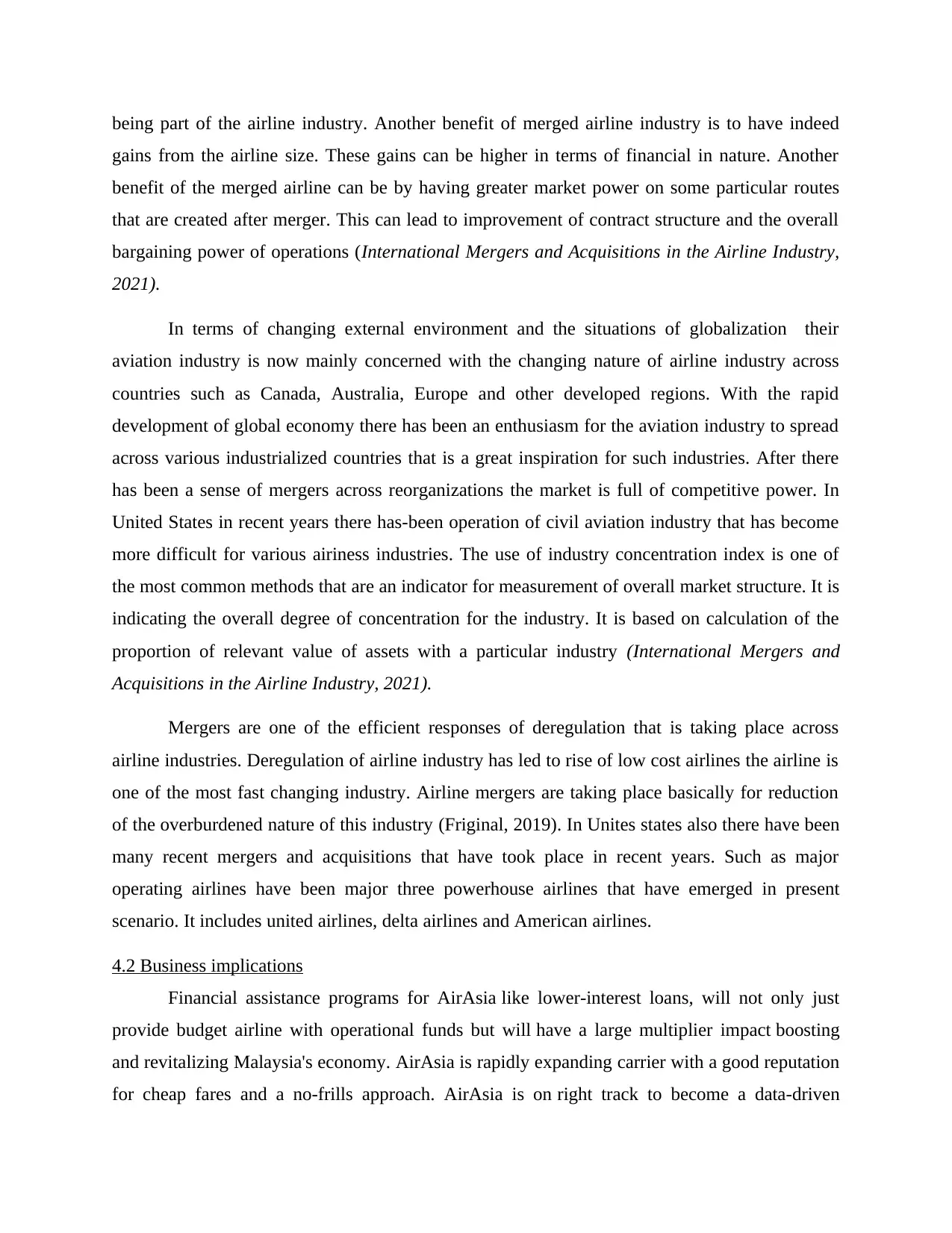
being part of the airline industry. Another benefit of merged airline industry is to have indeed
gains from the airline size. These gains can be higher in terms of financial in nature. Another
benefit of the merged airline can be by having greater market power on some particular routes
that are created after merger. This can lead to improvement of contract structure and the overall
bargaining power of operations (International Mergers and Acquisitions in the Airline Industry,
2021).
In terms of changing external environment and the situations of globalization their
aviation industry is now mainly concerned with the changing nature of airline industry across
countries such as Canada, Australia, Europe and other developed regions. With the rapid
development of global economy there has been an enthusiasm for the aviation industry to spread
across various industrialized countries that is a great inspiration for such industries. After there
has been a sense of mergers across reorganizations the market is full of competitive power. In
United States in recent years there has-been operation of civil aviation industry that has become
more difficult for various airiness industries. The use of industry concentration index is one of
the most common methods that are an indicator for measurement of overall market structure. It is
indicating the overall degree of concentration for the industry. It is based on calculation of the
proportion of relevant value of assets with a particular industry (International Mergers and
Acquisitions in the Airline Industry, 2021).
Mergers are one of the efficient responses of deregulation that is taking place across
airline industries. Deregulation of airline industry has led to rise of low cost airlines the airline is
one of the most fast changing industry. Airline mergers are taking place basically for reduction
of the overburdened nature of this industry (Friginal, 2019). In Unites states also there have been
many recent mergers and acquisitions that have took place in recent years. Such as major
operating airlines have been major three powerhouse airlines that have emerged in present
scenario. It includes united airlines, delta airlines and American airlines.
4.2 Business implications
Financial assistance programs for AirAsia like lower-interest loans, will not only just
provide budget airline with operational funds but will have a large multiplier impact boosting
and revitalizing Malaysia's economy. AirAsia is rapidly expanding carrier with a good reputation
for cheap fares and a no-frills approach. AirAsia is on right track to become a data-driven
gains from the airline size. These gains can be higher in terms of financial in nature. Another
benefit of the merged airline can be by having greater market power on some particular routes
that are created after merger. This can lead to improvement of contract structure and the overall
bargaining power of operations (International Mergers and Acquisitions in the Airline Industry,
2021).
In terms of changing external environment and the situations of globalization their
aviation industry is now mainly concerned with the changing nature of airline industry across
countries such as Canada, Australia, Europe and other developed regions. With the rapid
development of global economy there has been an enthusiasm for the aviation industry to spread
across various industrialized countries that is a great inspiration for such industries. After there
has been a sense of mergers across reorganizations the market is full of competitive power. In
United States in recent years there has-been operation of civil aviation industry that has become
more difficult for various airiness industries. The use of industry concentration index is one of
the most common methods that are an indicator for measurement of overall market structure. It is
indicating the overall degree of concentration for the industry. It is based on calculation of the
proportion of relevant value of assets with a particular industry (International Mergers and
Acquisitions in the Airline Industry, 2021).
Mergers are one of the efficient responses of deregulation that is taking place across
airline industries. Deregulation of airline industry has led to rise of low cost airlines the airline is
one of the most fast changing industry. Airline mergers are taking place basically for reduction
of the overburdened nature of this industry (Friginal, 2019). In Unites states also there have been
many recent mergers and acquisitions that have took place in recent years. Such as major
operating airlines have been major three powerhouse airlines that have emerged in present
scenario. It includes united airlines, delta airlines and American airlines.
4.2 Business implications
Financial assistance programs for AirAsia like lower-interest loans, will not only just
provide budget airline with operational funds but will have a large multiplier impact boosting
and revitalizing Malaysia's economy. AirAsia is rapidly expanding carrier with a good reputation
for cheap fares and a no-frills approach. AirAsia is on right track to become a data-driven

business. The business has completely realized the promise of Google Cloud which is supporting
its efforts to transform into digital-first Company those profits from collaboration.
its efforts to transform into digital-first Company those profits from collaboration.
Secure Best Marks with AI Grader
Need help grading? Try our AI Grader for instant feedback on your assignments.
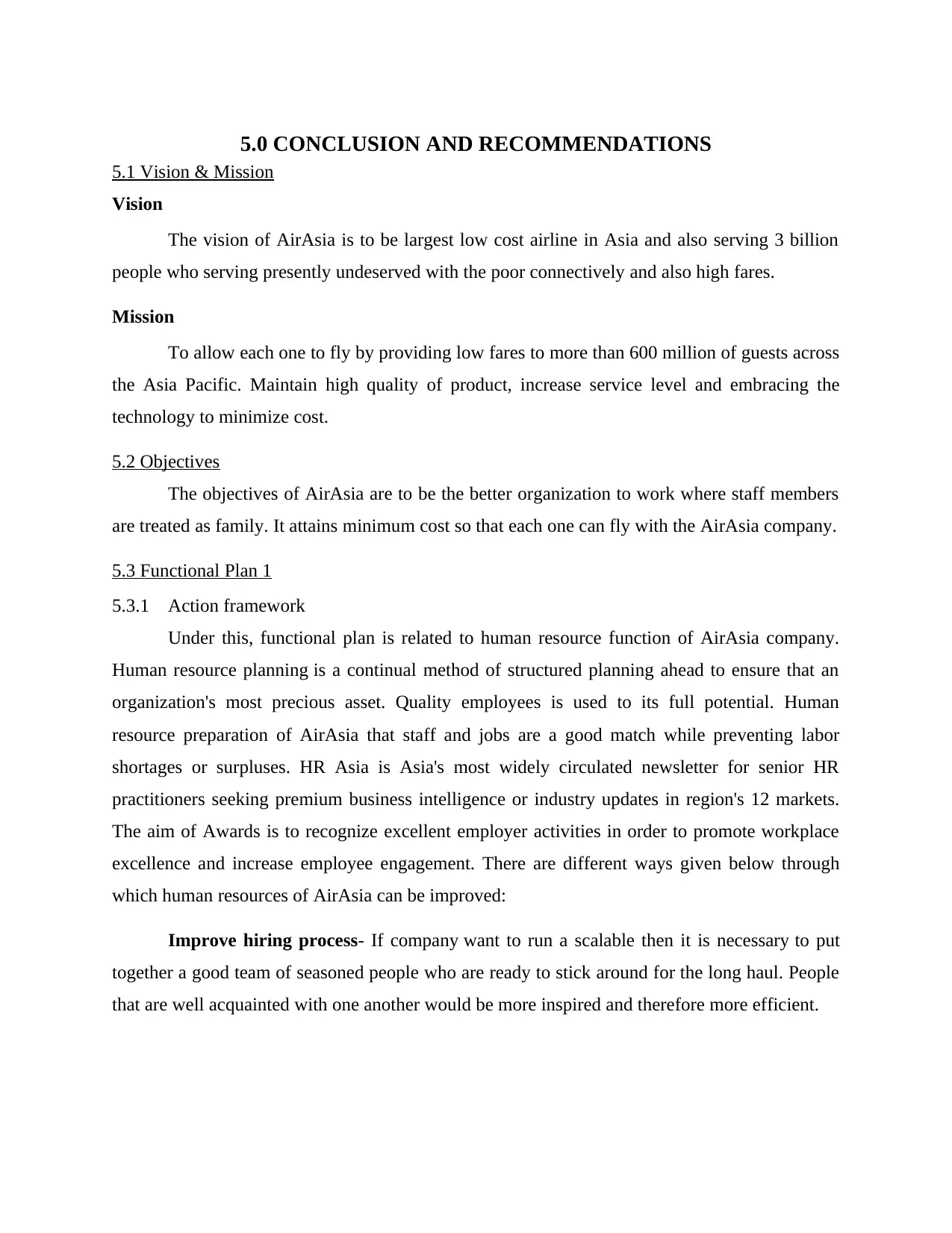
5.0 CONCLUSION AND RECOMMENDATIONS
5.1 Vision & Mission
Vision
The vision of AirAsia is to be largest low cost airline in Asia and also serving 3 billion
people who serving presently undeserved with the poor connectively and also high fares.
Mission
To allow each one to fly by providing low fares to more than 600 million of guests across
the Asia Pacific. Maintain high quality of product, increase service level and embracing the
technology to minimize cost.
5.2 Objectives
The objectives of AirAsia are to be the better organization to work where staff members
are treated as family. It attains minimum cost so that each one can fly with the AirAsia company.
5.3 Functional Plan 1
5.3.1 Action framework
Under this, functional plan is related to human resource function of AirAsia company.
Human resource planning is a continual method of structured planning ahead to ensure that an
organization's most precious asset. Quality employees is used to its full potential. Human
resource preparation of AirAsia that staff and jobs are a good match while preventing labor
shortages or surpluses. HR Asia is Asia's most widely circulated newsletter for senior HR
practitioners seeking premium business intelligence or industry updates in region's 12 markets.
The aim of Awards is to recognize excellent employer activities in order to promote workplace
excellence and increase employee engagement. There are different ways given below through
which human resources of AirAsia can be improved:
Improve hiring process- If company want to run a scalable then it is necessary to put
together a good team of seasoned people who are ready to stick around for the long haul. People
that are well acquainted with one another would be more inspired and therefore more efficient.
5.1 Vision & Mission
Vision
The vision of AirAsia is to be largest low cost airline in Asia and also serving 3 billion
people who serving presently undeserved with the poor connectively and also high fares.
Mission
To allow each one to fly by providing low fares to more than 600 million of guests across
the Asia Pacific. Maintain high quality of product, increase service level and embracing the
technology to minimize cost.
5.2 Objectives
The objectives of AirAsia are to be the better organization to work where staff members
are treated as family. It attains minimum cost so that each one can fly with the AirAsia company.
5.3 Functional Plan 1
5.3.1 Action framework
Under this, functional plan is related to human resource function of AirAsia company.
Human resource planning is a continual method of structured planning ahead to ensure that an
organization's most precious asset. Quality employees is used to its full potential. Human
resource preparation of AirAsia that staff and jobs are a good match while preventing labor
shortages or surpluses. HR Asia is Asia's most widely circulated newsletter for senior HR
practitioners seeking premium business intelligence or industry updates in region's 12 markets.
The aim of Awards is to recognize excellent employer activities in order to promote workplace
excellence and increase employee engagement. There are different ways given below through
which human resources of AirAsia can be improved:
Improve hiring process- If company want to run a scalable then it is necessary to put
together a good team of seasoned people who are ready to stick around for the long haul. People
that are well acquainted with one another would be more inspired and therefore more efficient.
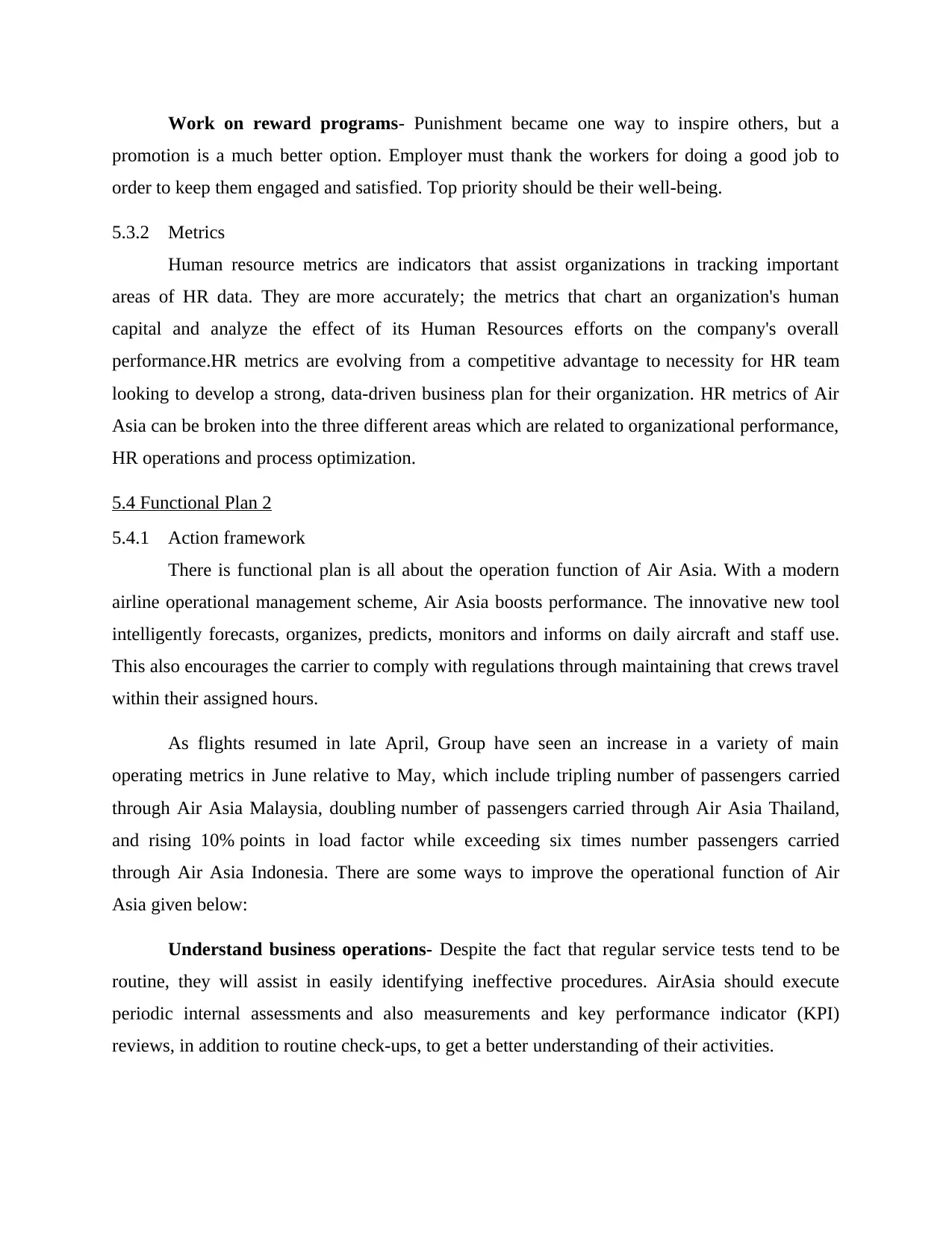
Work on reward programs- Punishment became one way to inspire others, but a
promotion is a much better option. Employer must thank the workers for doing a good job to
order to keep them engaged and satisfied. Top priority should be their well-being.
5.3.2 Metrics
Human resource metrics are indicators that assist organizations in tracking important
areas of HR data. They are more accurately; the metrics that chart an organization's human
capital and analyze the effect of its Human Resources efforts on the company's overall
performance.HR metrics are evolving from a competitive advantage to necessity for HR team
looking to develop a strong, data-driven business plan for their organization. HR metrics of Air
Asia can be broken into the three different areas which are related to organizational performance,
HR operations and process optimization.
5.4 Functional Plan 2
5.4.1 Action framework
There is functional plan is all about the operation function of Air Asia. With a modern
airline operational management scheme, Air Asia boosts performance. The innovative new tool
intelligently forecasts, organizes, predicts, monitors and informs on daily aircraft and staff use.
This also encourages the carrier to comply with regulations through maintaining that crews travel
within their assigned hours.
As flights resumed in late April, Group have seen an increase in a variety of main
operating metrics in June relative to May, which include tripling number of passengers carried
through Air Asia Malaysia, doubling number of passengers carried through Air Asia Thailand,
and rising 10% points in load factor while exceeding six times number passengers carried
through Air Asia Indonesia. There are some ways to improve the operational function of Air
Asia given below:
Understand business operations- Despite the fact that regular service tests tend to be
routine, they will assist in easily identifying ineffective procedures. AirAsia should execute
periodic internal assessments and also measurements and key performance indicator (KPI)
reviews, in addition to routine check-ups, to get a better understanding of their activities.
promotion is a much better option. Employer must thank the workers for doing a good job to
order to keep them engaged and satisfied. Top priority should be their well-being.
5.3.2 Metrics
Human resource metrics are indicators that assist organizations in tracking important
areas of HR data. They are more accurately; the metrics that chart an organization's human
capital and analyze the effect of its Human Resources efforts on the company's overall
performance.HR metrics are evolving from a competitive advantage to necessity for HR team
looking to develop a strong, data-driven business plan for their organization. HR metrics of Air
Asia can be broken into the three different areas which are related to organizational performance,
HR operations and process optimization.
5.4 Functional Plan 2
5.4.1 Action framework
There is functional plan is all about the operation function of Air Asia. With a modern
airline operational management scheme, Air Asia boosts performance. The innovative new tool
intelligently forecasts, organizes, predicts, monitors and informs on daily aircraft and staff use.
This also encourages the carrier to comply with regulations through maintaining that crews travel
within their assigned hours.
As flights resumed in late April, Group have seen an increase in a variety of main
operating metrics in June relative to May, which include tripling number of passengers carried
through Air Asia Malaysia, doubling number of passengers carried through Air Asia Thailand,
and rising 10% points in load factor while exceeding six times number passengers carried
through Air Asia Indonesia. There are some ways to improve the operational function of Air
Asia given below:
Understand business operations- Despite the fact that regular service tests tend to be
routine, they will assist in easily identifying ineffective procedures. AirAsia should execute
periodic internal assessments and also measurements and key performance indicator (KPI)
reviews, in addition to routine check-ups, to get a better understanding of their activities.
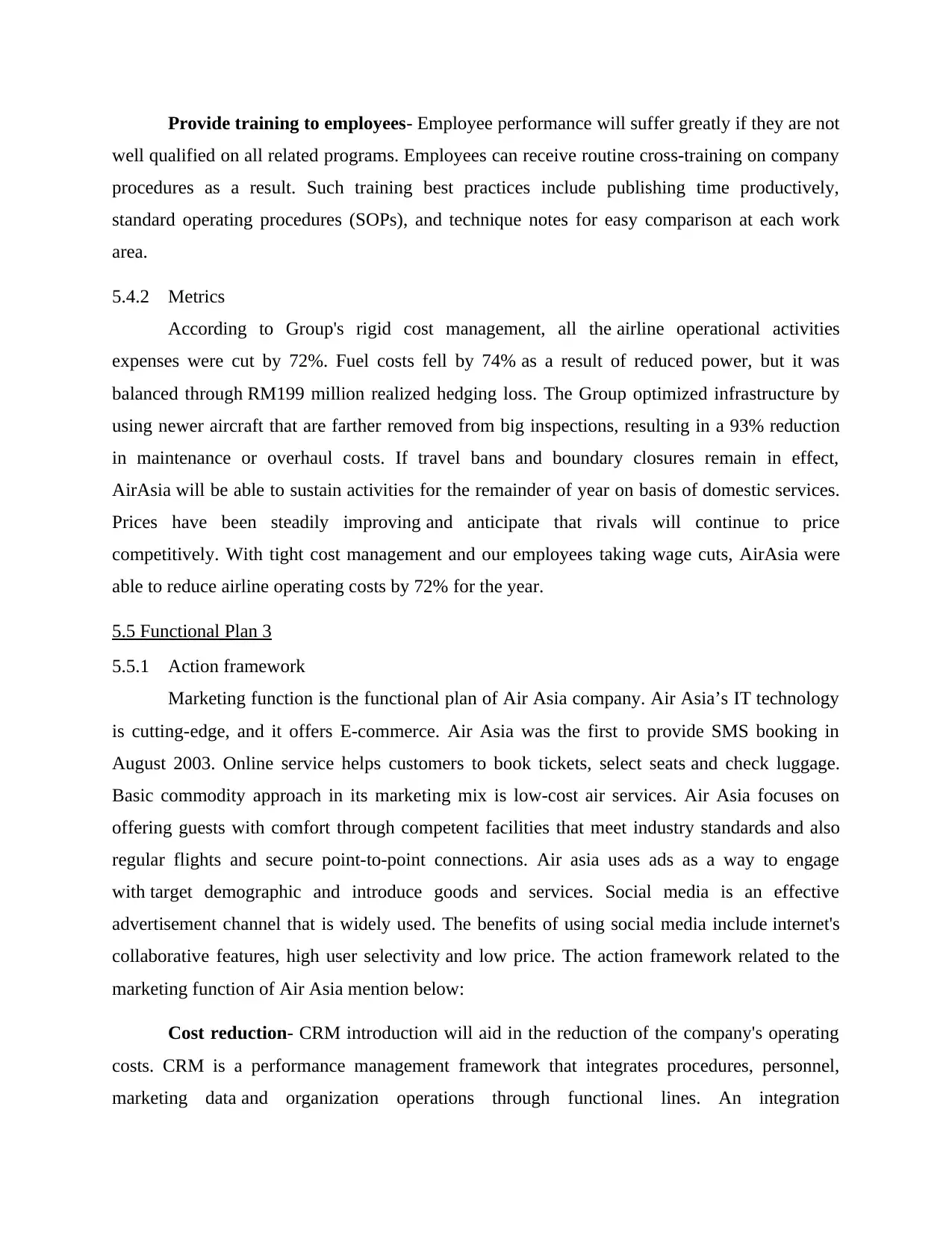
Provide training to employees- Employee performance will suffer greatly if they are not
well qualified on all related programs. Employees can receive routine cross-training on company
procedures as a result. Such training best practices include publishing time productively,
standard operating procedures (SOPs), and technique notes for easy comparison at each work
area.
5.4.2 Metrics
According to Group's rigid cost management, all the airline operational activities
expenses were cut by 72%. Fuel costs fell by 74% as a result of reduced power, but it was
balanced through RM199 million realized hedging loss. The Group optimized infrastructure by
using newer aircraft that are farther removed from big inspections, resulting in a 93% reduction
in maintenance or overhaul costs. If travel bans and boundary closures remain in effect,
AirAsia will be able to sustain activities for the remainder of year on basis of domestic services.
Prices have been steadily improving and anticipate that rivals will continue to price
competitively. With tight cost management and our employees taking wage cuts, AirAsia were
able to reduce airline operating costs by 72% for the year.
5.5 Functional Plan 3
5.5.1 Action framework
Marketing function is the functional plan of Air Asia company. Air Asia’s IT technology
is cutting-edge, and it offers E-commerce. Air Asia was the first to provide SMS booking in
August 2003. Online service helps customers to book tickets, select seats and check luggage.
Basic commodity approach in its marketing mix is low-cost air services. Air Asia focuses on
offering guests with comfort through competent facilities that meet industry standards and also
regular flights and secure point-to-point connections. Air asia uses ads as a way to engage
with target demographic and introduce goods and services. Social media is an effective
advertisement channel that is widely used. The benefits of using social media include internet's
collaborative features, high user selectivity and low price. The action framework related to the
marketing function of Air Asia mention below:
Cost reduction- CRM introduction will aid in the reduction of the company's operating
costs. CRM is a performance management framework that integrates procedures, personnel,
marketing data and organization operations through functional lines. An integration
well qualified on all related programs. Employees can receive routine cross-training on company
procedures as a result. Such training best practices include publishing time productively,
standard operating procedures (SOPs), and technique notes for easy comparison at each work
area.
5.4.2 Metrics
According to Group's rigid cost management, all the airline operational activities
expenses were cut by 72%. Fuel costs fell by 74% as a result of reduced power, but it was
balanced through RM199 million realized hedging loss. The Group optimized infrastructure by
using newer aircraft that are farther removed from big inspections, resulting in a 93% reduction
in maintenance or overhaul costs. If travel bans and boundary closures remain in effect,
AirAsia will be able to sustain activities for the remainder of year on basis of domestic services.
Prices have been steadily improving and anticipate that rivals will continue to price
competitively. With tight cost management and our employees taking wage cuts, AirAsia were
able to reduce airline operating costs by 72% for the year.
5.5 Functional Plan 3
5.5.1 Action framework
Marketing function is the functional plan of Air Asia company. Air Asia’s IT technology
is cutting-edge, and it offers E-commerce. Air Asia was the first to provide SMS booking in
August 2003. Online service helps customers to book tickets, select seats and check luggage.
Basic commodity approach in its marketing mix is low-cost air services. Air Asia focuses on
offering guests with comfort through competent facilities that meet industry standards and also
regular flights and secure point-to-point connections. Air asia uses ads as a way to engage
with target demographic and introduce goods and services. Social media is an effective
advertisement channel that is widely used. The benefits of using social media include internet's
collaborative features, high user selectivity and low price. The action framework related to the
marketing function of Air Asia mention below:
Cost reduction- CRM introduction will aid in the reduction of the company's operating
costs. CRM is a performance management framework that integrates procedures, personnel,
marketing data and organization operations through functional lines. An integration
Paraphrase This Document
Need a fresh take? Get an instant paraphrase of this document with our AI Paraphraser
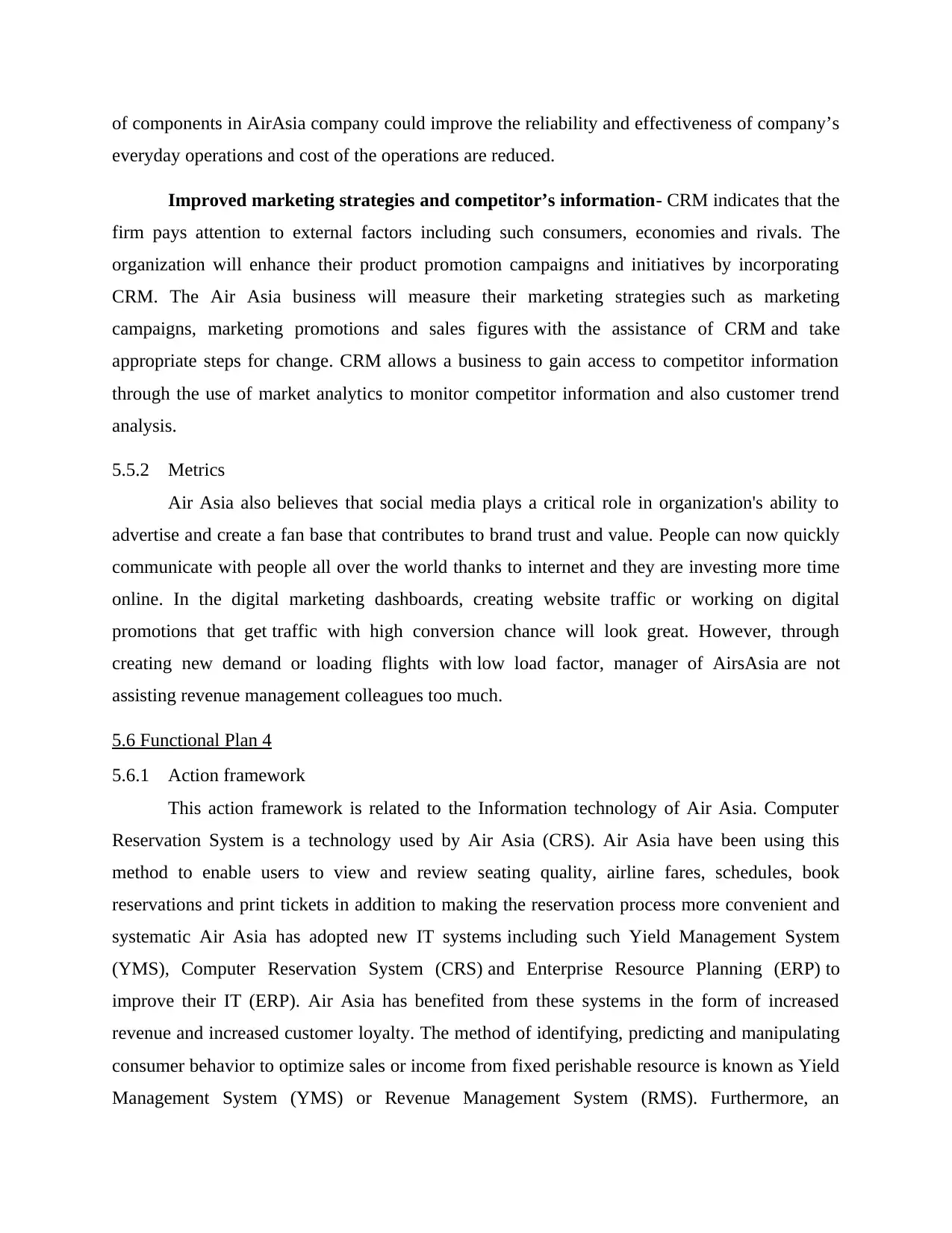
of components in AirAsia company could improve the reliability and effectiveness of company’s
everyday operations and cost of the operations are reduced.
Improved marketing strategies and competitor’s information- CRM indicates that the
firm pays attention to external factors including such consumers, economies and rivals. The
organization will enhance their product promotion campaigns and initiatives by incorporating
CRM. The Air Asia business will measure their marketing strategies such as marketing
campaigns, marketing promotions and sales figures with the assistance of CRM and take
appropriate steps for change. CRM allows a business to gain access to competitor information
through the use of market analytics to monitor competitor information and also customer trend
analysis.
5.5.2 Metrics
Air Asia also believes that social media plays a critical role in organization's ability to
advertise and create a fan base that contributes to brand trust and value. People can now quickly
communicate with people all over the world thanks to internet and they are investing more time
online. In the digital marketing dashboards, creating website traffic or working on digital
promotions that get traffic with high conversion chance will look great. However, through
creating new demand or loading flights with low load factor, manager of AirsAsia are not
assisting revenue management colleagues too much.
5.6 Functional Plan 4
5.6.1 Action framework
This action framework is related to the Information technology of Air Asia. Computer
Reservation System is a technology used by Air Asia (CRS). Air Asia have been using this
method to enable users to view and review seating quality, airline fares, schedules, book
reservations and print tickets in addition to making the reservation process more convenient and
systematic Air Asia has adopted new IT systems including such Yield Management System
(YMS), Computer Reservation System (CRS) and Enterprise Resource Planning (ERP) to
improve their IT (ERP). Air Asia has benefited from these systems in the form of increased
revenue and increased customer loyalty. The method of identifying, predicting and manipulating
consumer behavior to optimize sales or income from fixed perishable resource is known as Yield
Management System (YMS) or Revenue Management System (RMS). Furthermore, an
everyday operations and cost of the operations are reduced.
Improved marketing strategies and competitor’s information- CRM indicates that the
firm pays attention to external factors including such consumers, economies and rivals. The
organization will enhance their product promotion campaigns and initiatives by incorporating
CRM. The Air Asia business will measure their marketing strategies such as marketing
campaigns, marketing promotions and sales figures with the assistance of CRM and take
appropriate steps for change. CRM allows a business to gain access to competitor information
through the use of market analytics to monitor competitor information and also customer trend
analysis.
5.5.2 Metrics
Air Asia also believes that social media plays a critical role in organization's ability to
advertise and create a fan base that contributes to brand trust and value. People can now quickly
communicate with people all over the world thanks to internet and they are investing more time
online. In the digital marketing dashboards, creating website traffic or working on digital
promotions that get traffic with high conversion chance will look great. However, through
creating new demand or loading flights with low load factor, manager of AirsAsia are not
assisting revenue management colleagues too much.
5.6 Functional Plan 4
5.6.1 Action framework
This action framework is related to the Information technology of Air Asia. Computer
Reservation System is a technology used by Air Asia (CRS). Air Asia have been using this
method to enable users to view and review seating quality, airline fares, schedules, book
reservations and print tickets in addition to making the reservation process more convenient and
systematic Air Asia has adopted new IT systems including such Yield Management System
(YMS), Computer Reservation System (CRS) and Enterprise Resource Planning (ERP) to
improve their IT (ERP). Air Asia has benefited from these systems in the form of increased
revenue and increased customer loyalty. The method of identifying, predicting and manipulating
consumer behavior to optimize sales or income from fixed perishable resource is known as Yield
Management System (YMS) or Revenue Management System (RMS). Furthermore, an
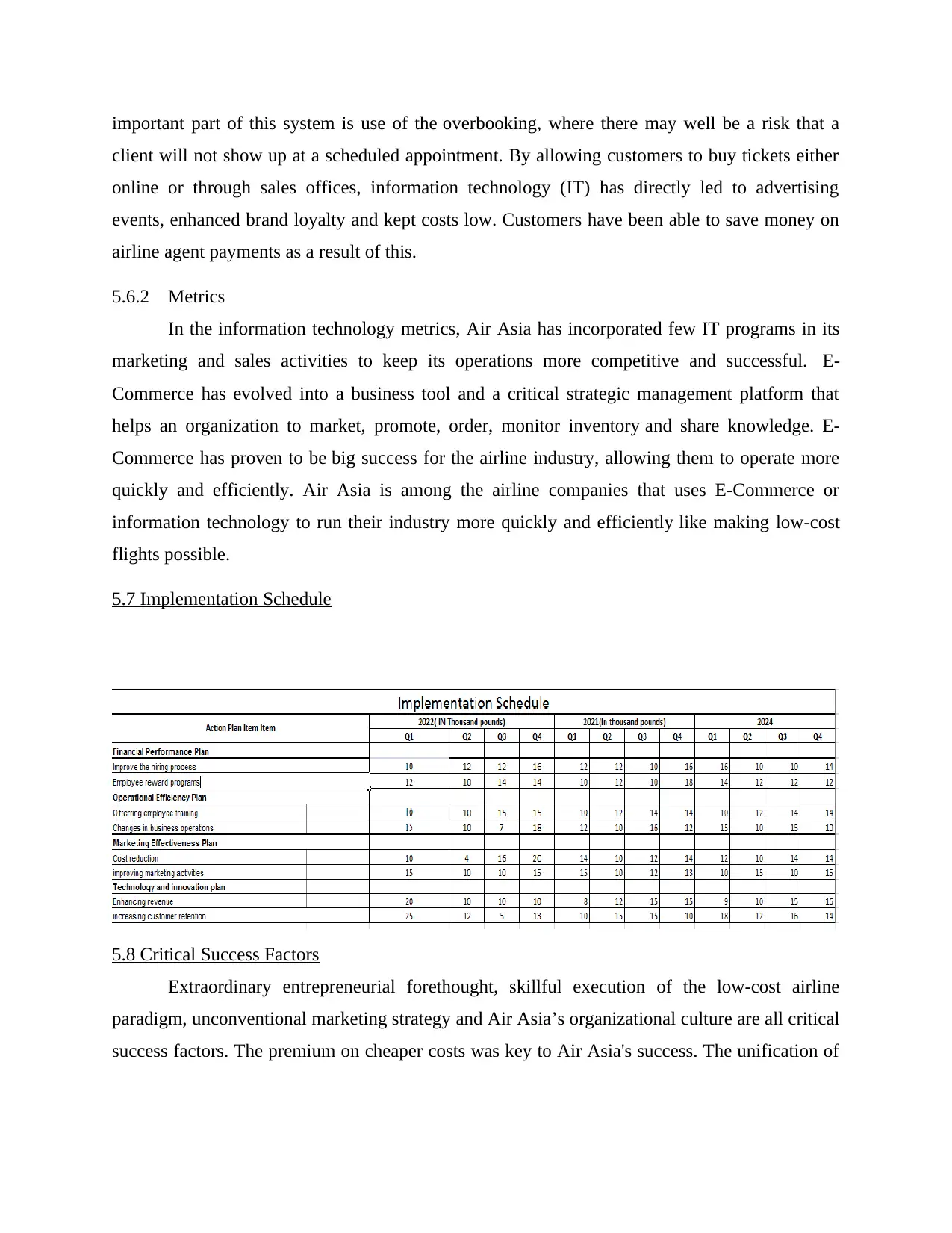
important part of this system is use of the overbooking, where there may well be a risk that a
client will not show up at a scheduled appointment. By allowing customers to buy tickets either
online or through sales offices, information technology (IT) has directly led to advertising
events, enhanced brand loyalty and kept costs low. Customers have been able to save money on
airline agent payments as a result of this.
5.6.2 Metrics
In the information technology metrics, Air Asia has incorporated few IT programs in its
marketing and sales activities to keep its operations more competitive and successful. E-
Commerce has evolved into a business tool and a critical strategic management platform that
helps an organization to market, promote, order, monitor inventory and share knowledge. E-
Commerce has proven to be big success for the airline industry, allowing them to operate more
quickly and efficiently. Air Asia is among the airline companies that uses E-Commerce or
information technology to run their industry more quickly and efficiently like making low-cost
flights possible.
5.7 Implementation Schedule
5.8 Critical Success Factors
Extraordinary entrepreneurial forethought, skillful execution of the low-cost airline
paradigm, unconventional marketing strategy and Air Asia’s organizational culture are all critical
success factors. The premium on cheaper costs was key to Air Asia's success. The unification of
client will not show up at a scheduled appointment. By allowing customers to buy tickets either
online or through sales offices, information technology (IT) has directly led to advertising
events, enhanced brand loyalty and kept costs low. Customers have been able to save money on
airline agent payments as a result of this.
5.6.2 Metrics
In the information technology metrics, Air Asia has incorporated few IT programs in its
marketing and sales activities to keep its operations more competitive and successful. E-
Commerce has evolved into a business tool and a critical strategic management platform that
helps an organization to market, promote, order, monitor inventory and share knowledge. E-
Commerce has proven to be big success for the airline industry, allowing them to operate more
quickly and efficiently. Air Asia is among the airline companies that uses E-Commerce or
information technology to run their industry more quickly and efficiently like making low-cost
flights possible.
5.7 Implementation Schedule
5.8 Critical Success Factors
Extraordinary entrepreneurial forethought, skillful execution of the low-cost airline
paradigm, unconventional marketing strategy and Air Asia’s organizational culture are all critical
success factors. The premium on cheaper costs was key to Air Asia's success. The unification of
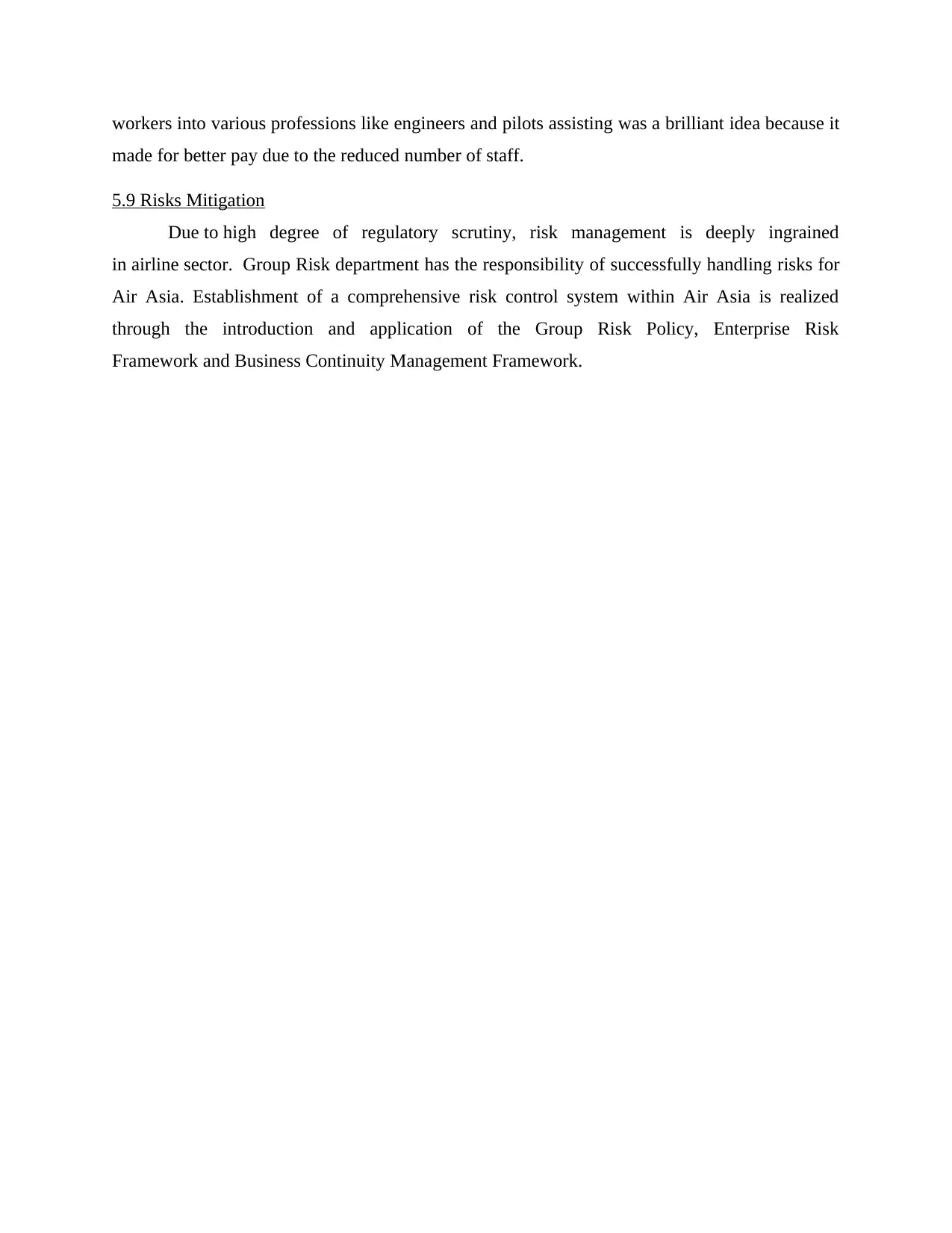
workers into various professions like engineers and pilots assisting was a brilliant idea because it
made for better pay due to the reduced number of staff.
5.9 Risks Mitigation
Due to high degree of regulatory scrutiny, risk management is deeply ingrained
in airline sector. Group Risk department has the responsibility of successfully handling risks for
Air Asia. Establishment of a comprehensive risk control system within Air Asia is realized
through the introduction and application of the Group Risk Policy, Enterprise Risk
Framework and Business Continuity Management Framework.
made for better pay due to the reduced number of staff.
5.9 Risks Mitigation
Due to high degree of regulatory scrutiny, risk management is deeply ingrained
in airline sector. Group Risk department has the responsibility of successfully handling risks for
Air Asia. Establishment of a comprehensive risk control system within Air Asia is realized
through the introduction and application of the Group Risk Policy, Enterprise Risk
Framework and Business Continuity Management Framework.
Secure Best Marks with AI Grader
Need help grading? Try our AI Grader for instant feedback on your assignments.
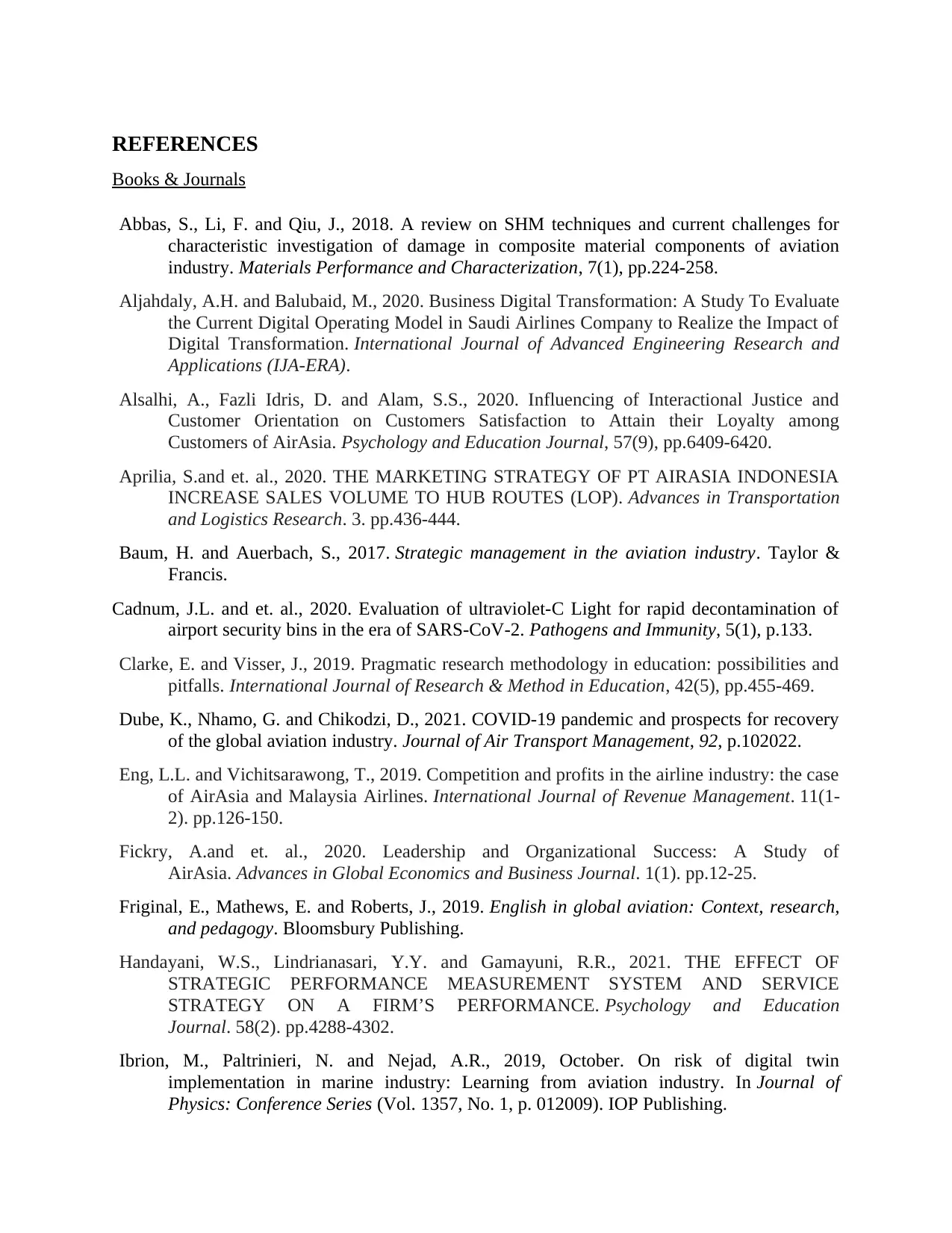
REFERENCES
Books & Journals
Abbas, S., Li, F. and Qiu, J., 2018. A review on SHM techniques and current challenges for
characteristic investigation of damage in composite material components of aviation
industry. Materials Performance and Characterization, 7(1), pp.224-258.
Aljahdaly, A.H. and Balubaid, M., 2020. Business Digital Transformation: A Study To Evaluate
the Current Digital Operating Model in Saudi Airlines Company to Realize the Impact of
Digital Transformation. International Journal of Advanced Engineering Research and
Applications (IJA-ERA).
Alsalhi, A., Fazli Idris, D. and Alam, S.S., 2020. Influencing of Interactional Justice and
Customer Orientation on Customers Satisfaction to Attain their Loyalty among
Customers of AirAsia. Psychology and Education Journal, 57(9), pp.6409-6420.
Aprilia, S.and et. al., 2020. THE MARKETING STRATEGY OF PT AIRASIA INDONESIA
INCREASE SALES VOLUME TO HUB ROUTES (LOP). Advances in Transportation
and Logistics Research. 3. pp.436-444.
Baum, H. and Auerbach, S., 2017. Strategic management in the aviation industry. Taylor &
Francis.
Cadnum, J.L. and et. al., 2020. Evaluation of ultraviolet-C Light for rapid decontamination of
airport security bins in the era of SARS-CoV-2. Pathogens and Immunity, 5(1), p.133.
Clarke, E. and Visser, J., 2019. Pragmatic research methodology in education: possibilities and
pitfalls. International Journal of Research & Method in Education, 42(5), pp.455-469.
Dube, K., Nhamo, G. and Chikodzi, D., 2021. COVID-19 pandemic and prospects for recovery
of the global aviation industry. Journal of Air Transport Management, 92, p.102022.
Eng, L.L. and Vichitsarawong, T., 2019. Competition and profits in the airline industry: the case
of AirAsia and Malaysia Airlines. International Journal of Revenue Management. 11(1-
2). pp.126-150.
Fickry, A.and et. al., 2020. Leadership and Organizational Success: A Study of
AirAsia. Advances in Global Economics and Business Journal. 1(1). pp.12-25.
Friginal, E., Mathews, E. and Roberts, J., 2019. English in global aviation: Context, research,
and pedagogy. Bloomsbury Publishing.
Handayani, W.S., Lindrianasari, Y.Y. and Gamayuni, R.R., 2021. THE EFFECT OF
STRATEGIC PERFORMANCE MEASUREMENT SYSTEM AND SERVICE
STRATEGY ON A FIRM’S PERFORMANCE. Psychology and Education
Journal. 58(2). pp.4288-4302.
Ibrion, M., Paltrinieri, N. and Nejad, A.R., 2019, October. On risk of digital twin
implementation in marine industry: Learning from aviation industry. In Journal of
Physics: Conference Series (Vol. 1357, No. 1, p. 012009). IOP Publishing.
Books & Journals
Abbas, S., Li, F. and Qiu, J., 2018. A review on SHM techniques and current challenges for
characteristic investigation of damage in composite material components of aviation
industry. Materials Performance and Characterization, 7(1), pp.224-258.
Aljahdaly, A.H. and Balubaid, M., 2020. Business Digital Transformation: A Study To Evaluate
the Current Digital Operating Model in Saudi Airlines Company to Realize the Impact of
Digital Transformation. International Journal of Advanced Engineering Research and
Applications (IJA-ERA).
Alsalhi, A., Fazli Idris, D. and Alam, S.S., 2020. Influencing of Interactional Justice and
Customer Orientation on Customers Satisfaction to Attain their Loyalty among
Customers of AirAsia. Psychology and Education Journal, 57(9), pp.6409-6420.
Aprilia, S.and et. al., 2020. THE MARKETING STRATEGY OF PT AIRASIA INDONESIA
INCREASE SALES VOLUME TO HUB ROUTES (LOP). Advances in Transportation
and Logistics Research. 3. pp.436-444.
Baum, H. and Auerbach, S., 2017. Strategic management in the aviation industry. Taylor &
Francis.
Cadnum, J.L. and et. al., 2020. Evaluation of ultraviolet-C Light for rapid decontamination of
airport security bins in the era of SARS-CoV-2. Pathogens and Immunity, 5(1), p.133.
Clarke, E. and Visser, J., 2019. Pragmatic research methodology in education: possibilities and
pitfalls. International Journal of Research & Method in Education, 42(5), pp.455-469.
Dube, K., Nhamo, G. and Chikodzi, D., 2021. COVID-19 pandemic and prospects for recovery
of the global aviation industry. Journal of Air Transport Management, 92, p.102022.
Eng, L.L. and Vichitsarawong, T., 2019. Competition and profits in the airline industry: the case
of AirAsia and Malaysia Airlines. International Journal of Revenue Management. 11(1-
2). pp.126-150.
Fickry, A.and et. al., 2020. Leadership and Organizational Success: A Study of
AirAsia. Advances in Global Economics and Business Journal. 1(1). pp.12-25.
Friginal, E., Mathews, E. and Roberts, J., 2019. English in global aviation: Context, research,
and pedagogy. Bloomsbury Publishing.
Handayani, W.S., Lindrianasari, Y.Y. and Gamayuni, R.R., 2021. THE EFFECT OF
STRATEGIC PERFORMANCE MEASUREMENT SYSTEM AND SERVICE
STRATEGY ON A FIRM’S PERFORMANCE. Psychology and Education
Journal. 58(2). pp.4288-4302.
Ibrion, M., Paltrinieri, N. and Nejad, A.R., 2019, October. On risk of digital twin
implementation in marine industry: Learning from aviation industry. In Journal of
Physics: Conference Series (Vol. 1357, No. 1, p. 012009). IOP Publishing.
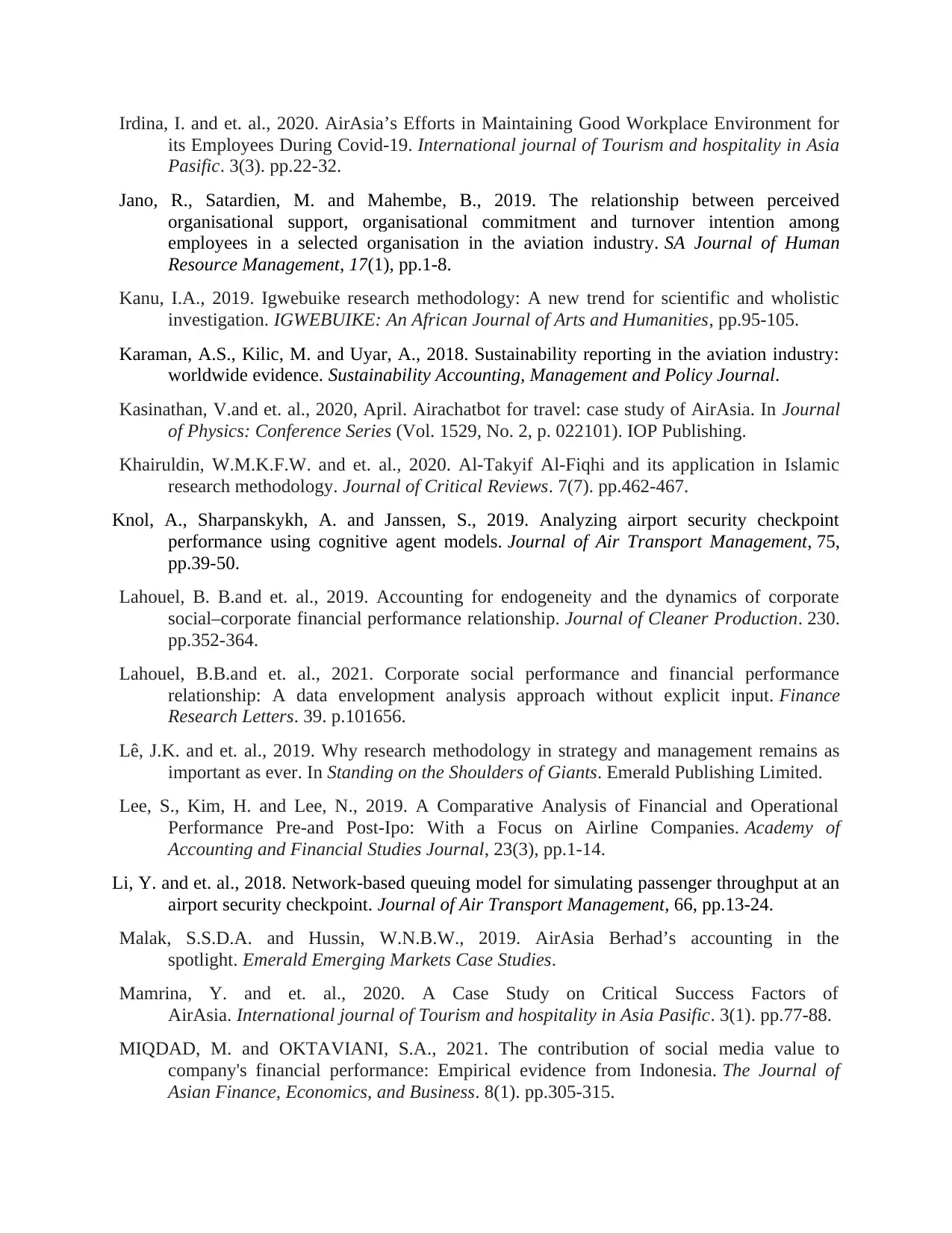
Irdina, I. and et. al., 2020. AirAsia’s Efforts in Maintaining Good Workplace Environment for
its Employees During Covid-19. International journal of Tourism and hospitality in Asia
Pasific. 3(3). pp.22-32.
Jano, R., Satardien, M. and Mahembe, B., 2019. The relationship between perceived
organisational support, organisational commitment and turnover intention among
employees in a selected organisation in the aviation industry. SA Journal of Human
Resource Management, 17(1), pp.1-8.
Kanu, I.A., 2019. Igwebuike research methodology: A new trend for scientific and wholistic
investigation. IGWEBUIKE: An African Journal of Arts and Humanities, pp.95-105.
Karaman, A.S., Kilic, M. and Uyar, A., 2018. Sustainability reporting in the aviation industry:
worldwide evidence. Sustainability Accounting, Management and Policy Journal.
Kasinathan, V.and et. al., 2020, April. Airachatbot for travel: case study of AirAsia. In Journal
of Physics: Conference Series (Vol. 1529, No. 2, p. 022101). IOP Publishing.
Khairuldin, W.M.K.F.W. and et. al., 2020. Al-Takyif Al-Fiqhi and its application in Islamic
research methodology. Journal of Critical Reviews. 7(7). pp.462-467.
Knol, A., Sharpanskykh, A. and Janssen, S., 2019. Analyzing airport security checkpoint
performance using cognitive agent models. Journal of Air Transport Management, 75,
pp.39-50.
Lahouel, B. B.and et. al., 2019. Accounting for endogeneity and the dynamics of corporate
social–corporate financial performance relationship. Journal of Cleaner Production. 230.
pp.352-364.
Lahouel, B.B.and et. al., 2021. Corporate social performance and financial performance
relationship: A data envelopment analysis approach without explicit input. Finance
Research Letters. 39. p.101656.
Lê, J.K. and et. al., 2019. Why research methodology in strategy and management remains as
important as ever. In Standing on the Shoulders of Giants. Emerald Publishing Limited.
Lee, S., Kim, H. and Lee, N., 2019. A Comparative Analysis of Financial and Operational
Performance Pre-and Post-Ipo: With a Focus on Airline Companies. Academy of
Accounting and Financial Studies Journal, 23(3), pp.1-14.
Li, Y. and et. al., 2018. Network-based queuing model for simulating passenger throughput at an
airport security checkpoint. Journal of Air Transport Management, 66, pp.13-24.
Malak, S.S.D.A. and Hussin, W.N.B.W., 2019. AirAsia Berhad’s accounting in the
spotlight. Emerald Emerging Markets Case Studies.
Mamrina, Y. and et. al., 2020. A Case Study on Critical Success Factors of
AirAsia. International journal of Tourism and hospitality in Asia Pasific. 3(1). pp.77-88.
MIQDAD, M. and OKTAVIANI, S.A., 2021. The contribution of social media value to
company's financial performance: Empirical evidence from Indonesia. The Journal of
Asian Finance, Economics, and Business. 8(1). pp.305-315.
its Employees During Covid-19. International journal of Tourism and hospitality in Asia
Pasific. 3(3). pp.22-32.
Jano, R., Satardien, M. and Mahembe, B., 2019. The relationship between perceived
organisational support, organisational commitment and turnover intention among
employees in a selected organisation in the aviation industry. SA Journal of Human
Resource Management, 17(1), pp.1-8.
Kanu, I.A., 2019. Igwebuike research methodology: A new trend for scientific and wholistic
investigation. IGWEBUIKE: An African Journal of Arts and Humanities, pp.95-105.
Karaman, A.S., Kilic, M. and Uyar, A., 2018. Sustainability reporting in the aviation industry:
worldwide evidence. Sustainability Accounting, Management and Policy Journal.
Kasinathan, V.and et. al., 2020, April. Airachatbot for travel: case study of AirAsia. In Journal
of Physics: Conference Series (Vol. 1529, No. 2, p. 022101). IOP Publishing.
Khairuldin, W.M.K.F.W. and et. al., 2020. Al-Takyif Al-Fiqhi and its application in Islamic
research methodology. Journal of Critical Reviews. 7(7). pp.462-467.
Knol, A., Sharpanskykh, A. and Janssen, S., 2019. Analyzing airport security checkpoint
performance using cognitive agent models. Journal of Air Transport Management, 75,
pp.39-50.
Lahouel, B. B.and et. al., 2019. Accounting for endogeneity and the dynamics of corporate
social–corporate financial performance relationship. Journal of Cleaner Production. 230.
pp.352-364.
Lahouel, B.B.and et. al., 2021. Corporate social performance and financial performance
relationship: A data envelopment analysis approach without explicit input. Finance
Research Letters. 39. p.101656.
Lê, J.K. and et. al., 2019. Why research methodology in strategy and management remains as
important as ever. In Standing on the Shoulders of Giants. Emerald Publishing Limited.
Lee, S., Kim, H. and Lee, N., 2019. A Comparative Analysis of Financial and Operational
Performance Pre-and Post-Ipo: With a Focus on Airline Companies. Academy of
Accounting and Financial Studies Journal, 23(3), pp.1-14.
Li, Y. and et. al., 2018. Network-based queuing model for simulating passenger throughput at an
airport security checkpoint. Journal of Air Transport Management, 66, pp.13-24.
Malak, S.S.D.A. and Hussin, W.N.B.W., 2019. AirAsia Berhad’s accounting in the
spotlight. Emerald Emerging Markets Case Studies.
Mamrina, Y. and et. al., 2020. A Case Study on Critical Success Factors of
AirAsia. International journal of Tourism and hospitality in Asia Pasific. 3(1). pp.77-88.
MIQDAD, M. and OKTAVIANI, S.A., 2021. The contribution of social media value to
company's financial performance: Empirical evidence from Indonesia. The Journal of
Asian Finance, Economics, and Business. 8(1). pp.305-315.
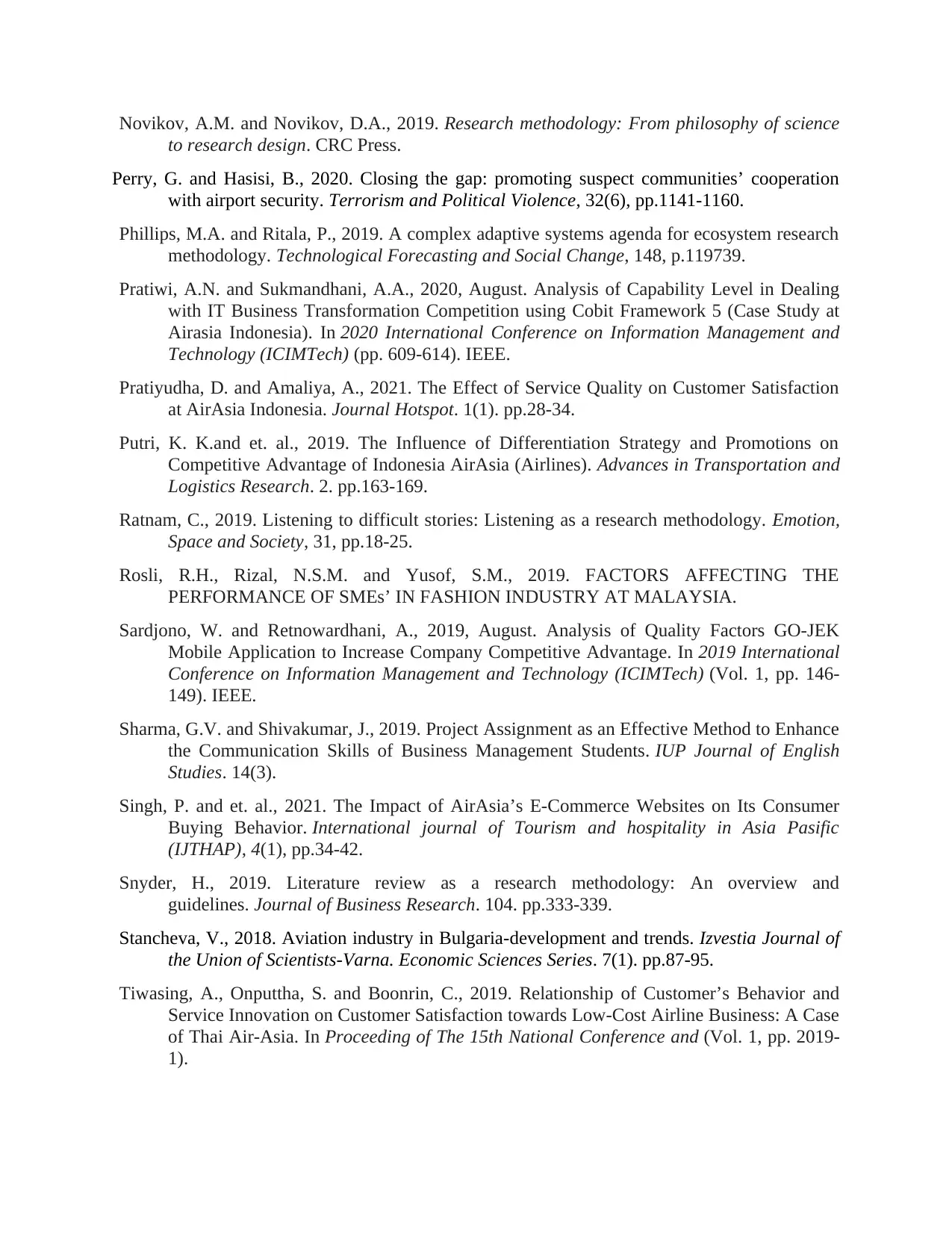
Novikov, A.M. and Novikov, D.A., 2019. Research methodology: From philosophy of science
to research design. CRC Press.
Perry, G. and Hasisi, B., 2020. Closing the gap: promoting suspect communities’ cooperation
with airport security. Terrorism and Political Violence, 32(6), pp.1141-1160.
Phillips, M.A. and Ritala, P., 2019. A complex adaptive systems agenda for ecosystem research
methodology. Technological Forecasting and Social Change, 148, p.119739.
Pratiwi, A.N. and Sukmandhani, A.A., 2020, August. Analysis of Capability Level in Dealing
with IT Business Transformation Competition using Cobit Framework 5 (Case Study at
Airasia Indonesia). In 2020 International Conference on Information Management and
Technology (ICIMTech) (pp. 609-614). IEEE.
Pratiyudha, D. and Amaliya, A., 2021. The Effect of Service Quality on Customer Satisfaction
at AirAsia Indonesia. Journal Hotspot. 1(1). pp.28-34.
Putri, K. K.and et. al., 2019. The Influence of Differentiation Strategy and Promotions on
Competitive Advantage of Indonesia AirAsia (Airlines). Advances in Transportation and
Logistics Research. 2. pp.163-169.
Ratnam, C., 2019. Listening to difficult stories: Listening as a research methodology. Emotion,
Space and Society, 31, pp.18-25.
Rosli, R.H., Rizal, N.S.M. and Yusof, S.M., 2019. FACTORS AFFECTING THE
PERFORMANCE OF SMEs’ IN FASHION INDUSTRY AT MALAYSIA.
Sardjono, W. and Retnowardhani, A., 2019, August. Analysis of Quality Factors GO-JEK
Mobile Application to Increase Company Competitive Advantage. In 2019 International
Conference on Information Management and Technology (ICIMTech) (Vol. 1, pp. 146-
149). IEEE.
Sharma, G.V. and Shivakumar, J., 2019. Project Assignment as an Effective Method to Enhance
the Communication Skills of Business Management Students. IUP Journal of English
Studies. 14(3).
Singh, P. and et. al., 2021. The Impact of AirAsia’s E-Commerce Websites on Its Consumer
Buying Behavior. International journal of Tourism and hospitality in Asia Pasific
(IJTHAP), 4(1), pp.34-42.
Snyder, H., 2019. Literature review as a research methodology: An overview and
guidelines. Journal of Business Research. 104. pp.333-339.
Stancheva, V., 2018. Aviation industry in Bulgaria-development and trends. Izvestia Journal of
the Union of Scientists-Varna. Economic Sciences Series. 7(1). pp.87-95.
Tiwasing, A., Onputtha, S. and Boonrin, C., 2019. Relationship of Customer’s Behavior and
Service Innovation on Customer Satisfaction towards Low-Cost Airline Business: A Case
of Thai Air-Asia. In Proceeding of The 15th National Conference and (Vol. 1, pp. 2019-
1).
to research design. CRC Press.
Perry, G. and Hasisi, B., 2020. Closing the gap: promoting suspect communities’ cooperation
with airport security. Terrorism and Political Violence, 32(6), pp.1141-1160.
Phillips, M.A. and Ritala, P., 2019. A complex adaptive systems agenda for ecosystem research
methodology. Technological Forecasting and Social Change, 148, p.119739.
Pratiwi, A.N. and Sukmandhani, A.A., 2020, August. Analysis of Capability Level in Dealing
with IT Business Transformation Competition using Cobit Framework 5 (Case Study at
Airasia Indonesia). In 2020 International Conference on Information Management and
Technology (ICIMTech) (pp. 609-614). IEEE.
Pratiyudha, D. and Amaliya, A., 2021. The Effect of Service Quality on Customer Satisfaction
at AirAsia Indonesia. Journal Hotspot. 1(1). pp.28-34.
Putri, K. K.and et. al., 2019. The Influence of Differentiation Strategy and Promotions on
Competitive Advantage of Indonesia AirAsia (Airlines). Advances in Transportation and
Logistics Research. 2. pp.163-169.
Ratnam, C., 2019. Listening to difficult stories: Listening as a research methodology. Emotion,
Space and Society, 31, pp.18-25.
Rosli, R.H., Rizal, N.S.M. and Yusof, S.M., 2019. FACTORS AFFECTING THE
PERFORMANCE OF SMEs’ IN FASHION INDUSTRY AT MALAYSIA.
Sardjono, W. and Retnowardhani, A., 2019, August. Analysis of Quality Factors GO-JEK
Mobile Application to Increase Company Competitive Advantage. In 2019 International
Conference on Information Management and Technology (ICIMTech) (Vol. 1, pp. 146-
149). IEEE.
Sharma, G.V. and Shivakumar, J., 2019. Project Assignment as an Effective Method to Enhance
the Communication Skills of Business Management Students. IUP Journal of English
Studies. 14(3).
Singh, P. and et. al., 2021. The Impact of AirAsia’s E-Commerce Websites on Its Consumer
Buying Behavior. International journal of Tourism and hospitality in Asia Pasific
(IJTHAP), 4(1), pp.34-42.
Snyder, H., 2019. Literature review as a research methodology: An overview and
guidelines. Journal of Business Research. 104. pp.333-339.
Stancheva, V., 2018. Aviation industry in Bulgaria-development and trends. Izvestia Journal of
the Union of Scientists-Varna. Economic Sciences Series. 7(1). pp.87-95.
Tiwasing, A., Onputtha, S. and Boonrin, C., 2019. Relationship of Customer’s Behavior and
Service Innovation on Customer Satisfaction towards Low-Cost Airline Business: A Case
of Thai Air-Asia. In Proceeding of The 15th National Conference and (Vol. 1, pp. 2019-
1).
Paraphrase This Document
Need a fresh take? Get an instant paraphrase of this document with our AI Paraphraser
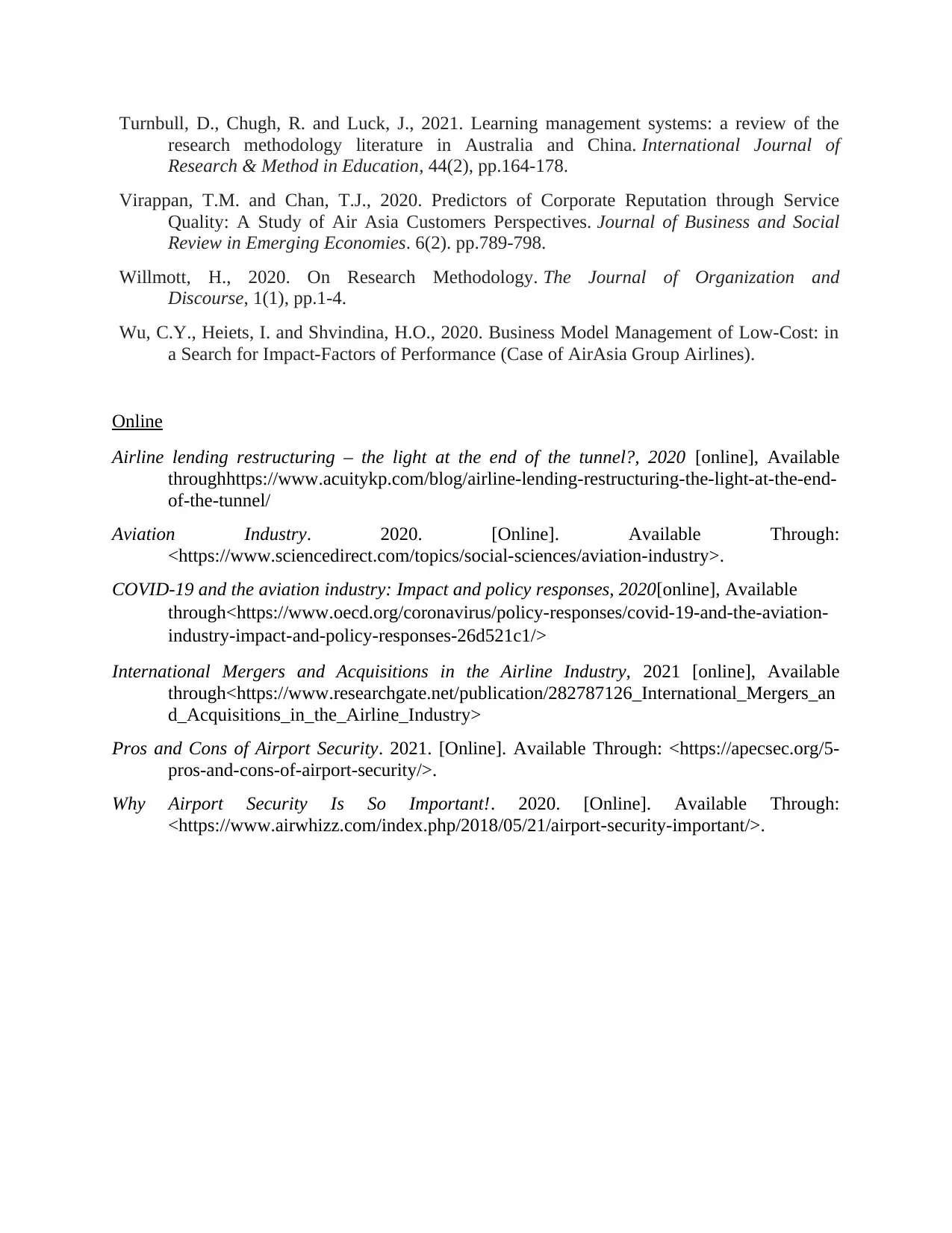
Turnbull, D., Chugh, R. and Luck, J., 2021. Learning management systems: a review of the
research methodology literature in Australia and China. International Journal of
Research & Method in Education, 44(2), pp.164-178.
Virappan, T.M. and Chan, T.J., 2020. Predictors of Corporate Reputation through Service
Quality: A Study of Air Asia Customers Perspectives. Journal of Business and Social
Review in Emerging Economies. 6(2). pp.789-798.
Willmott, H., 2020. On Research Methodology. The Journal of Organization and
Discourse, 1(1), pp.1-4.
Wu, C.Y., Heiets, I. and Shvindina, H.O., 2020. Business Model Management of Low-Cost: in
a Search for Impact-Factors of Performance (Case of AirAsia Group Airlines).
Online
Airline lending restructuring – the light at the end of the tunnel?, 2020 [online], Available
throughhttps://www.acuitykp.com/blog/airline-lending-restructuring-the-light-at-the-end-
of-the-tunnel/
Aviation Industry. 2020. [Online]. Available Through:
<https://www.sciencedirect.com/topics/social-sciences/aviation-industry>.
COVID-19 and the aviation industry: Impact and policy responses, 2020[online], Available
through<https://www.oecd.org/coronavirus/policy-responses/covid-19-and-the-aviation-
industry-impact-and-policy-responses-26d521c1/>
International Mergers and Acquisitions in the Airline Industry, 2021 [online], Available
through<https://www.researchgate.net/publication/282787126_International_Mergers_an
d_Acquisitions_in_the_Airline_Industry>
Pros and Cons of Airport Security. 2021. [Online]. Available Through: <https://apecsec.org/5-
pros-and-cons-of-airport-security/>.
Why Airport Security Is So Important!. 2020. [Online]. Available Through:
<https://www.airwhizz.com/index.php/2018/05/21/airport-security-important/>.
research methodology literature in Australia and China. International Journal of
Research & Method in Education, 44(2), pp.164-178.
Virappan, T.M. and Chan, T.J., 2020. Predictors of Corporate Reputation through Service
Quality: A Study of Air Asia Customers Perspectives. Journal of Business and Social
Review in Emerging Economies. 6(2). pp.789-798.
Willmott, H., 2020. On Research Methodology. The Journal of Organization and
Discourse, 1(1), pp.1-4.
Wu, C.Y., Heiets, I. and Shvindina, H.O., 2020. Business Model Management of Low-Cost: in
a Search for Impact-Factors of Performance (Case of AirAsia Group Airlines).
Online
Airline lending restructuring – the light at the end of the tunnel?, 2020 [online], Available
throughhttps://www.acuitykp.com/blog/airline-lending-restructuring-the-light-at-the-end-
of-the-tunnel/
Aviation Industry. 2020. [Online]. Available Through:
<https://www.sciencedirect.com/topics/social-sciences/aviation-industry>.
COVID-19 and the aviation industry: Impact and policy responses, 2020[online], Available
through<https://www.oecd.org/coronavirus/policy-responses/covid-19-and-the-aviation-
industry-impact-and-policy-responses-26d521c1/>
International Mergers and Acquisitions in the Airline Industry, 2021 [online], Available
through<https://www.researchgate.net/publication/282787126_International_Mergers_an
d_Acquisitions_in_the_Airline_Industry>
Pros and Cons of Airport Security. 2021. [Online]. Available Through: <https://apecsec.org/5-
pros-and-cons-of-airport-security/>.
Why Airport Security Is So Important!. 2020. [Online]. Available Through:
<https://www.airwhizz.com/index.php/2018/05/21/airport-security-important/>.
1 out of 44
Your All-in-One AI-Powered Toolkit for Academic Success.
+13062052269
info@desklib.com
Available 24*7 on WhatsApp / Email
![[object Object]](/_next/static/media/star-bottom.7253800d.svg)
Unlock your academic potential
© 2024 | Zucol Services PVT LTD | All rights reserved.

